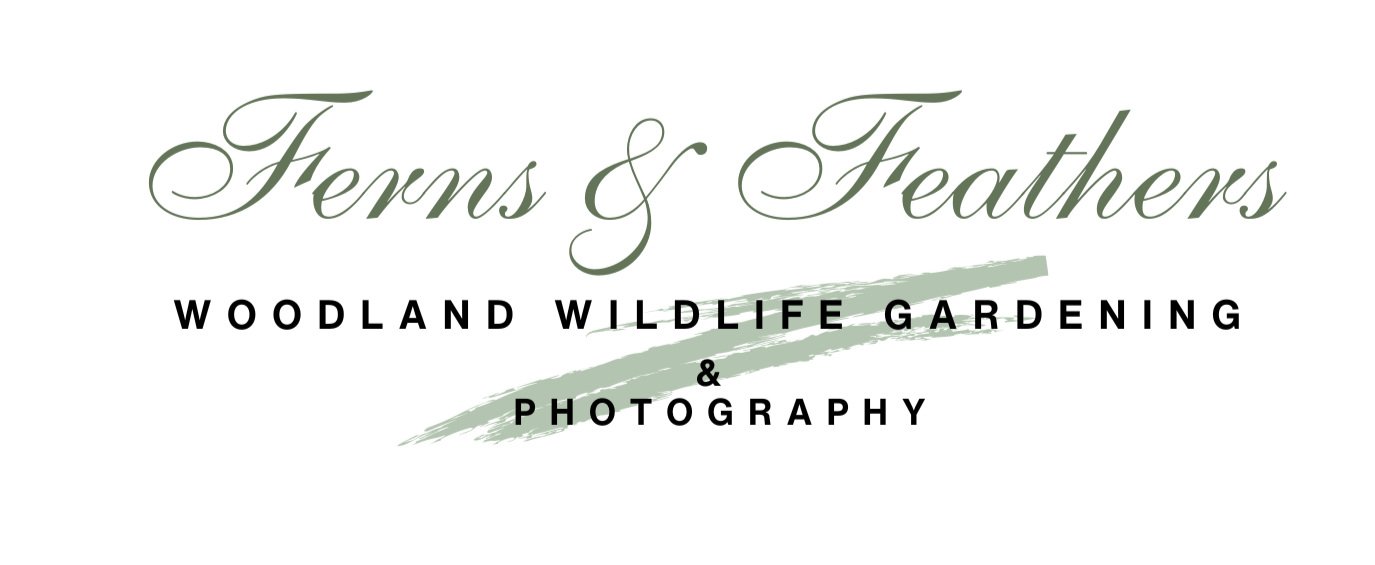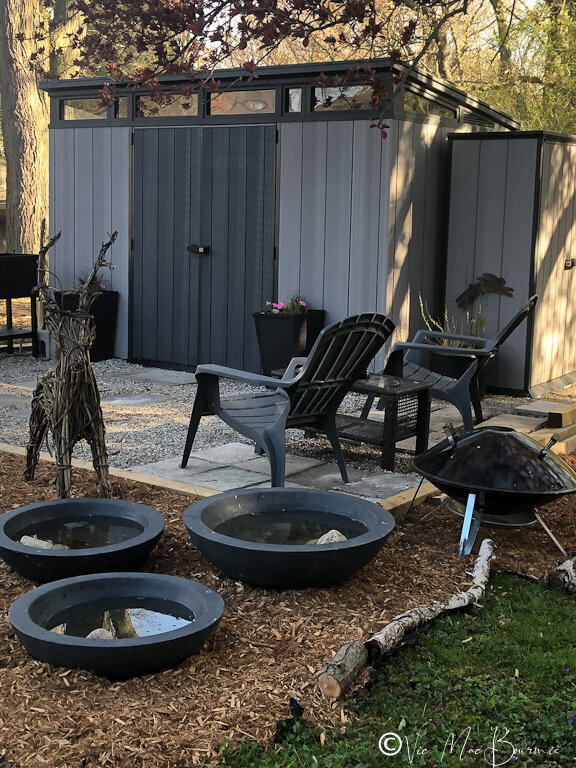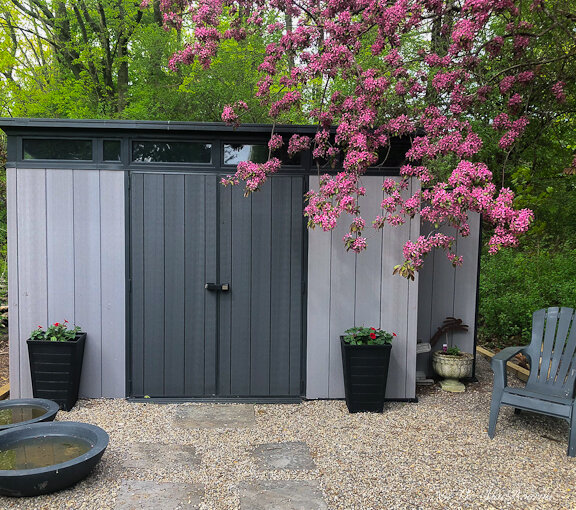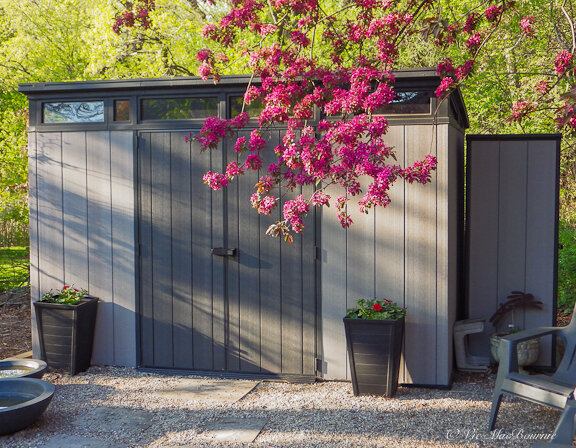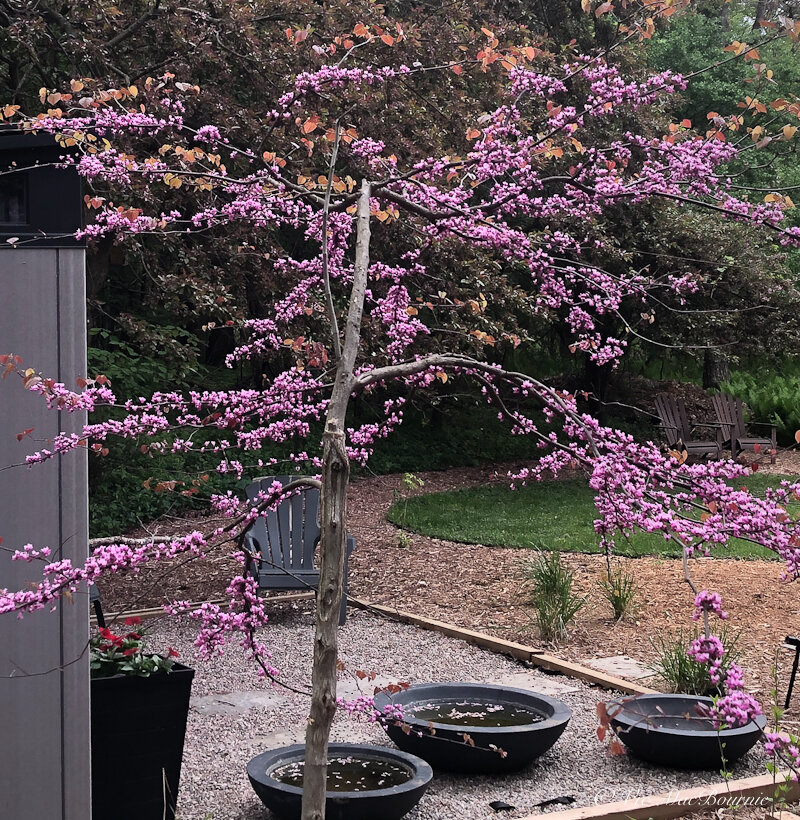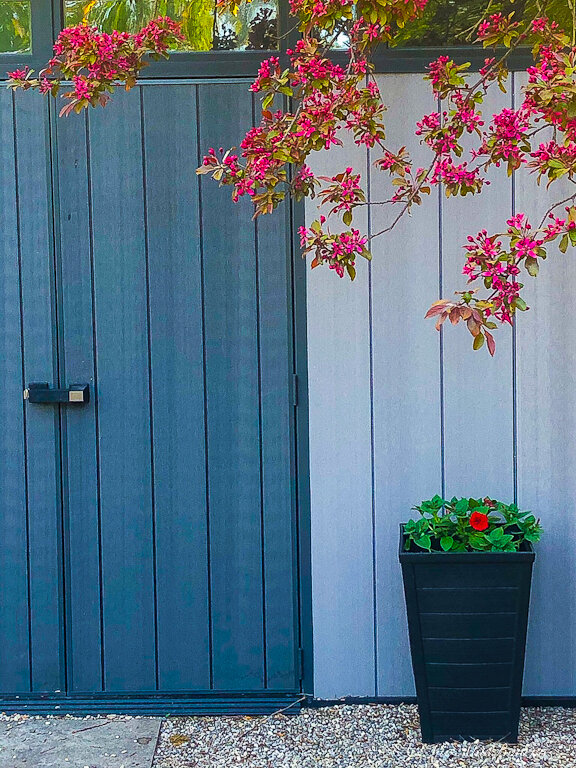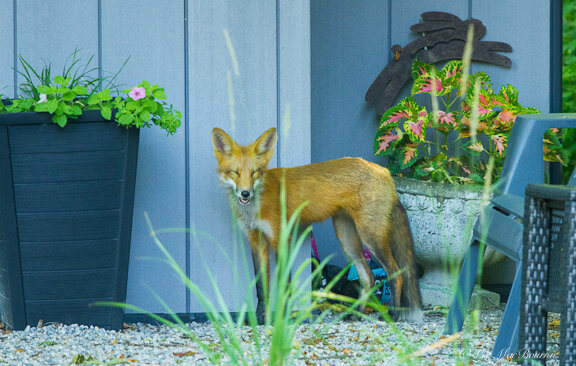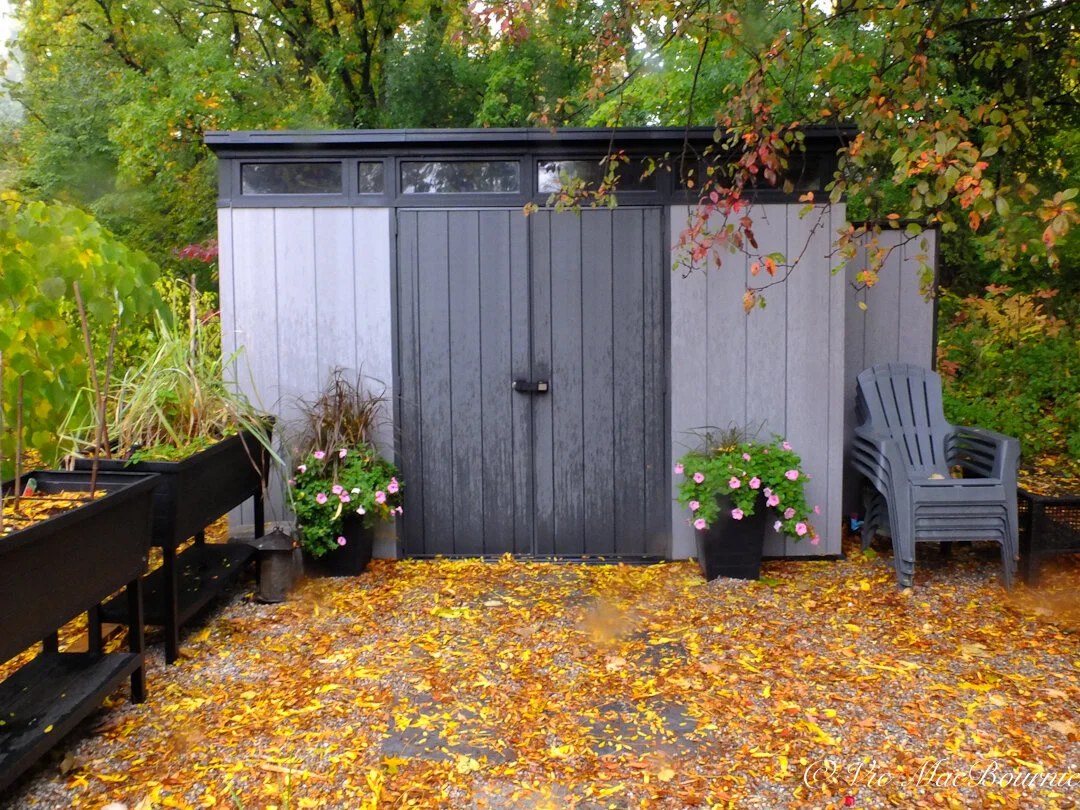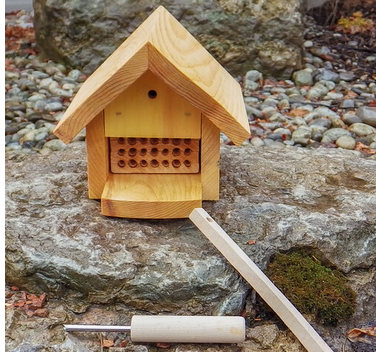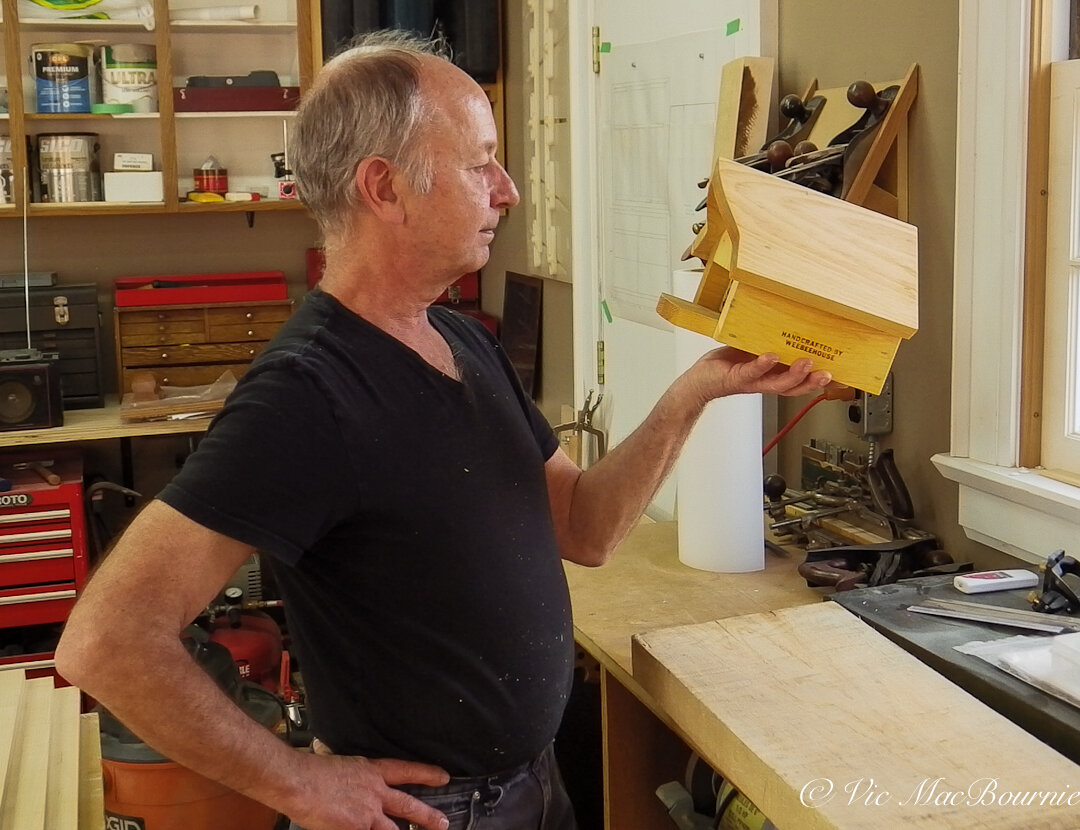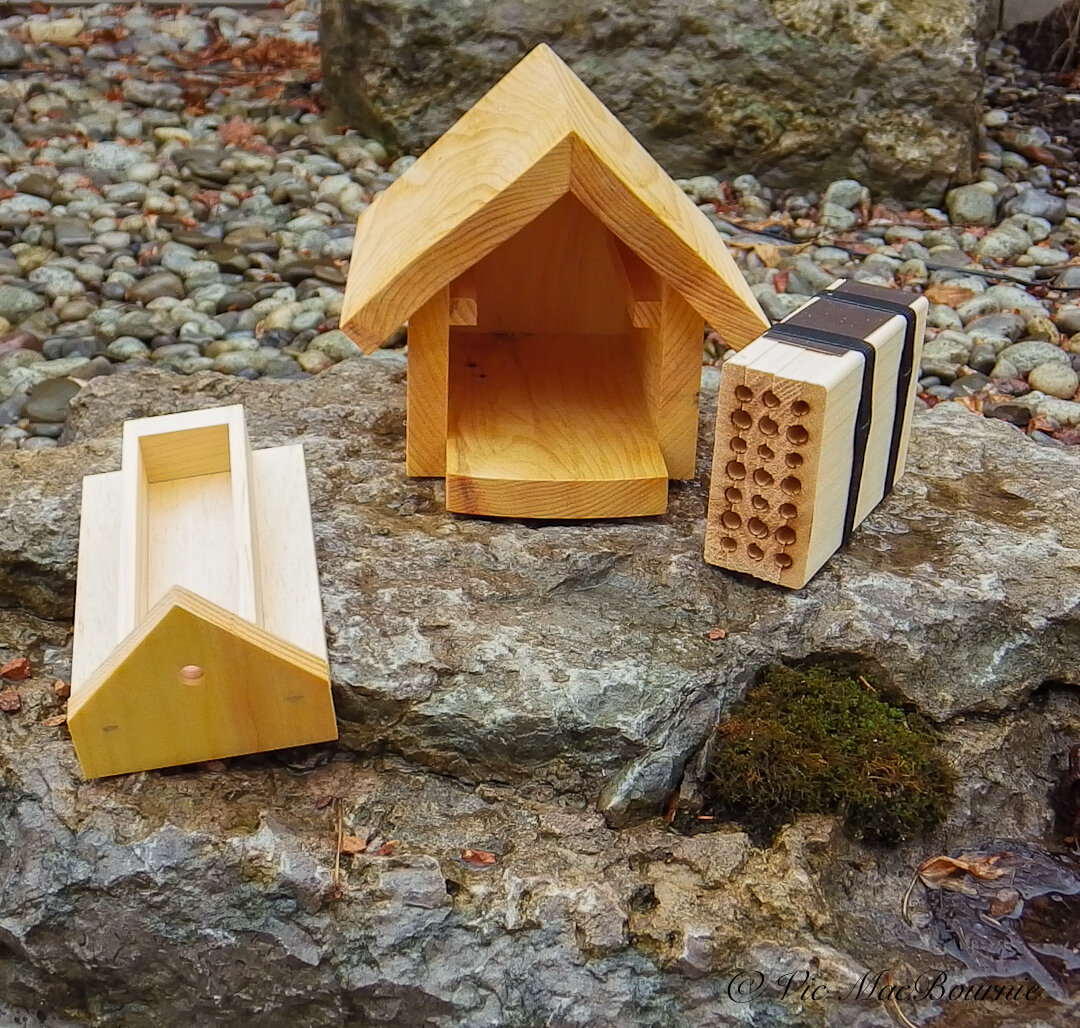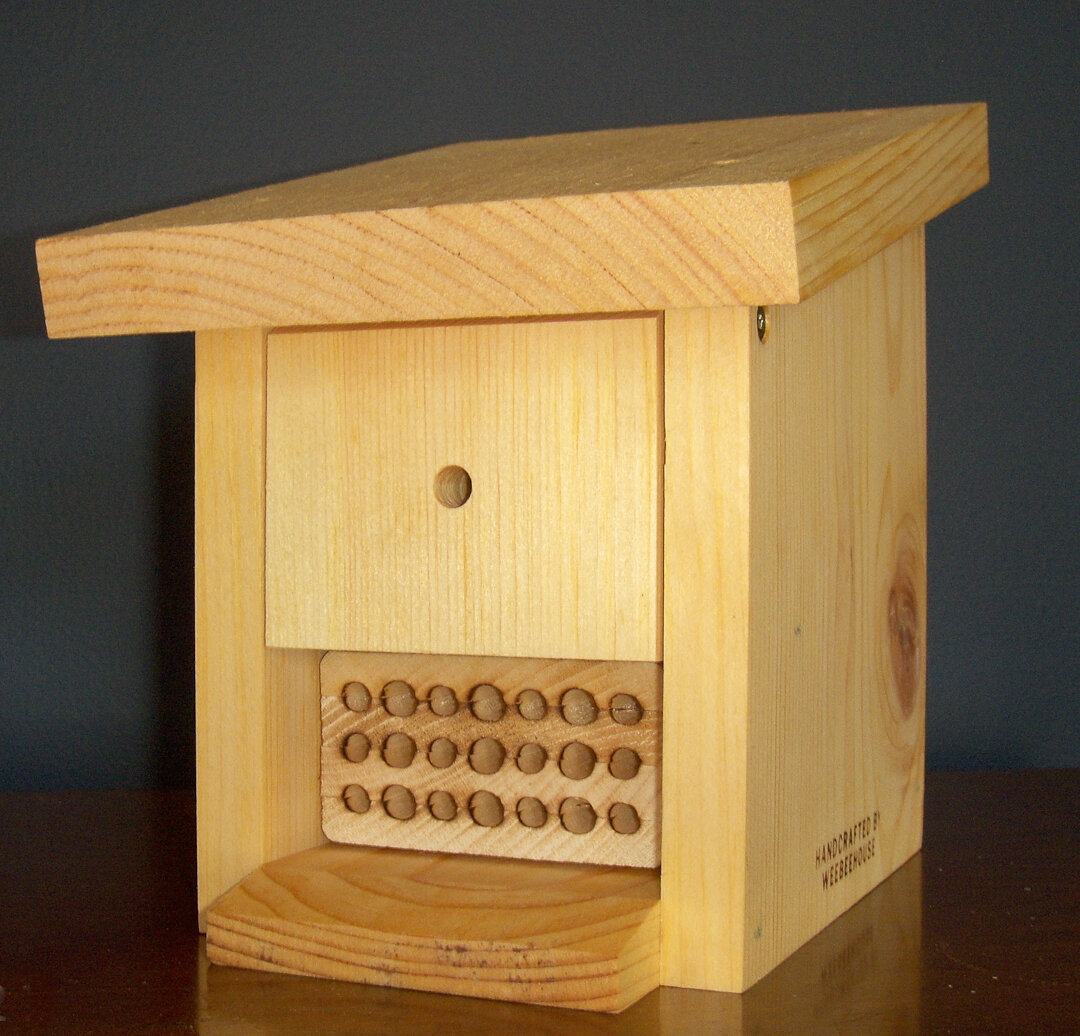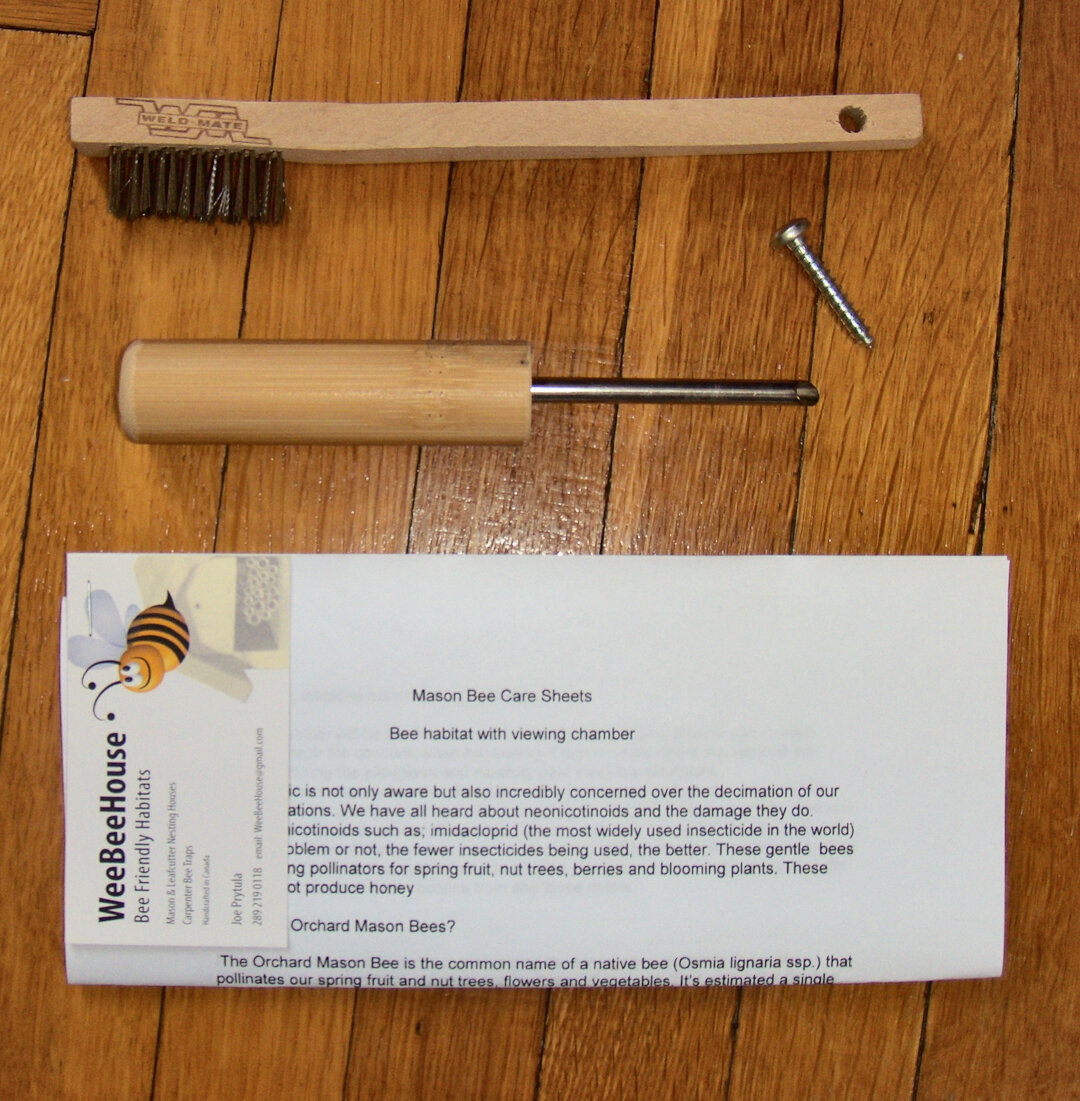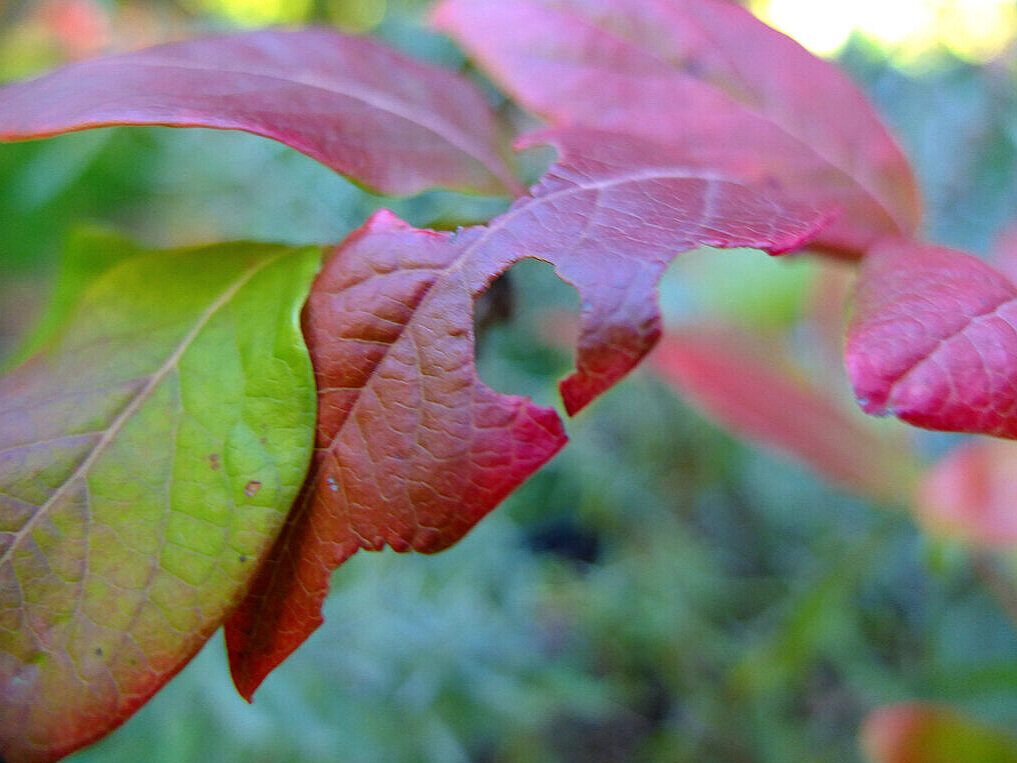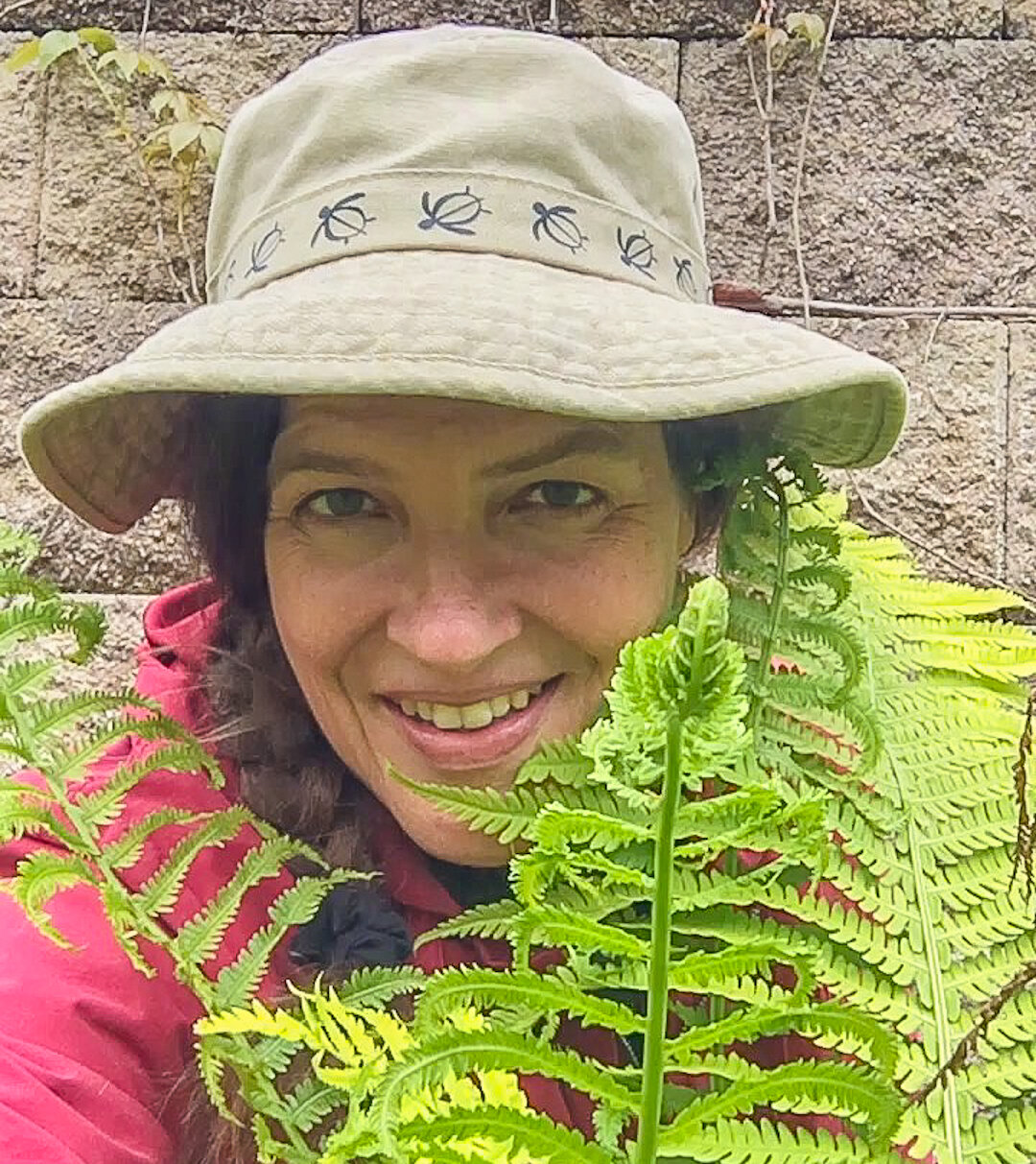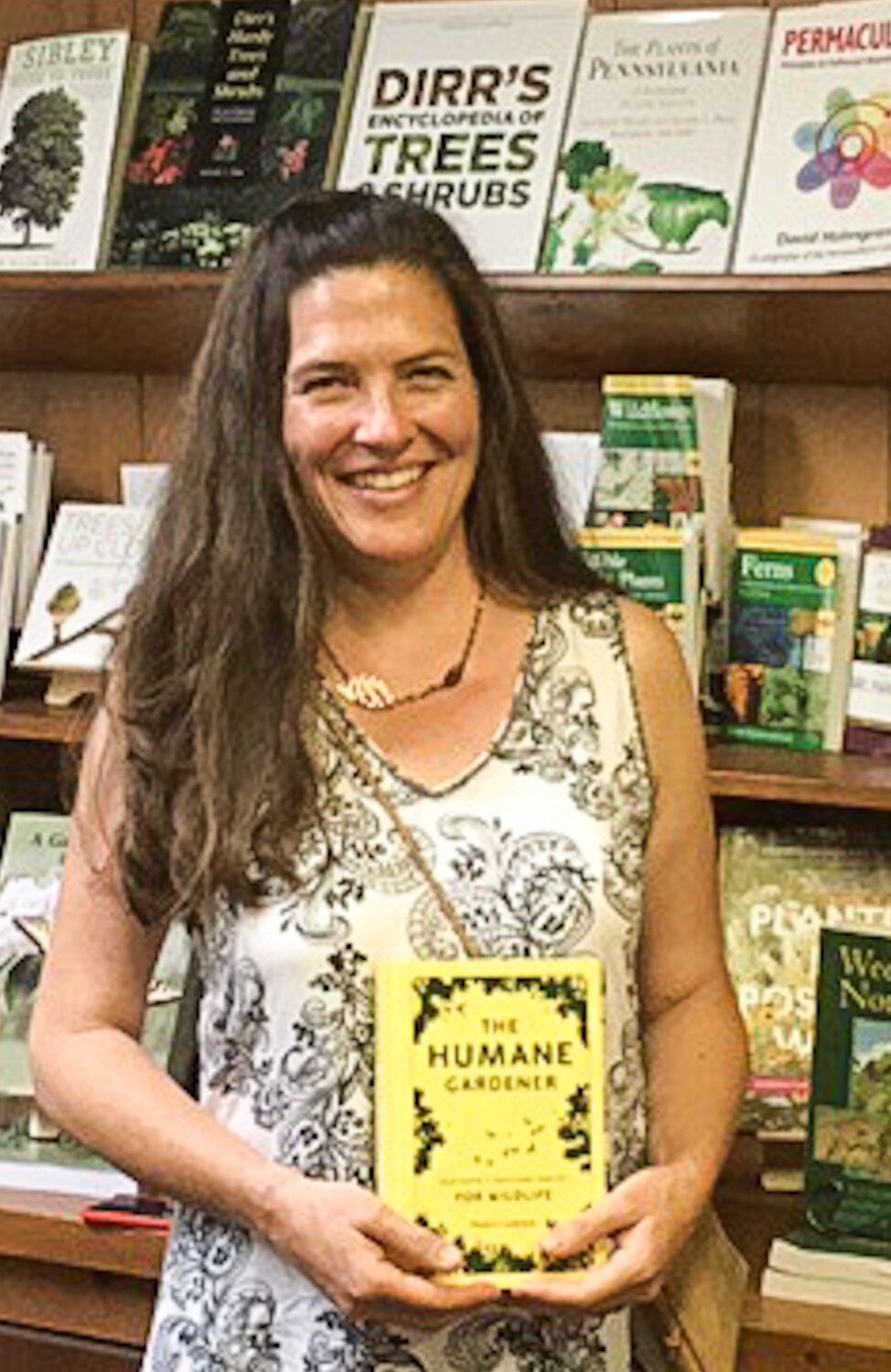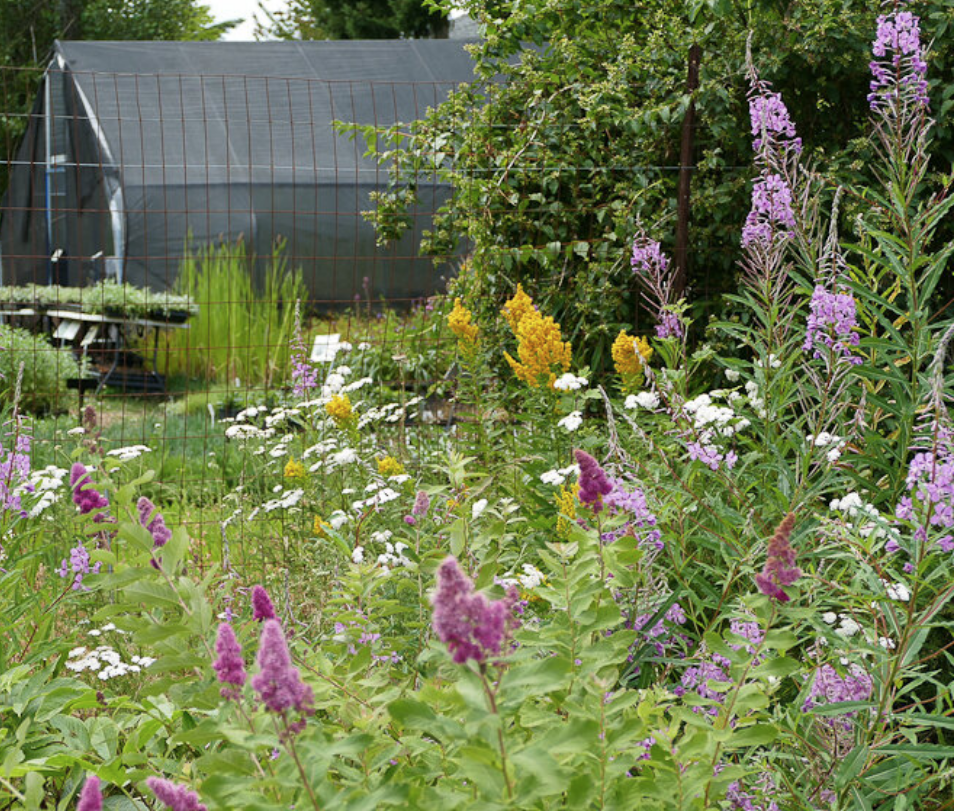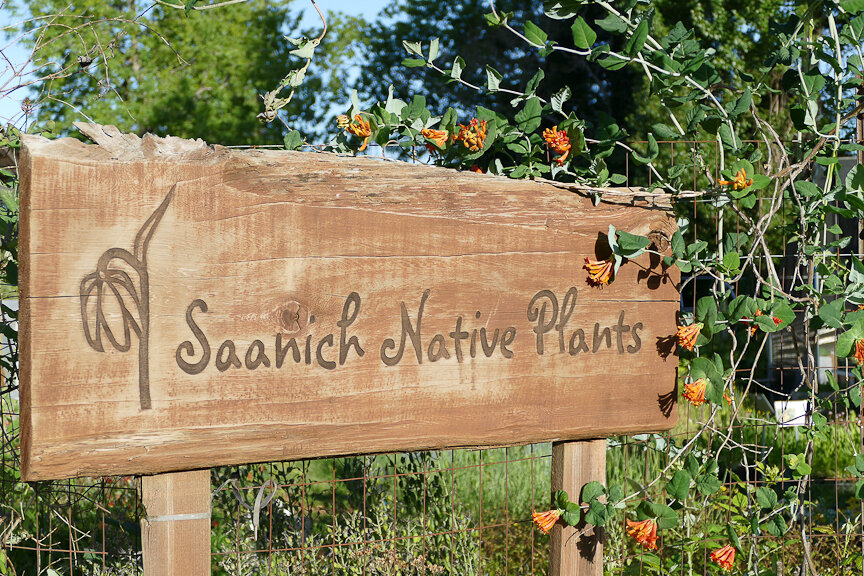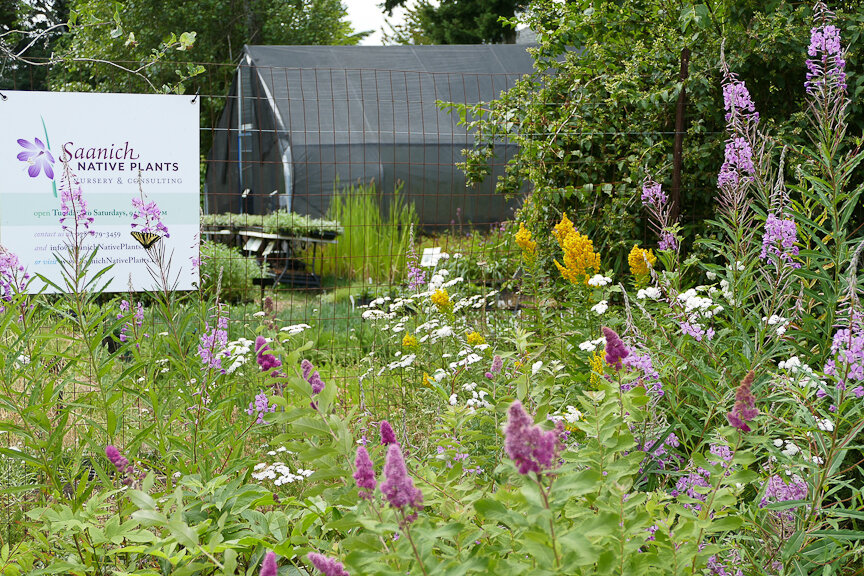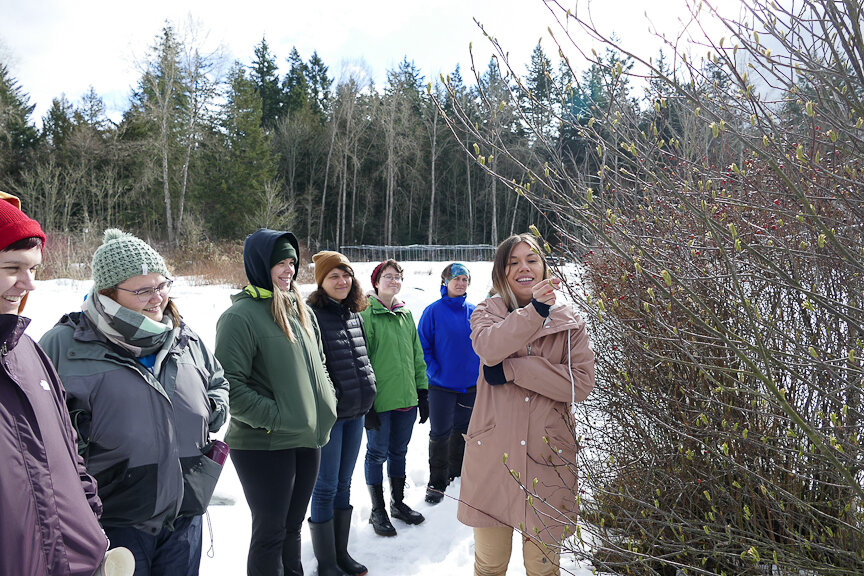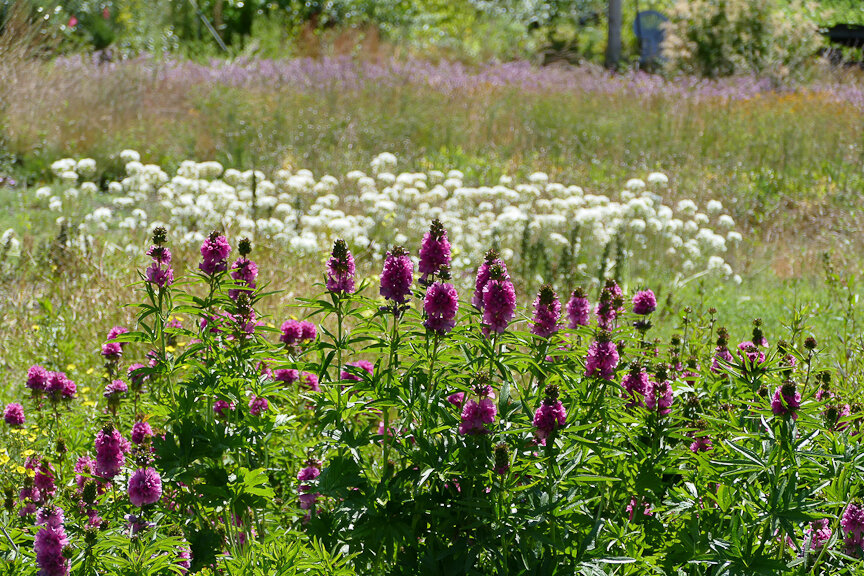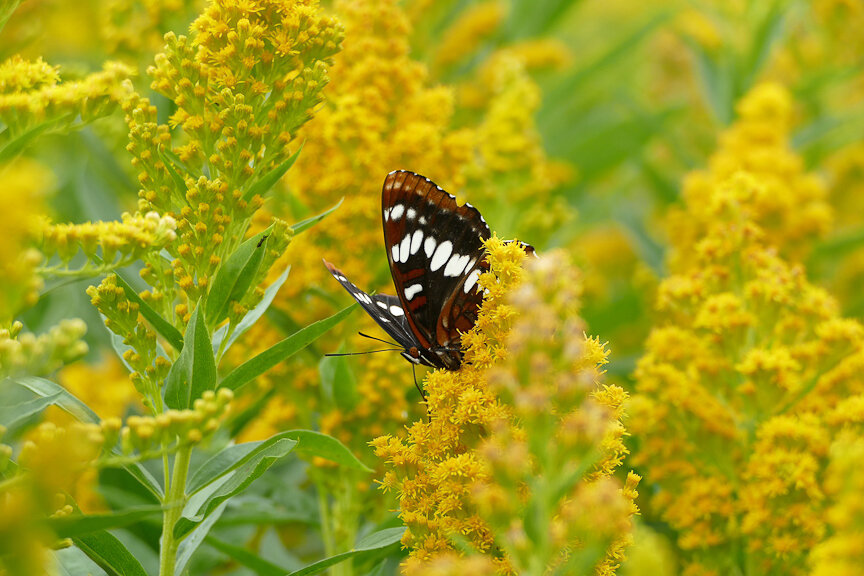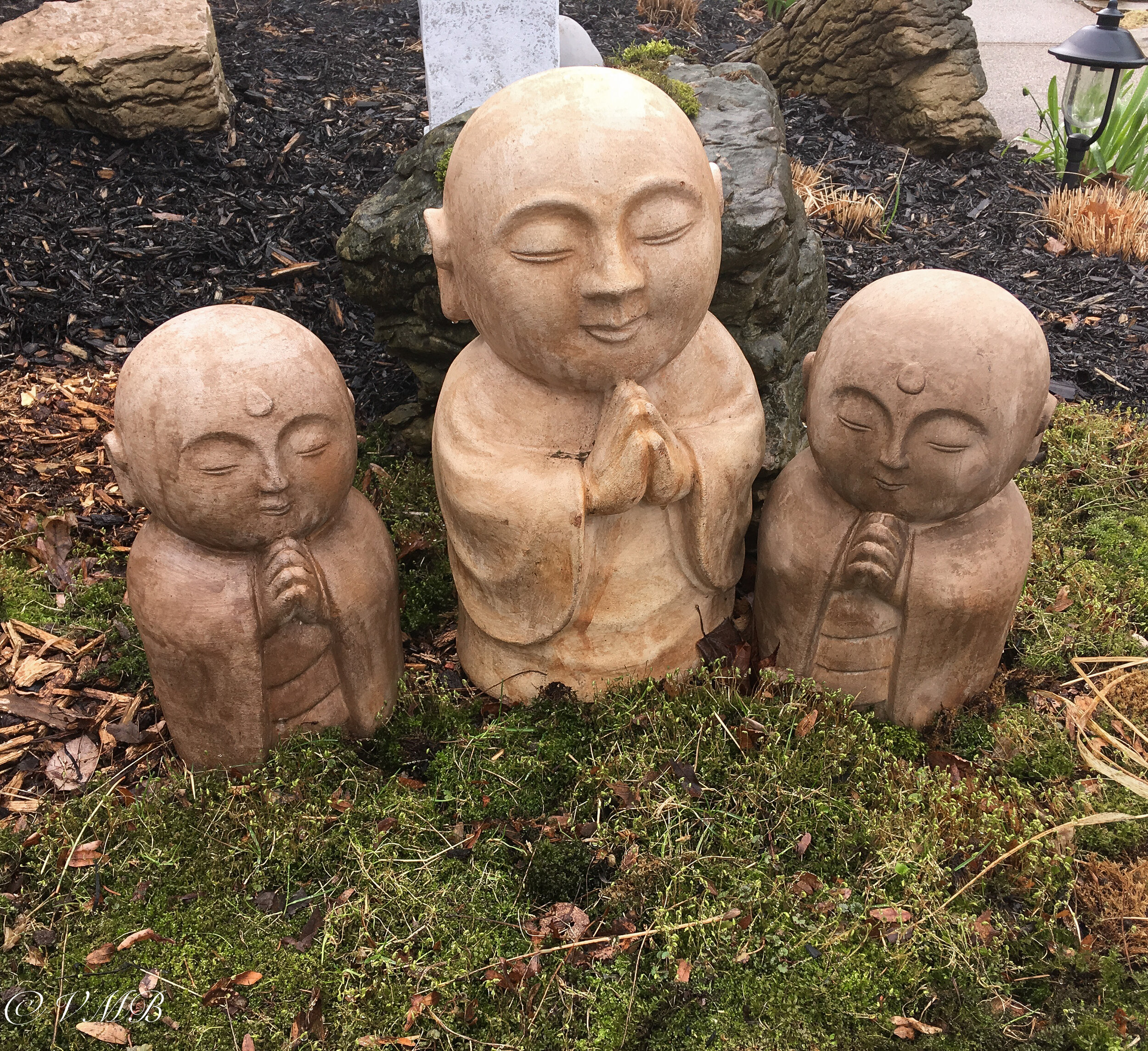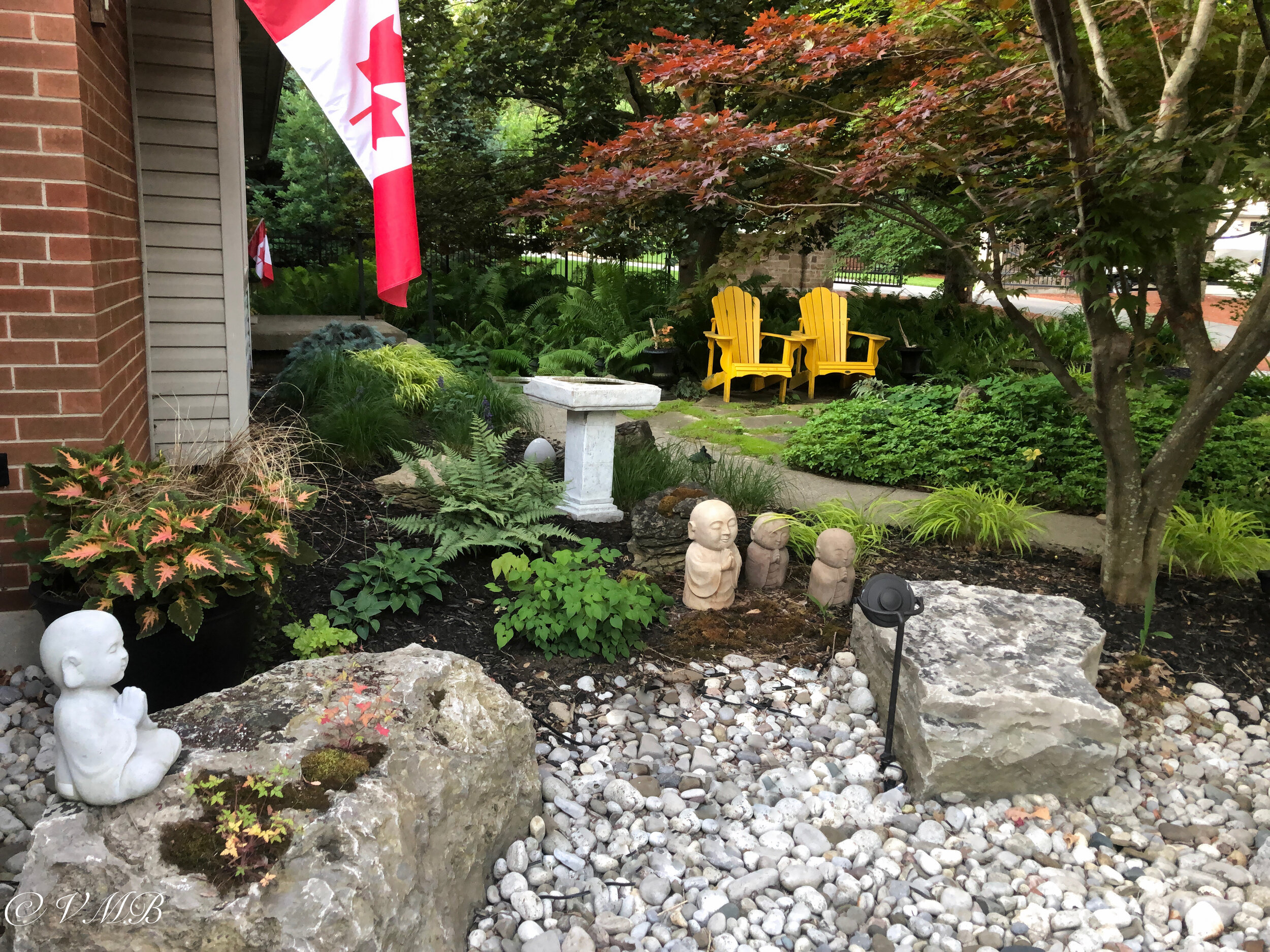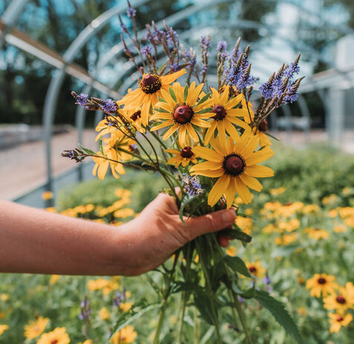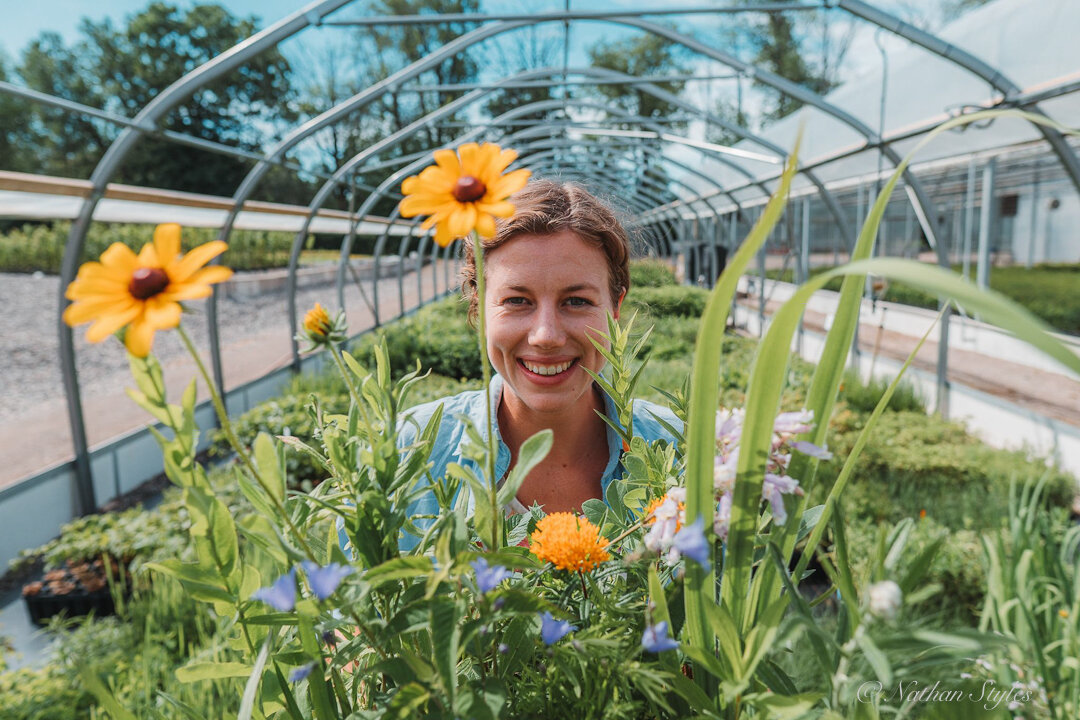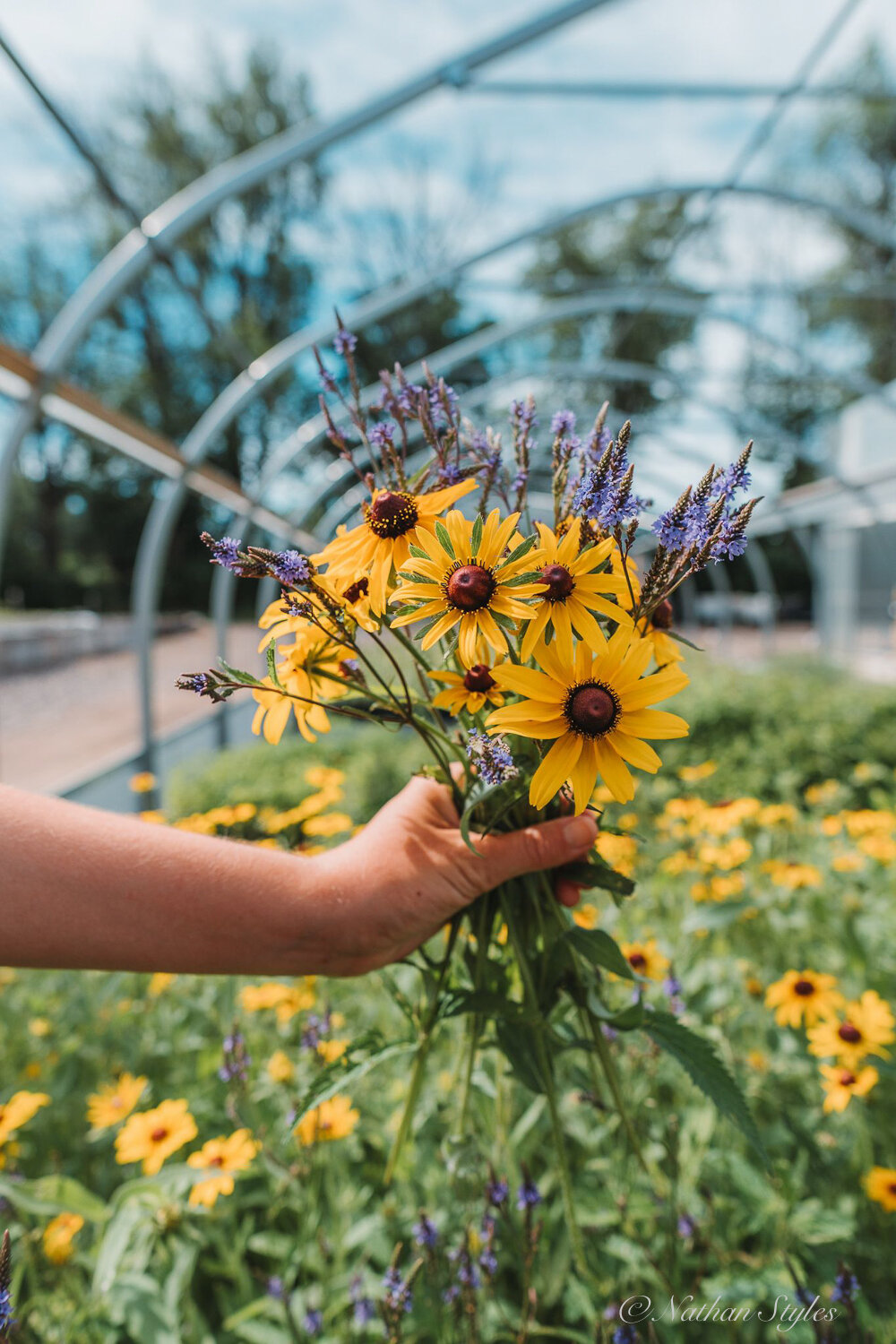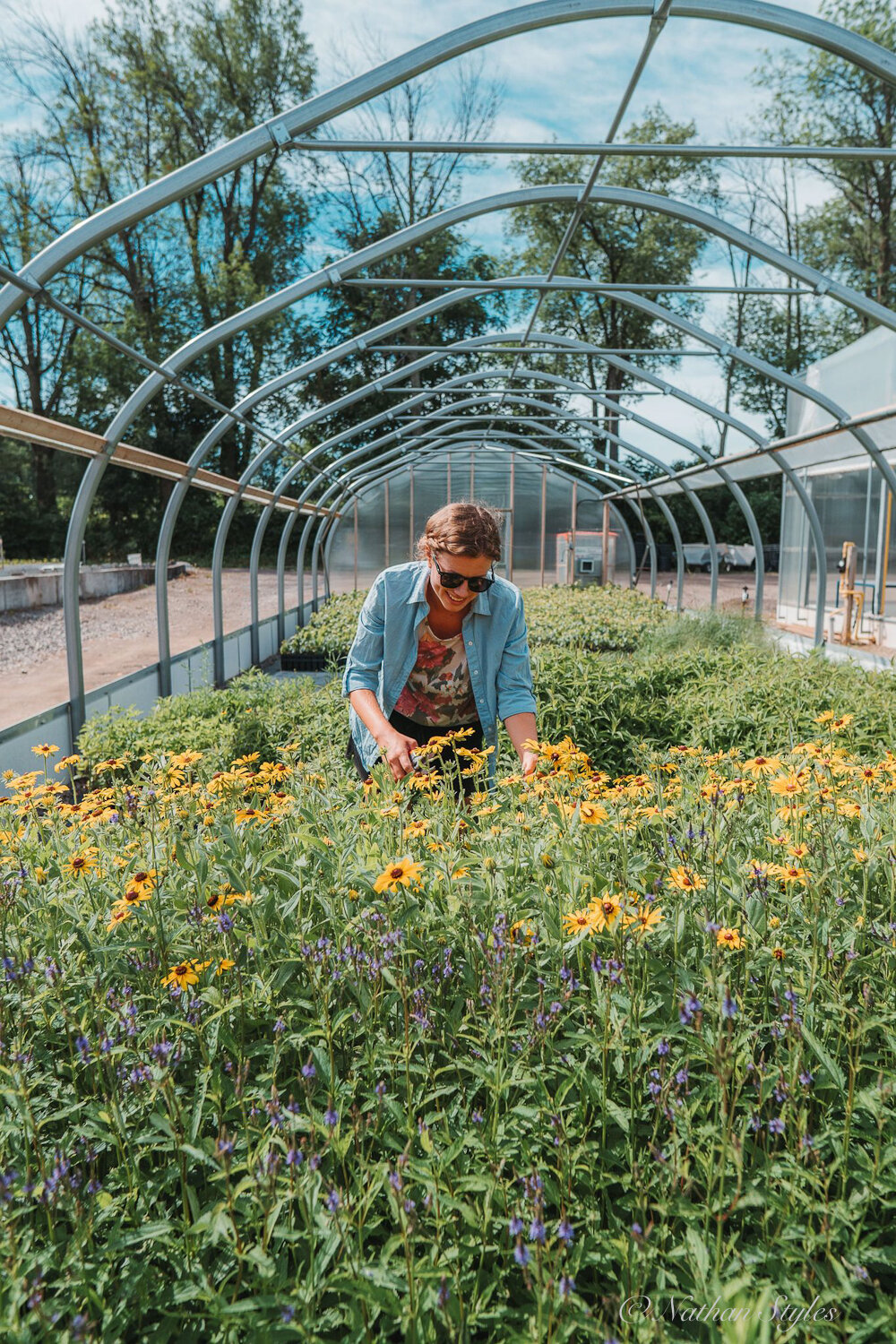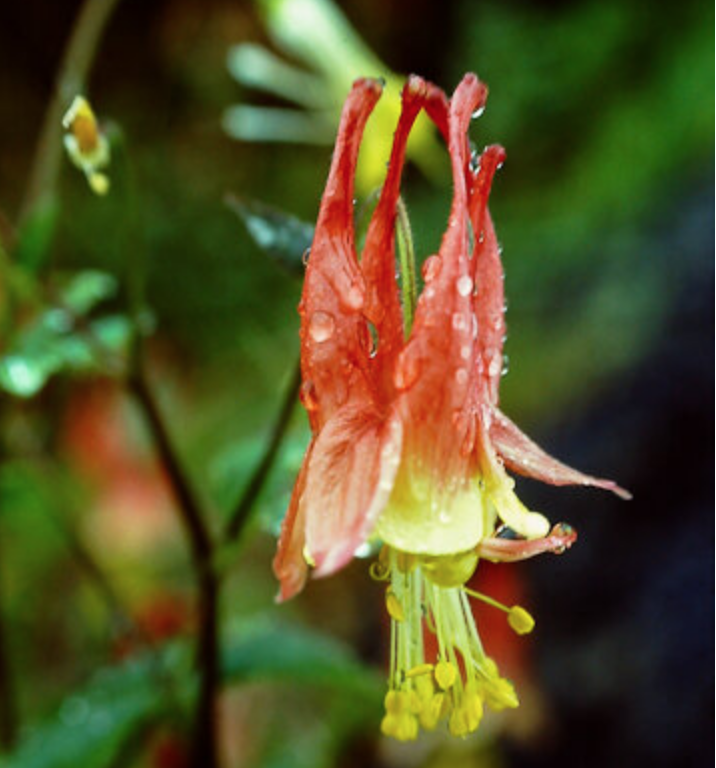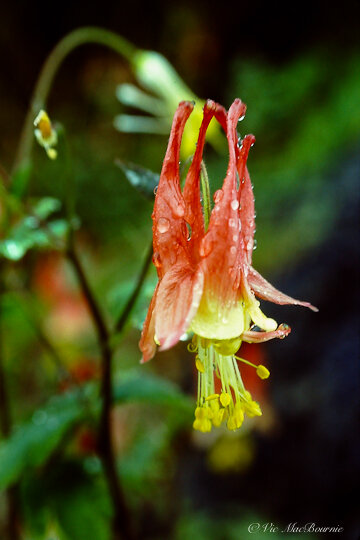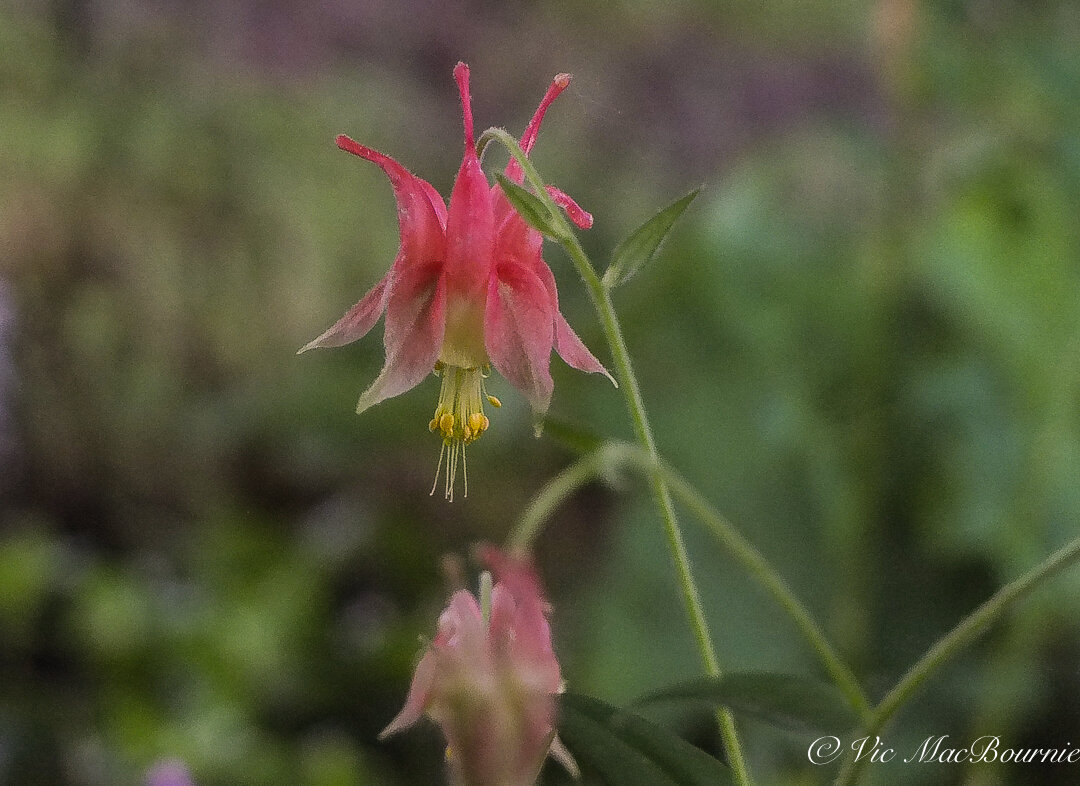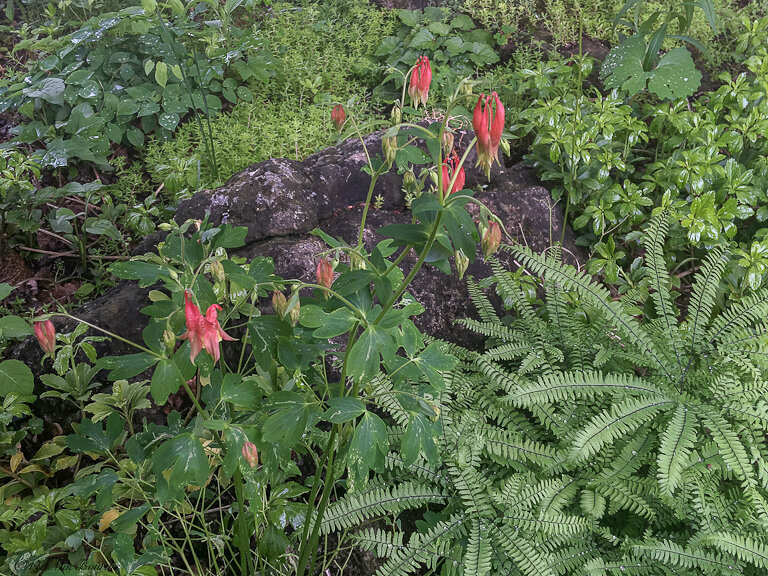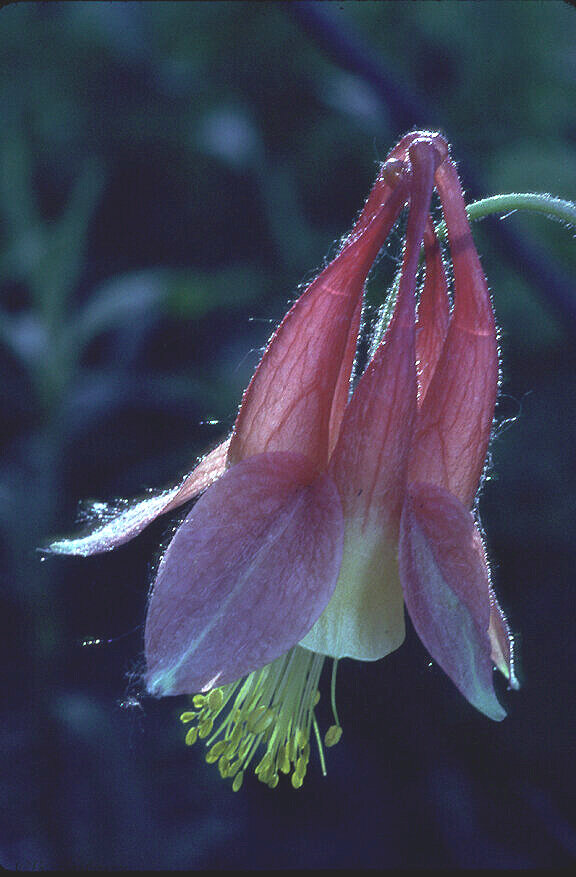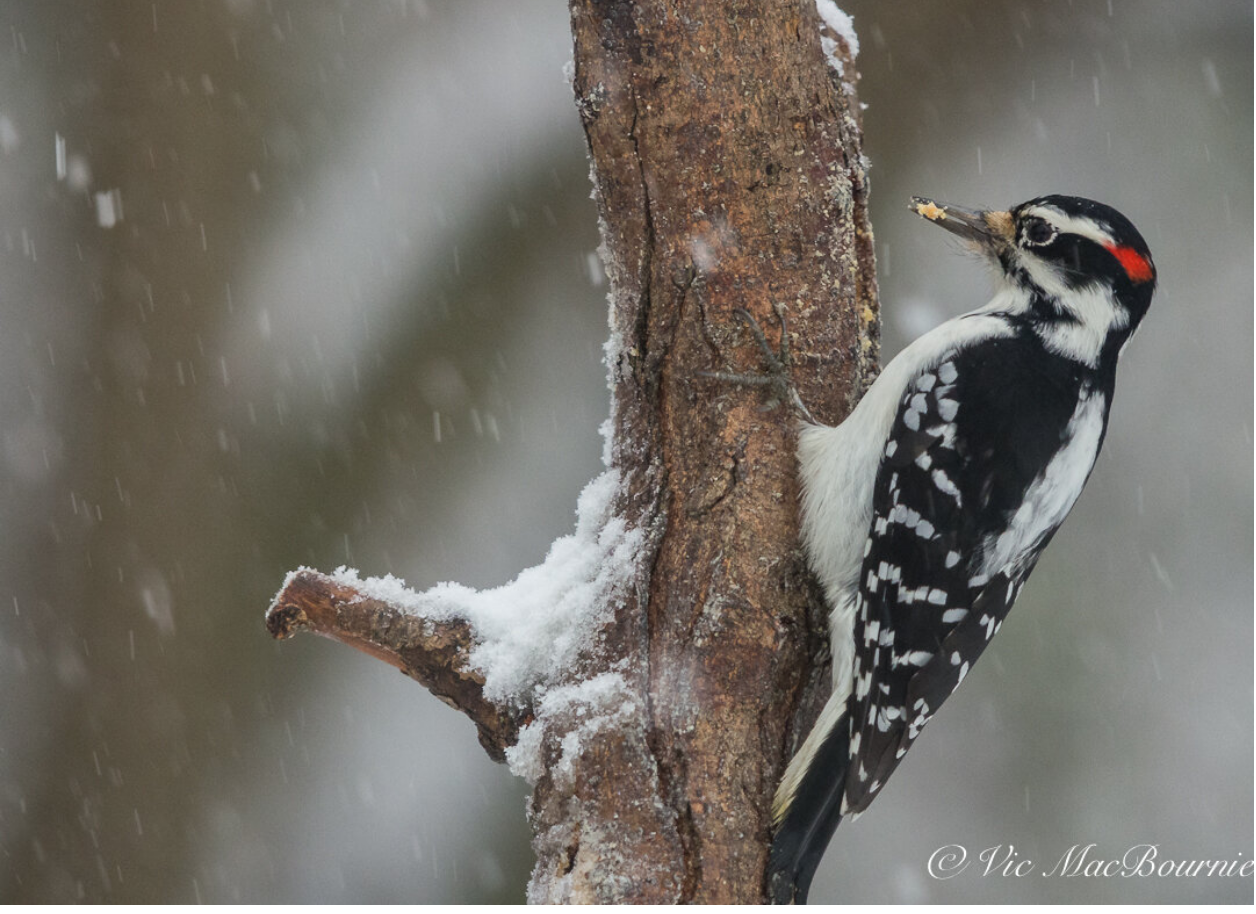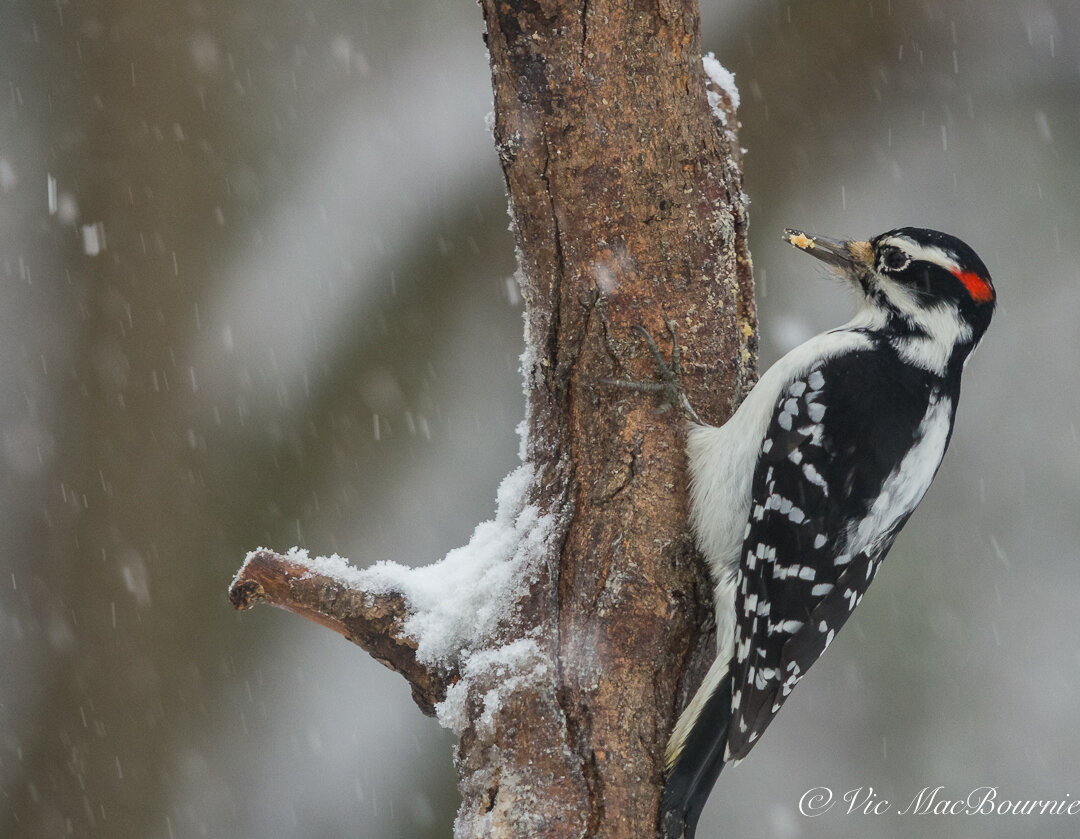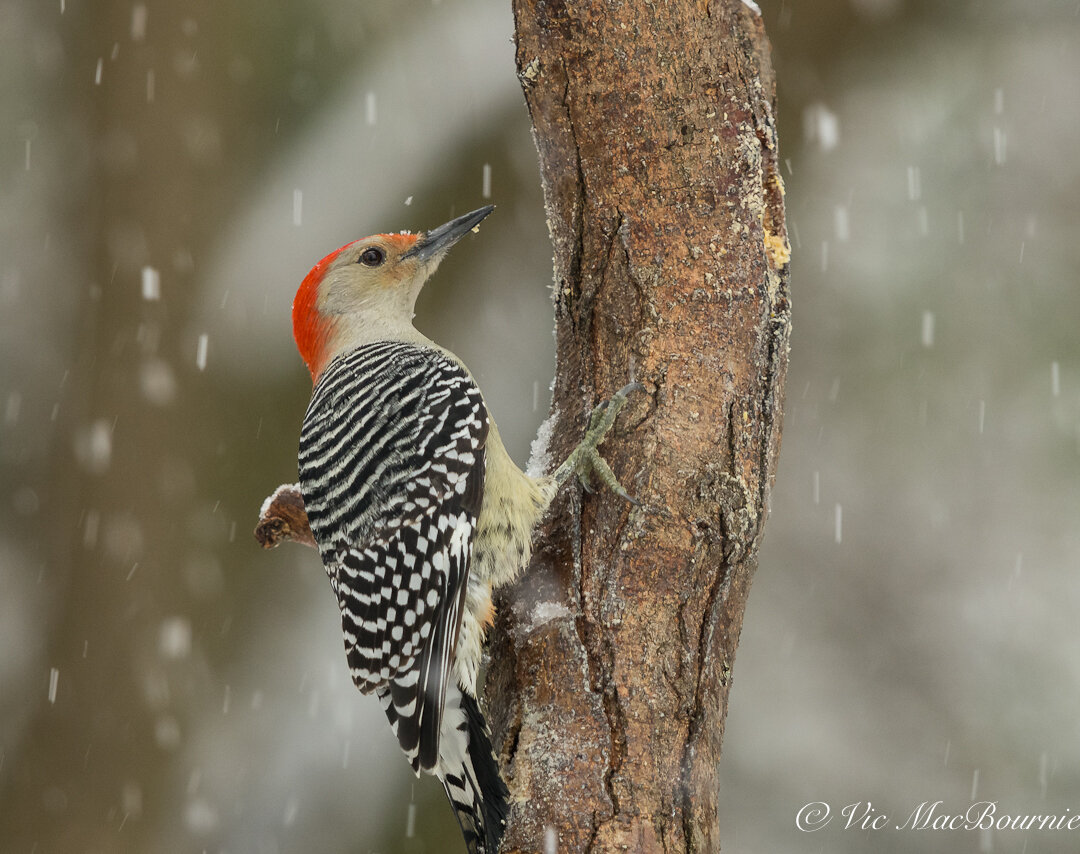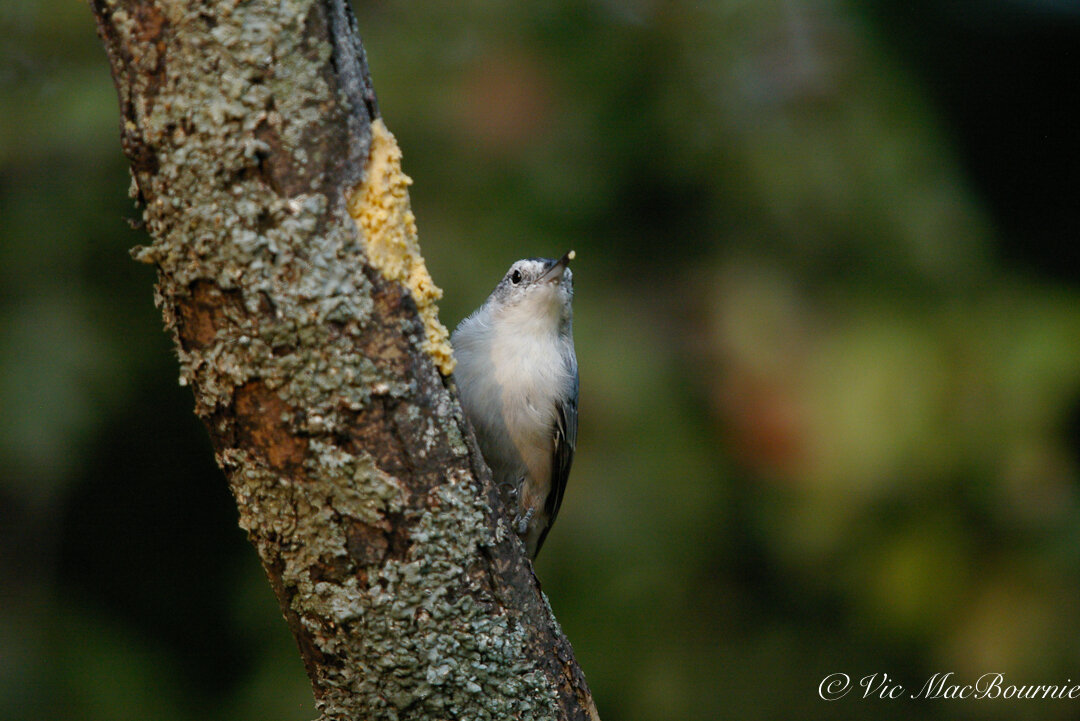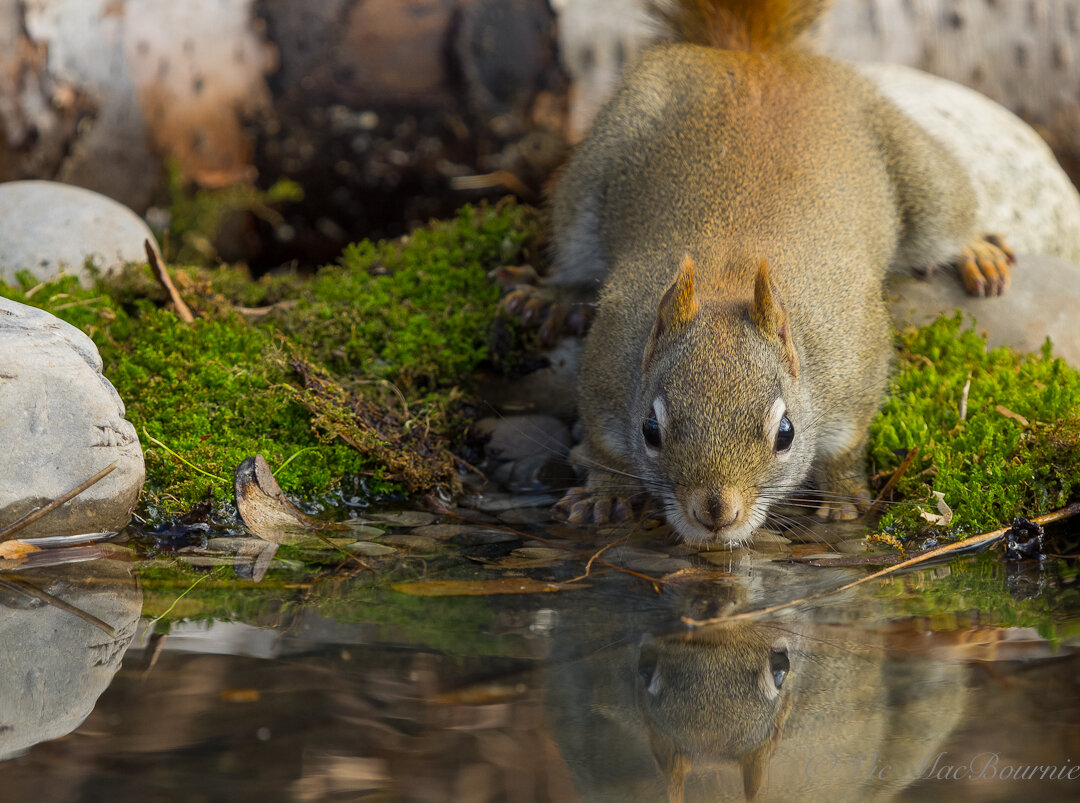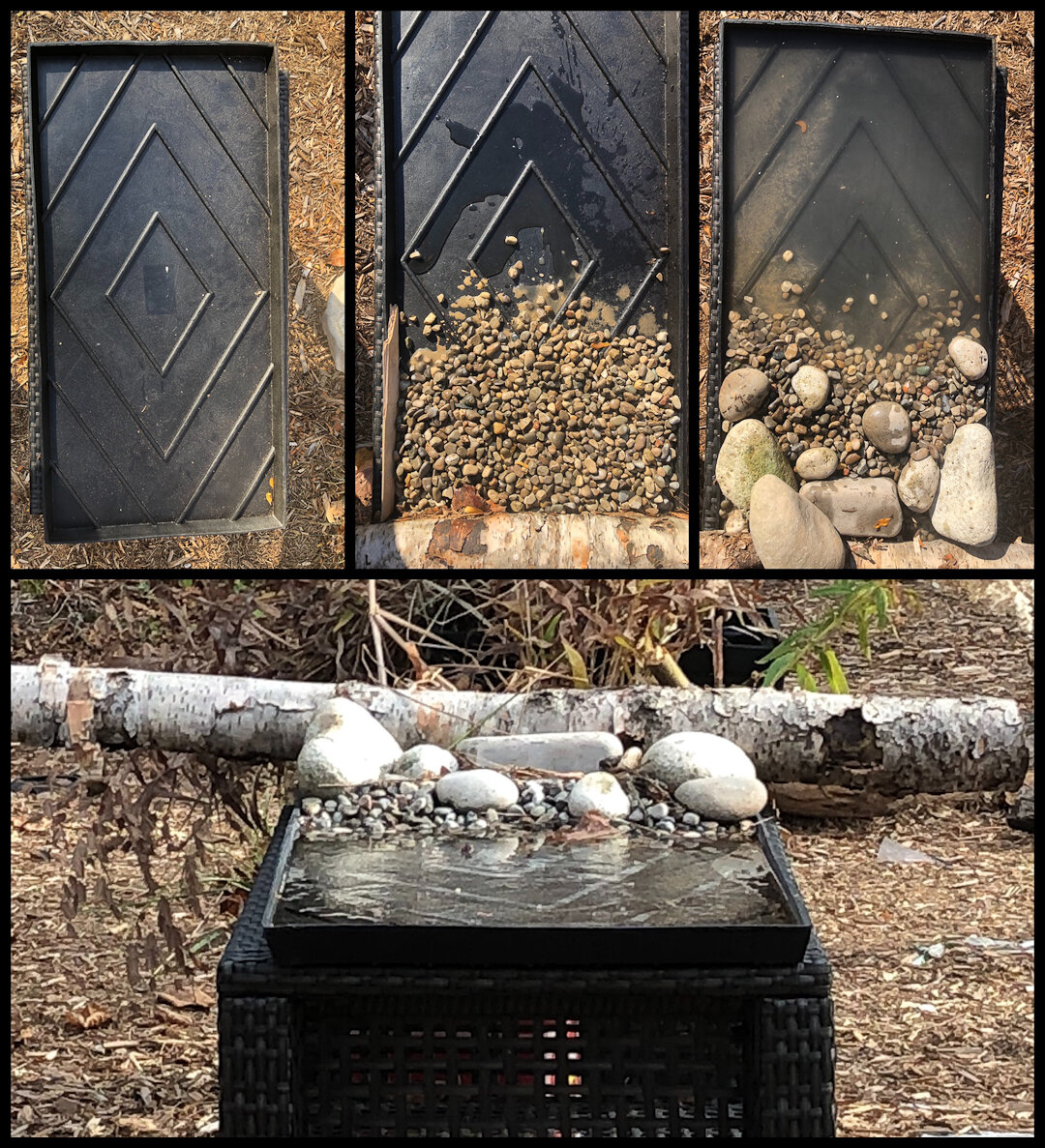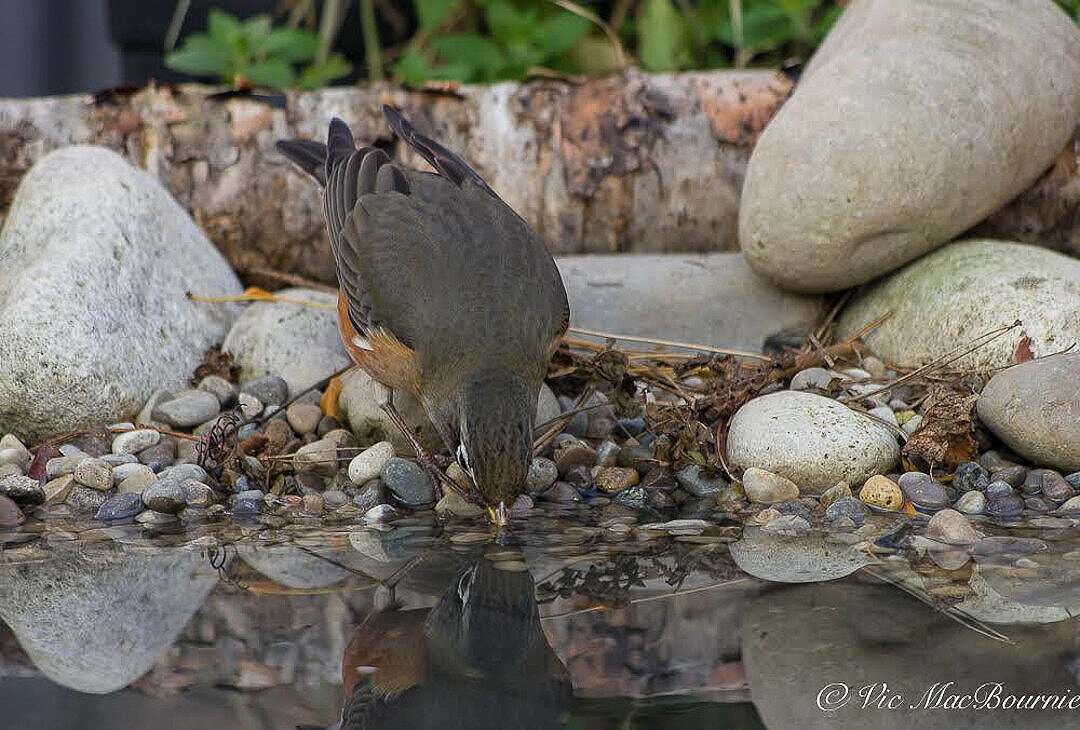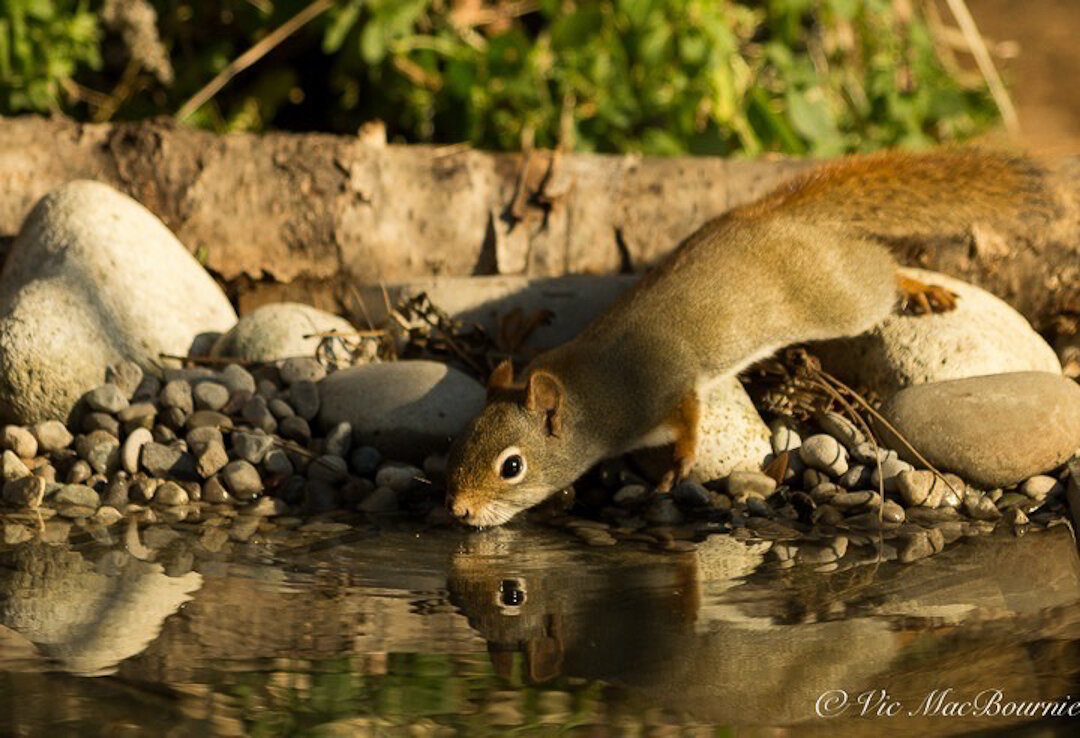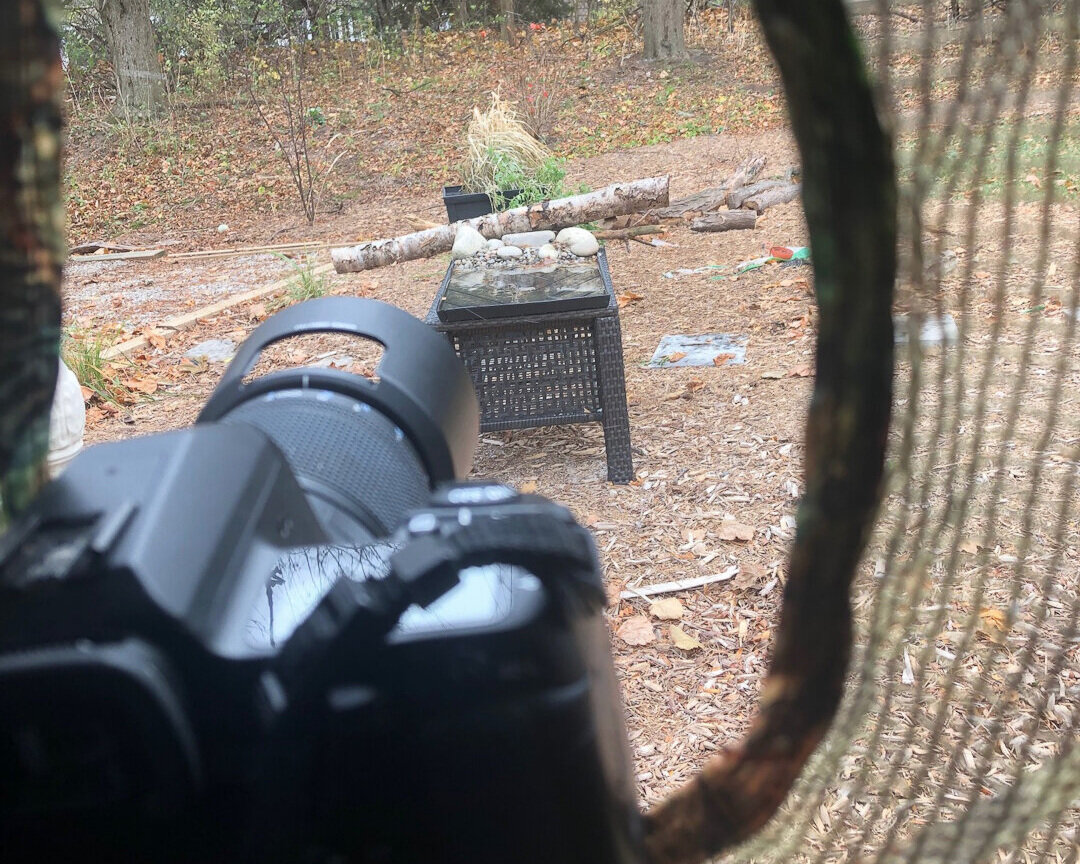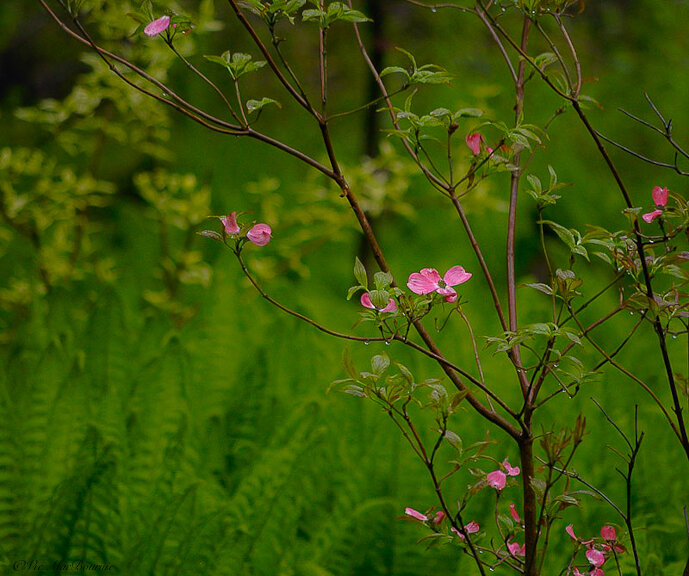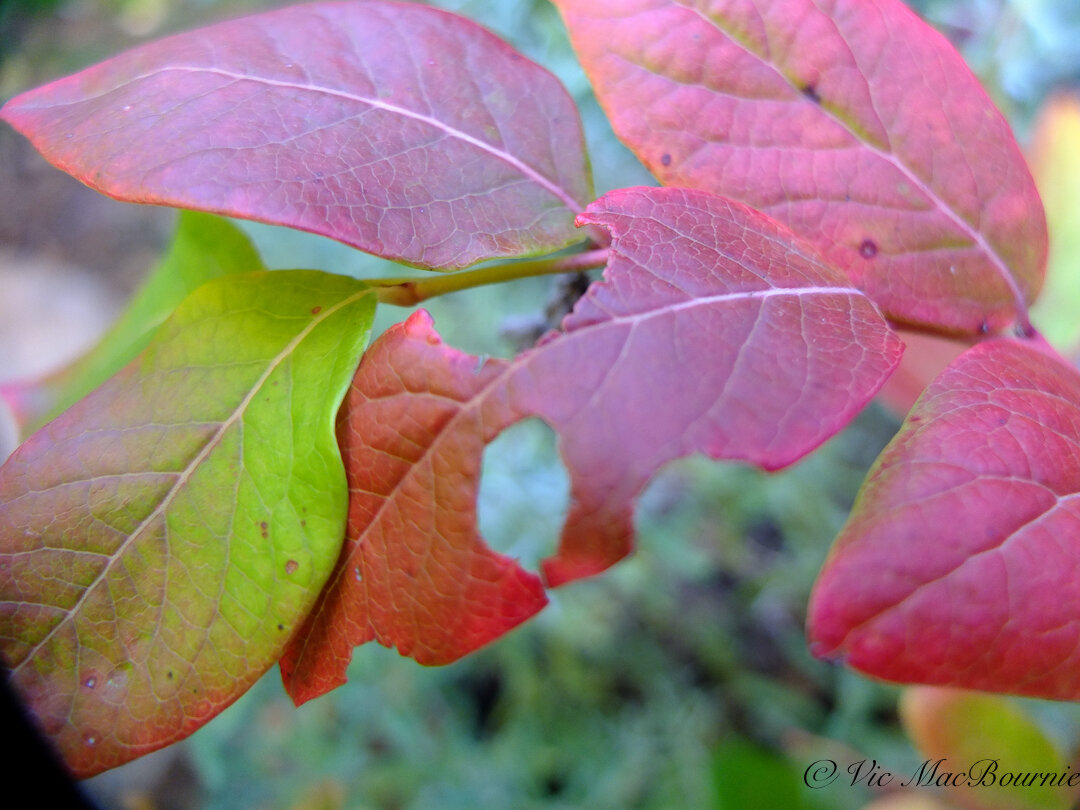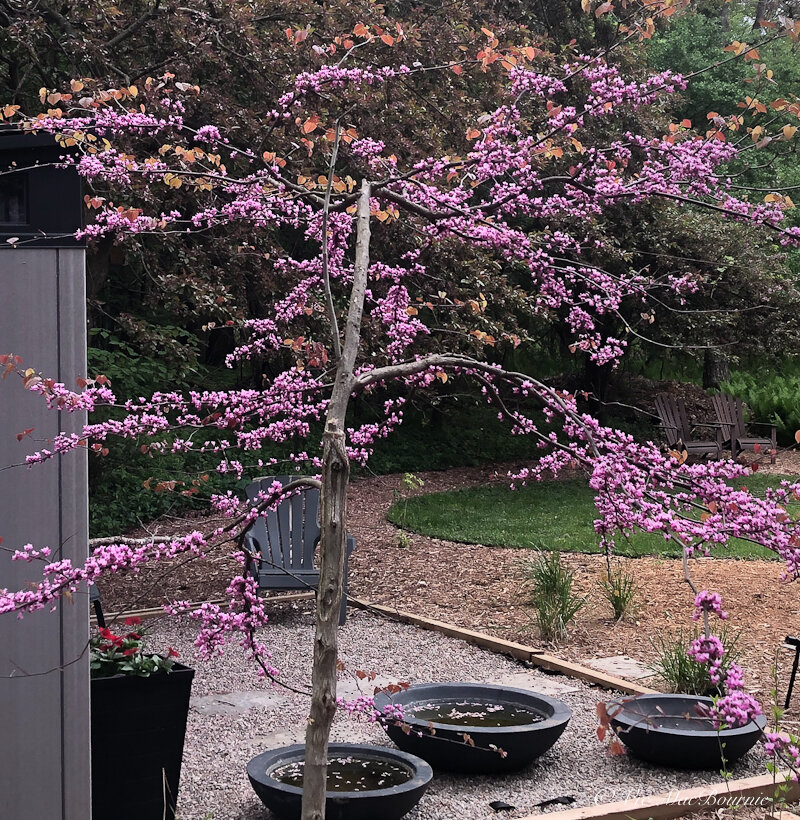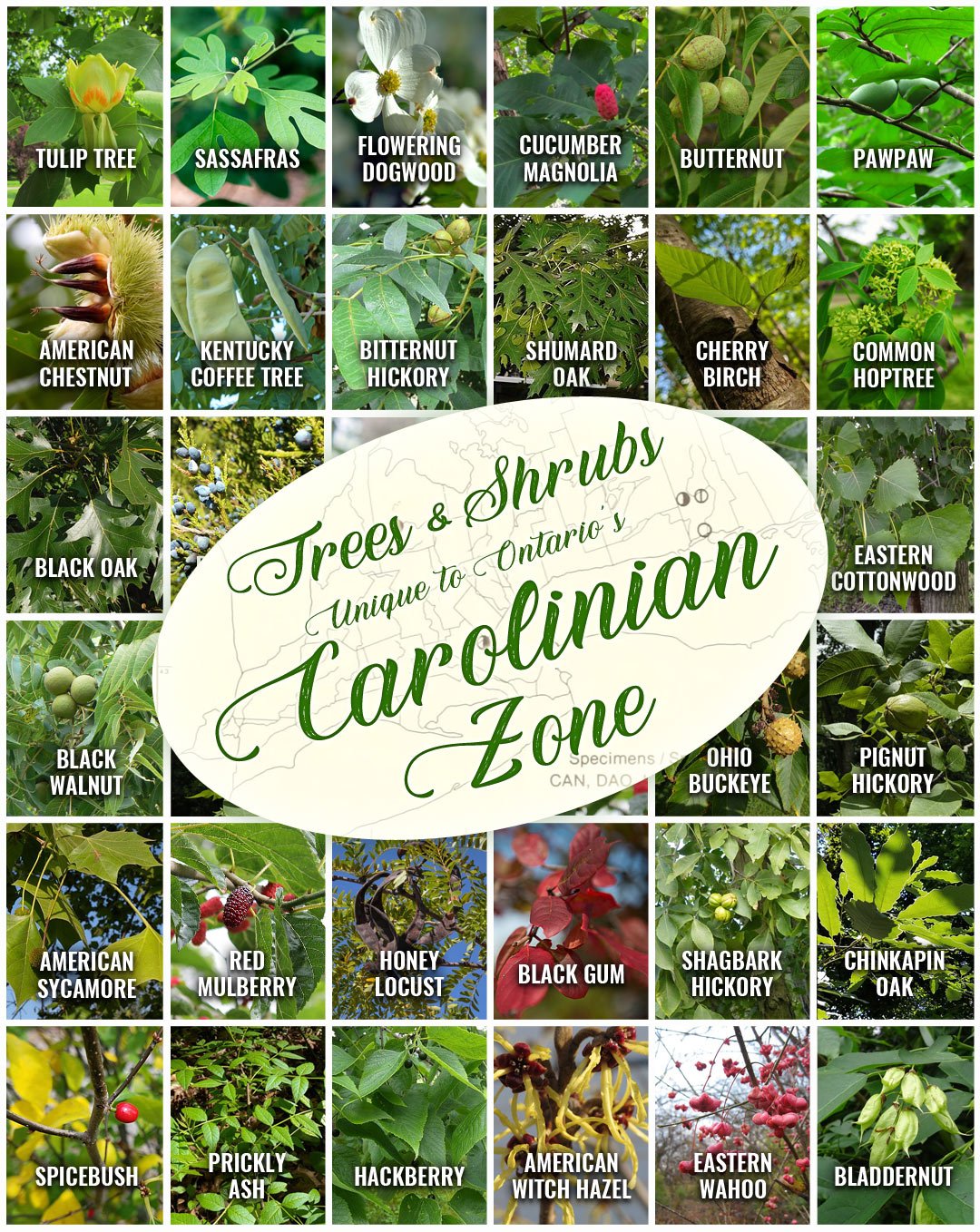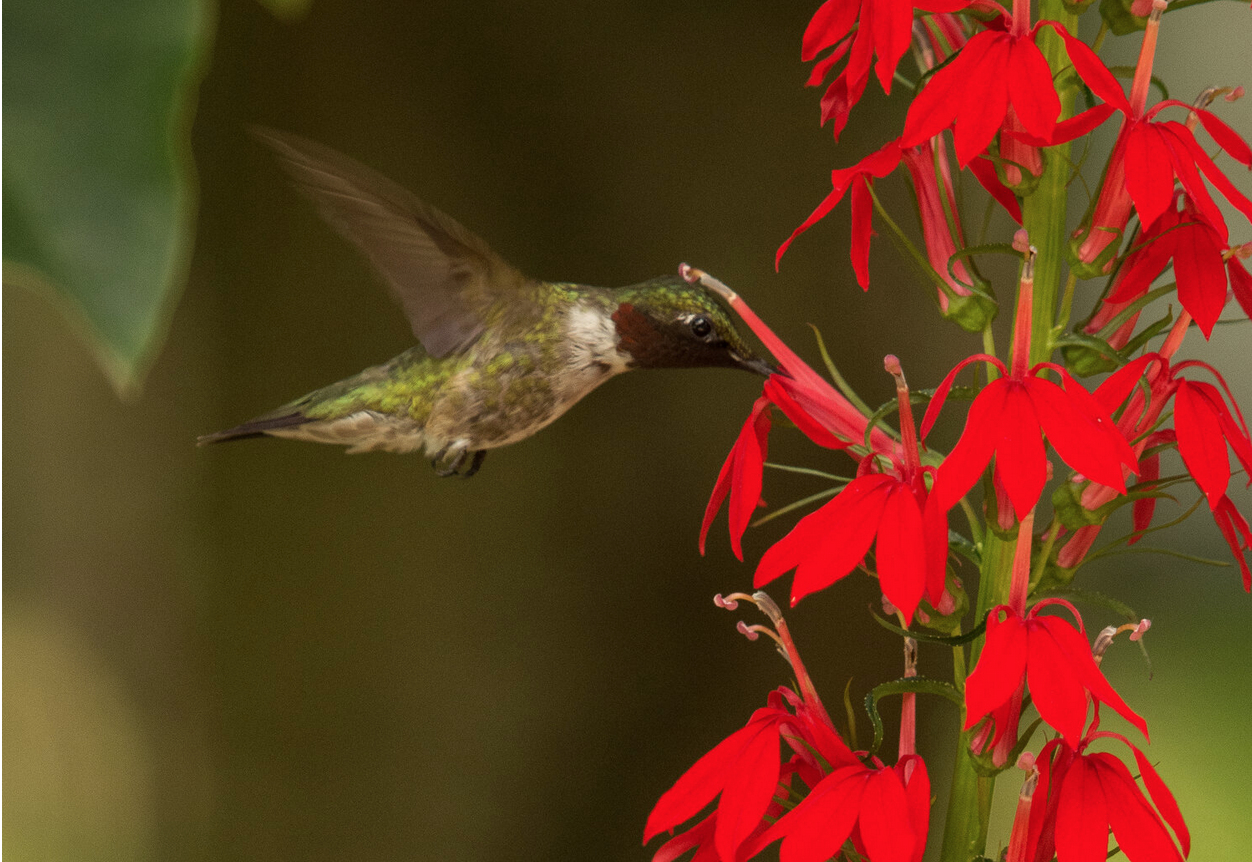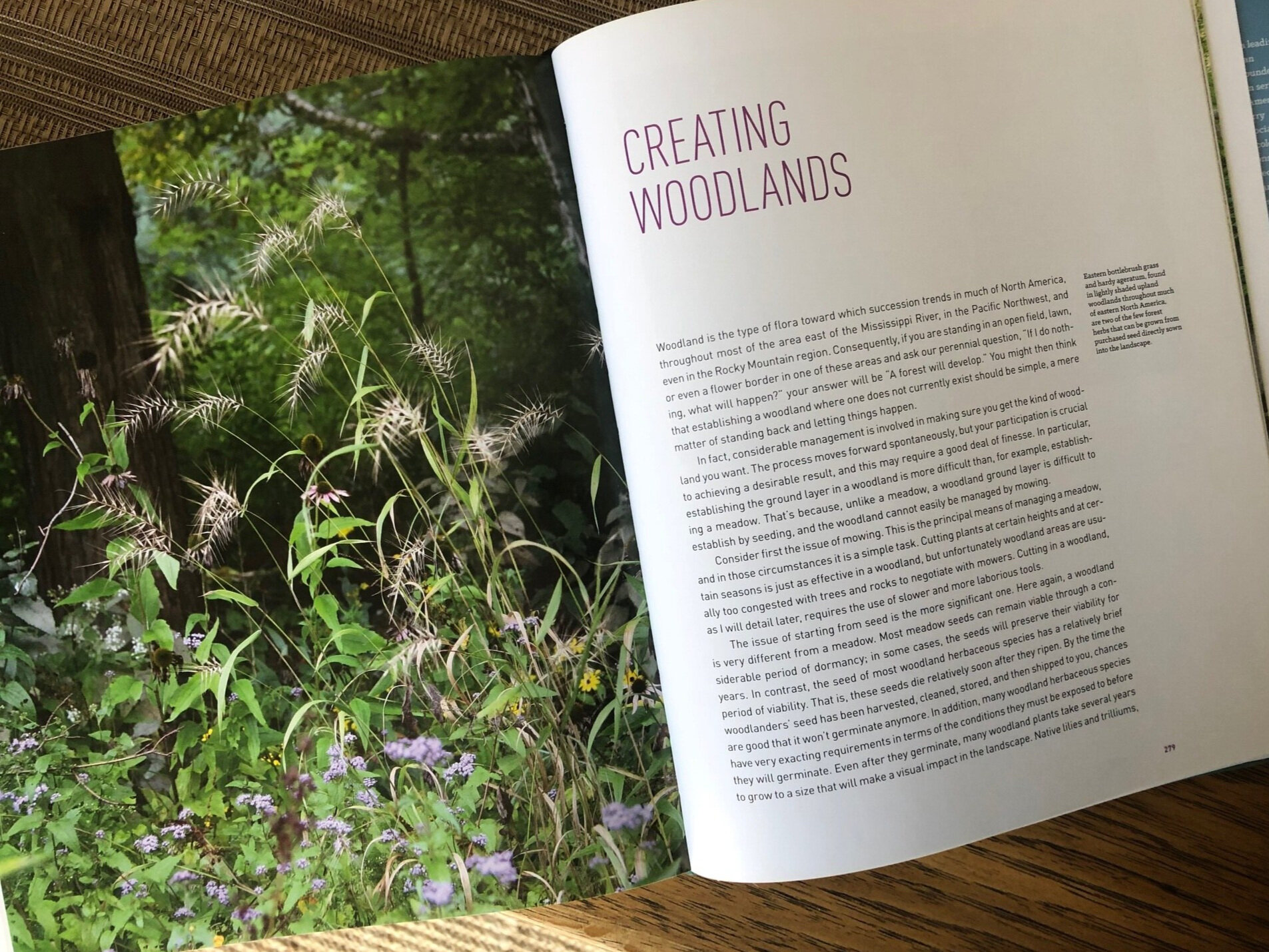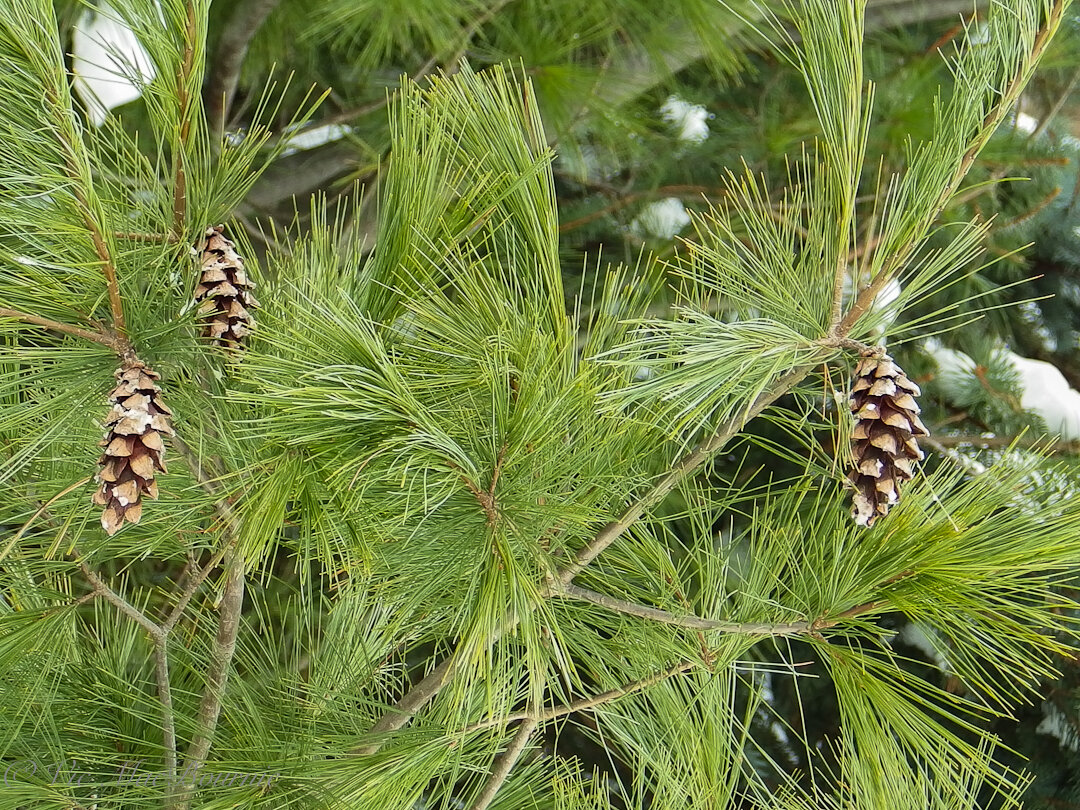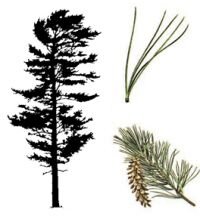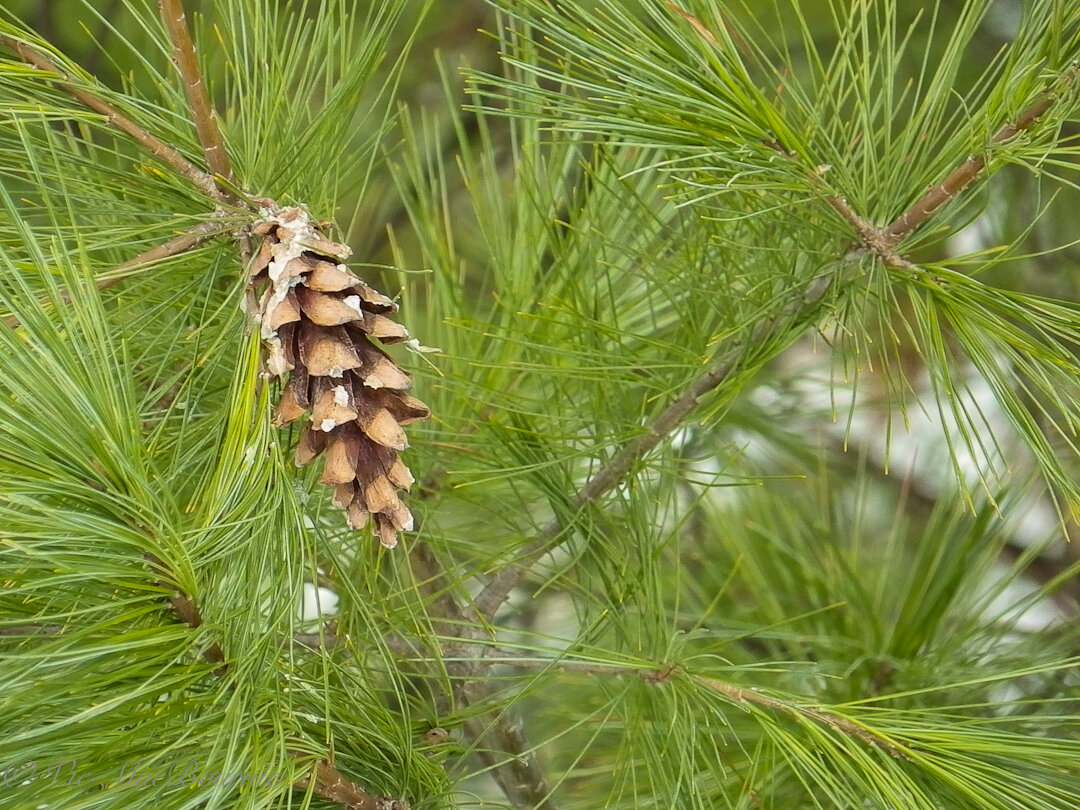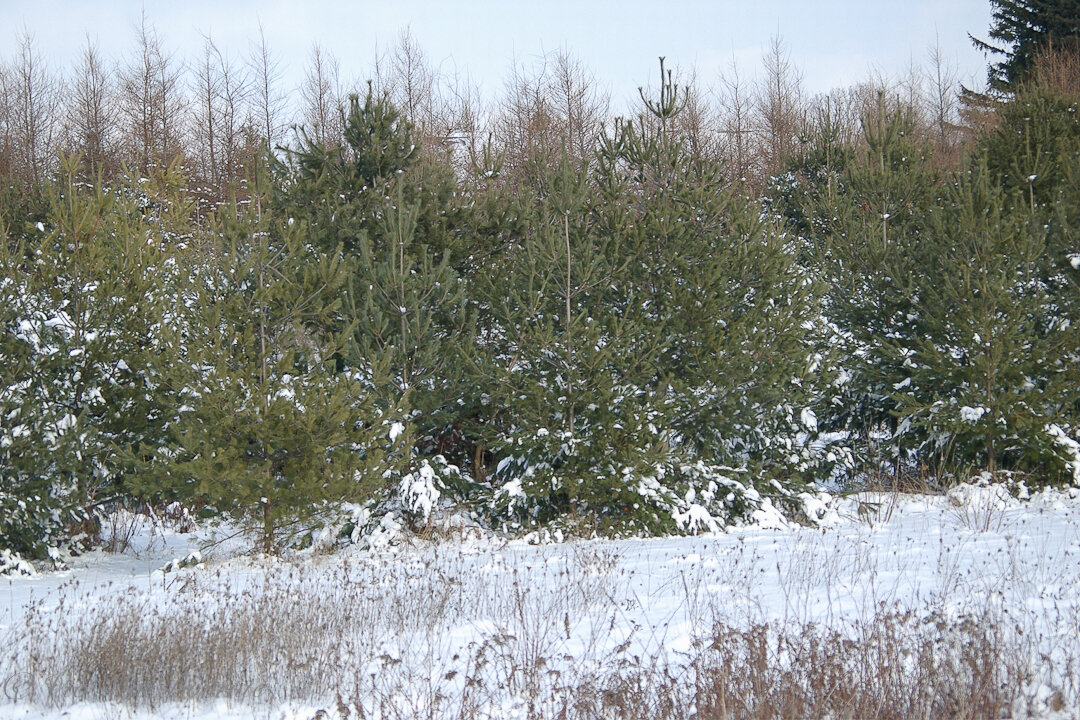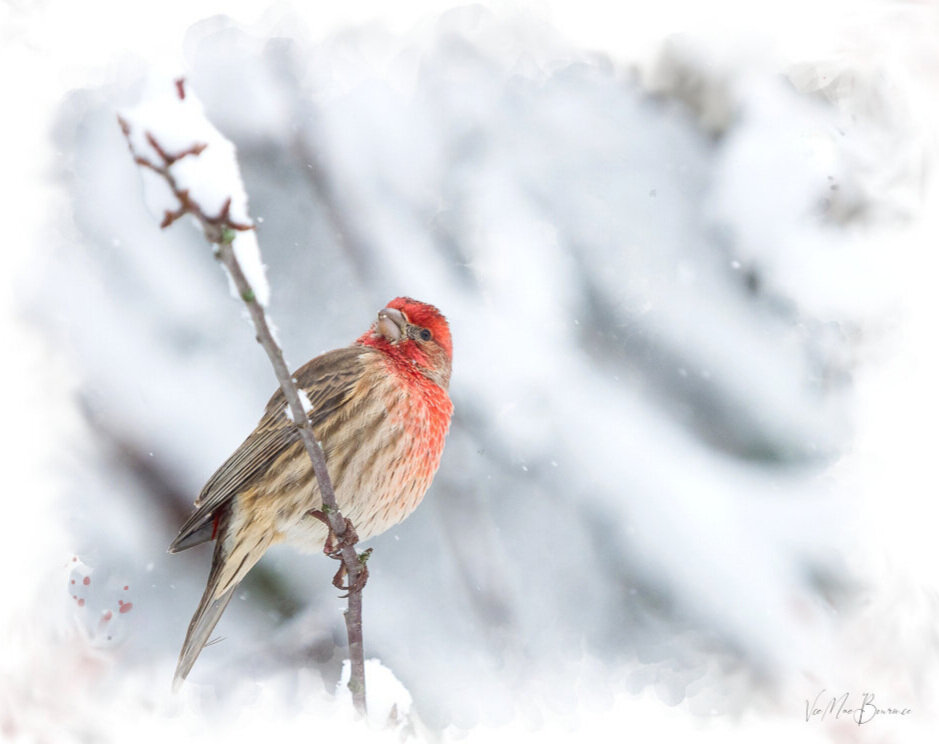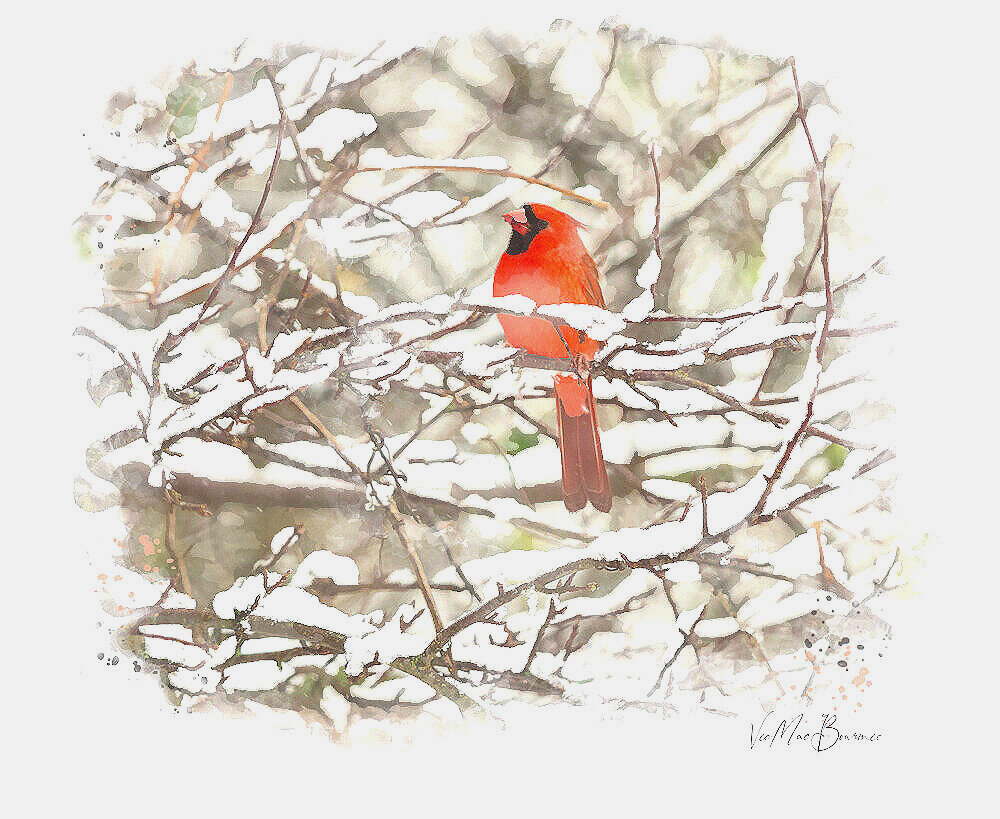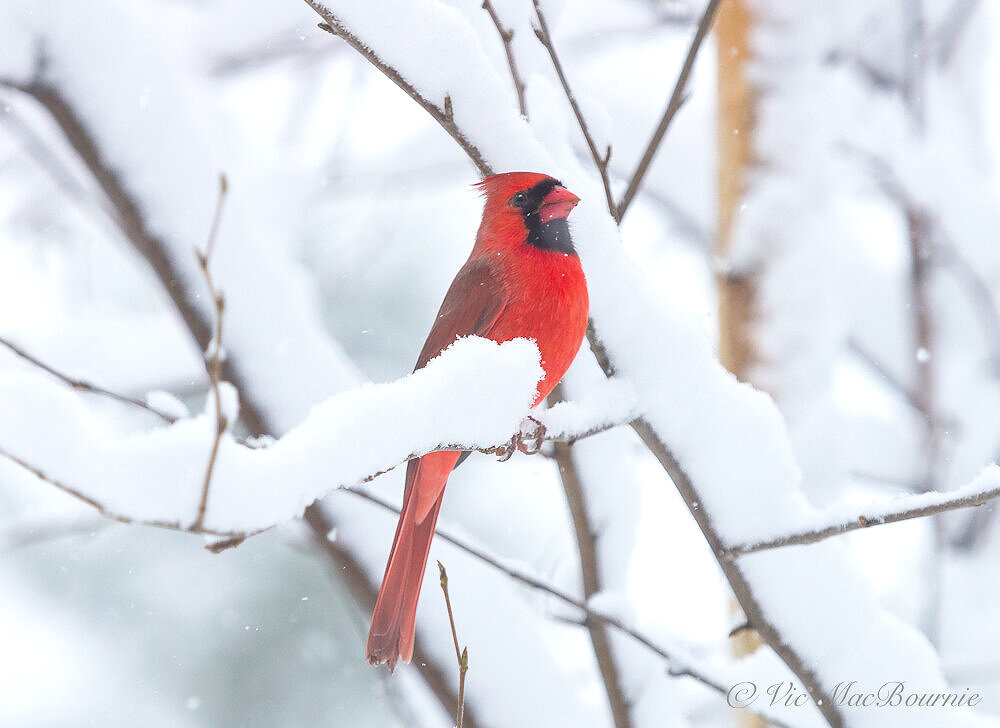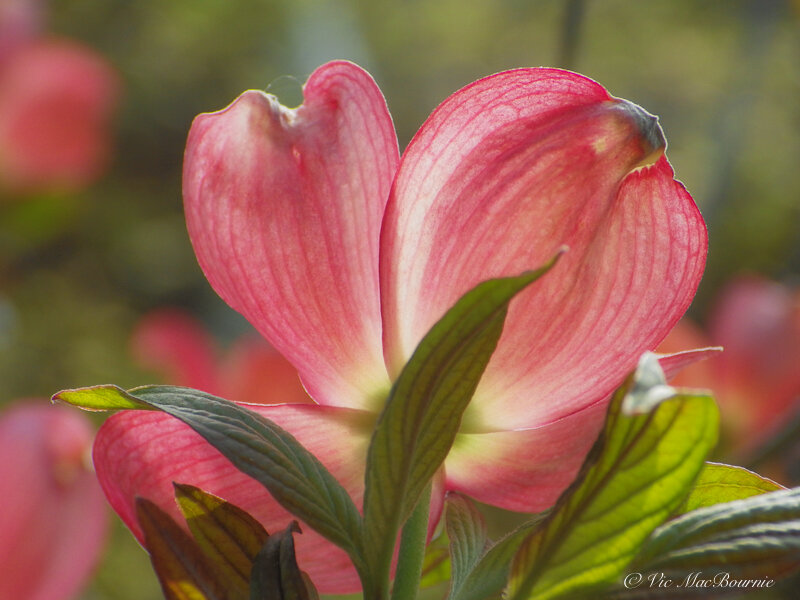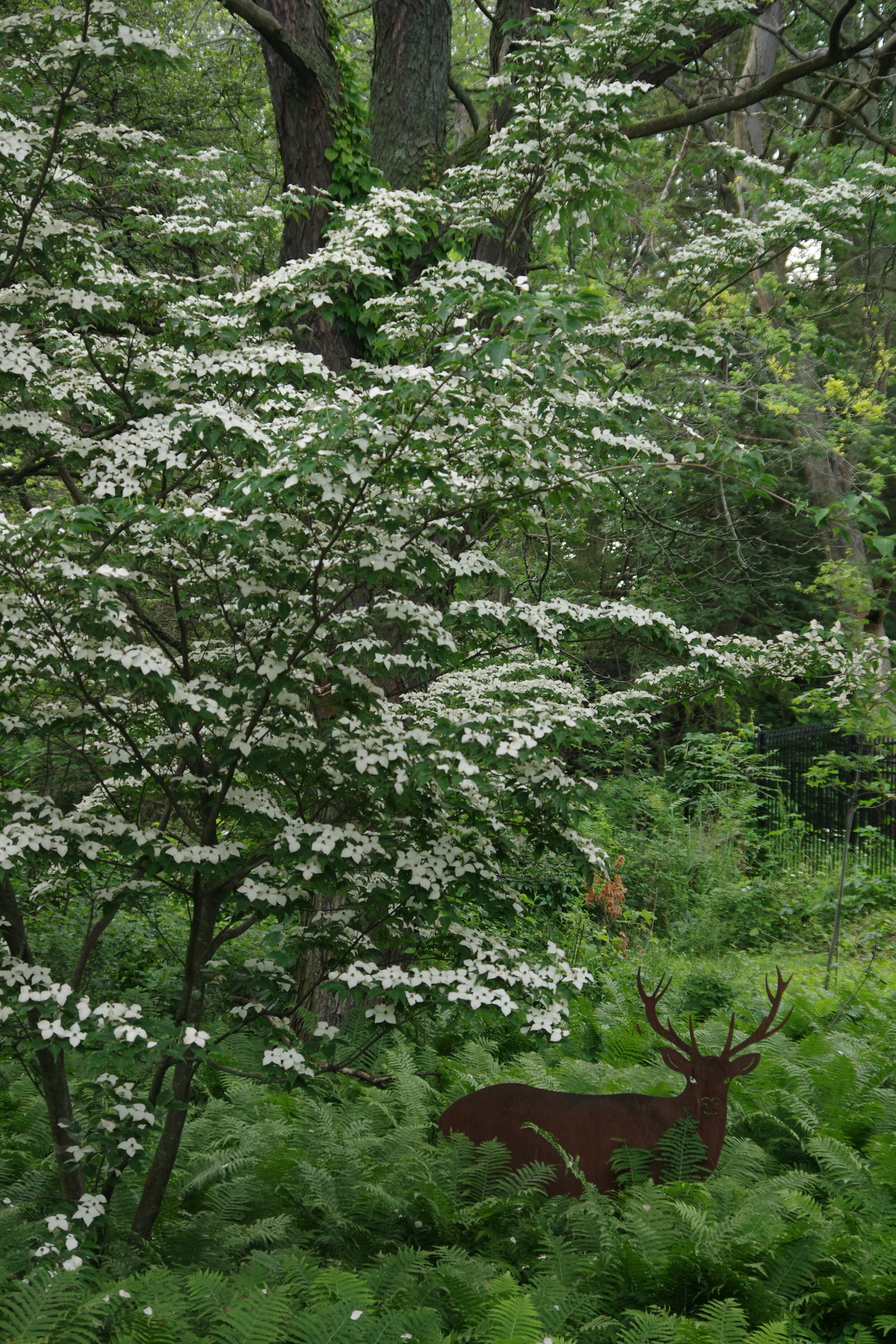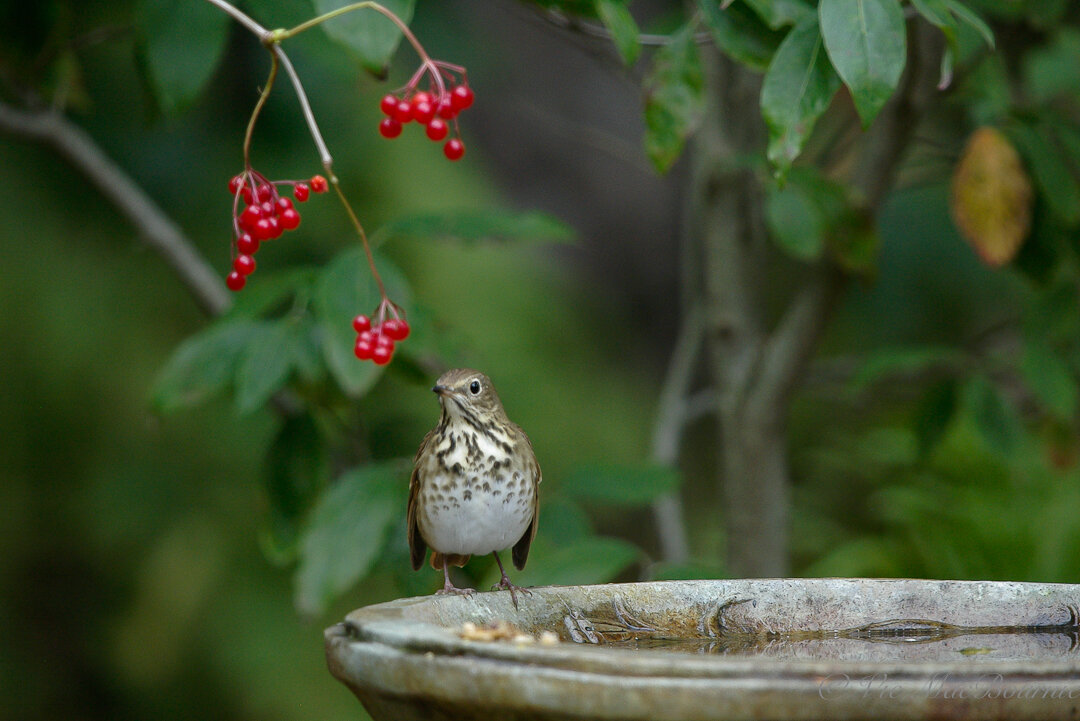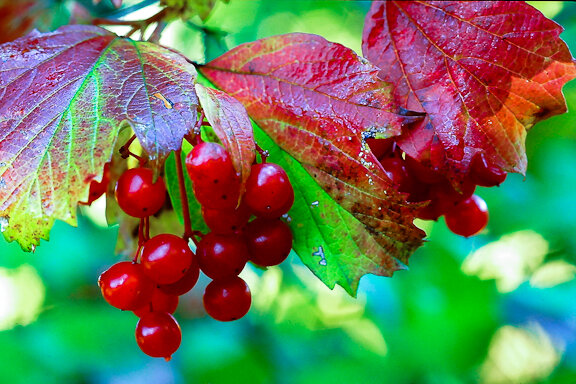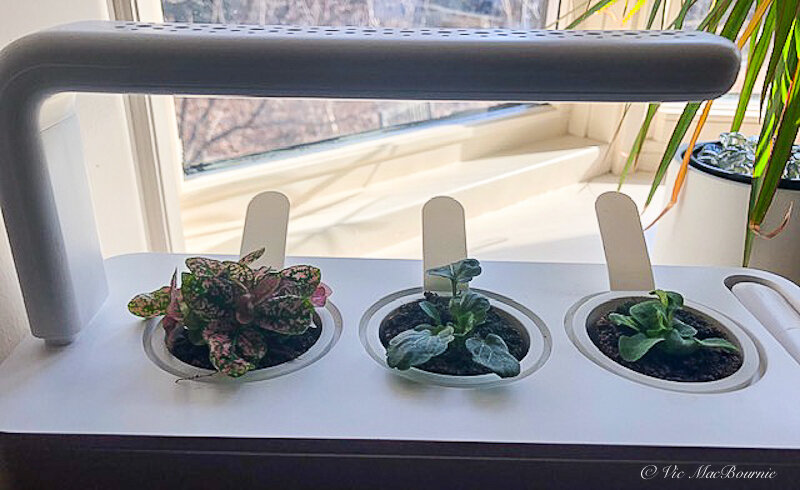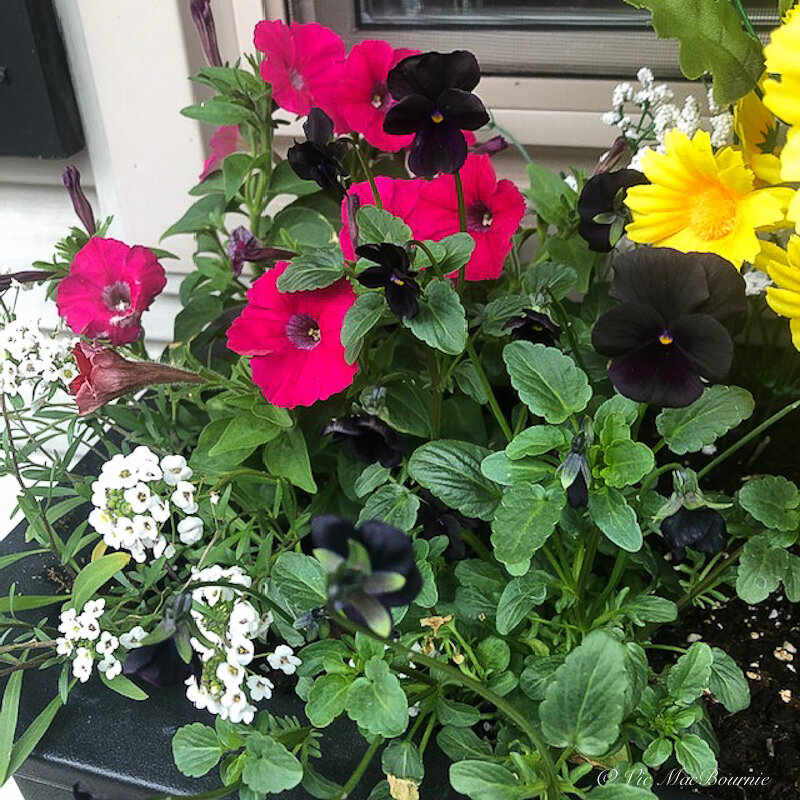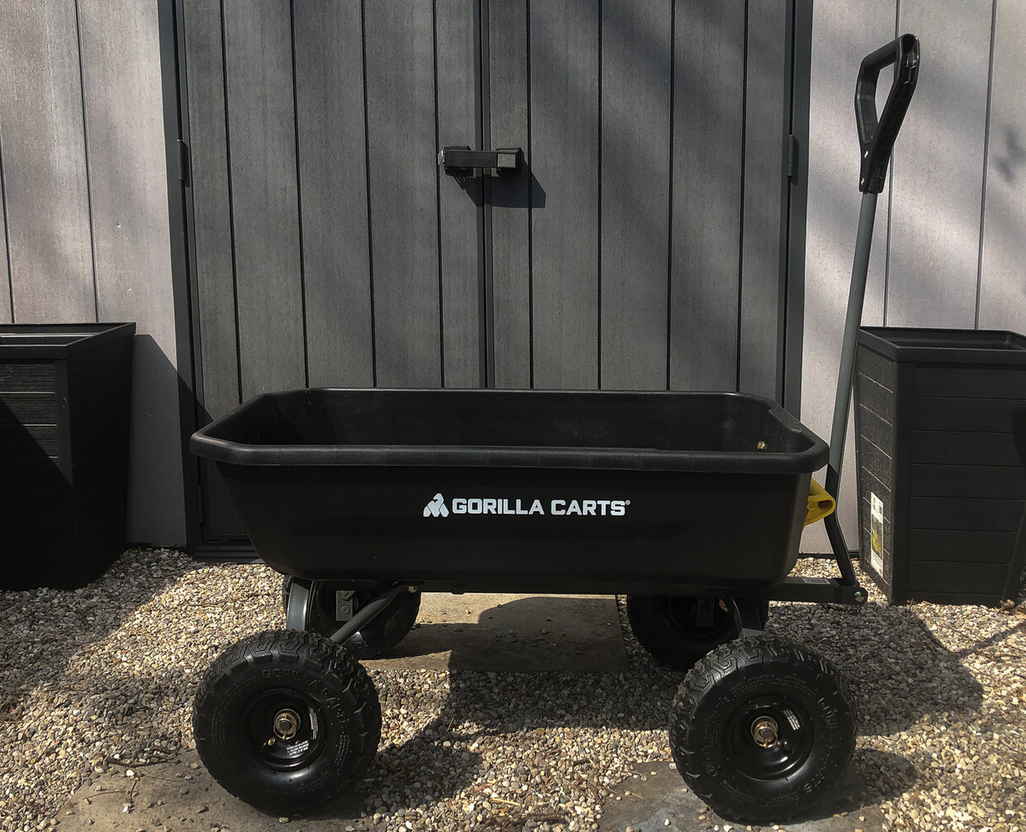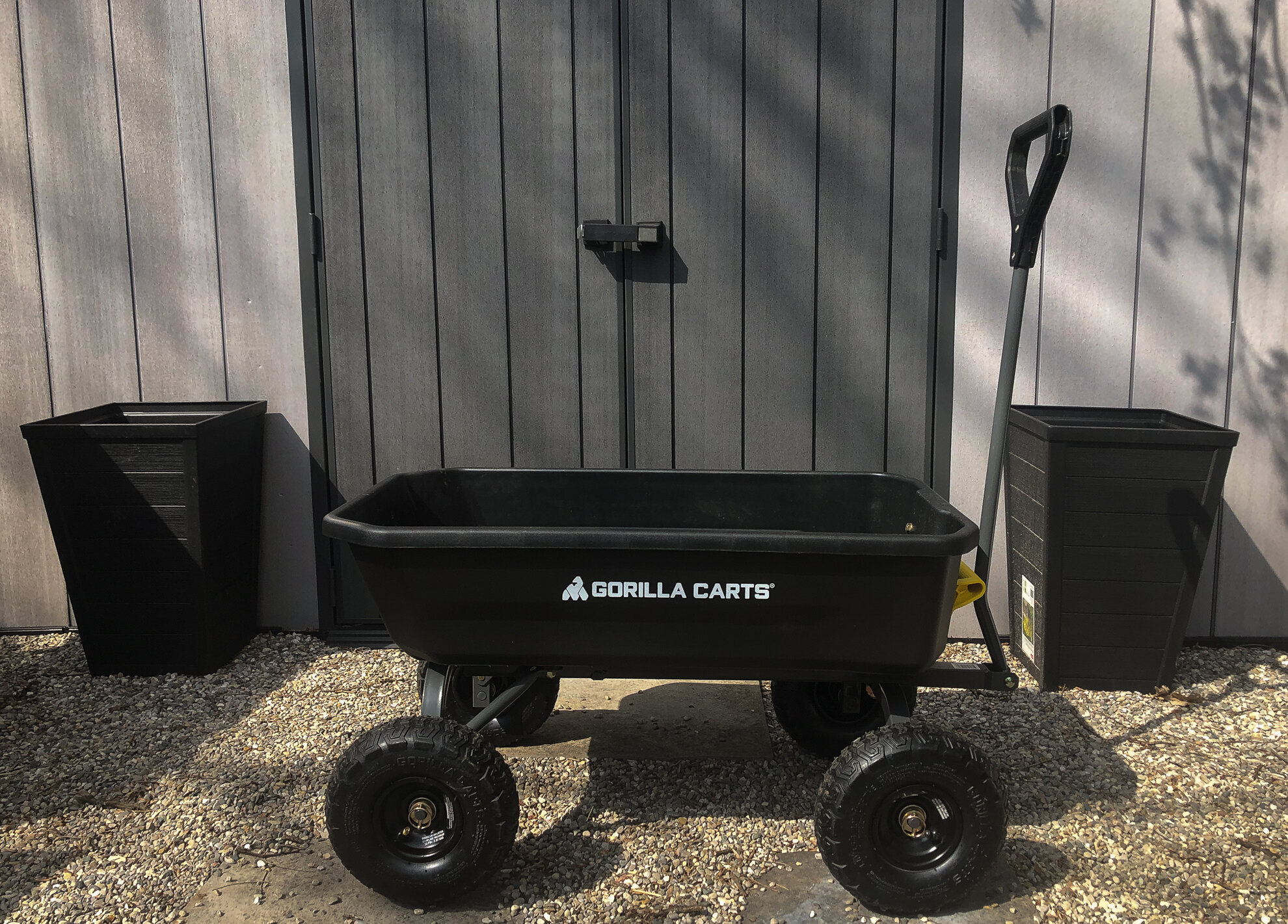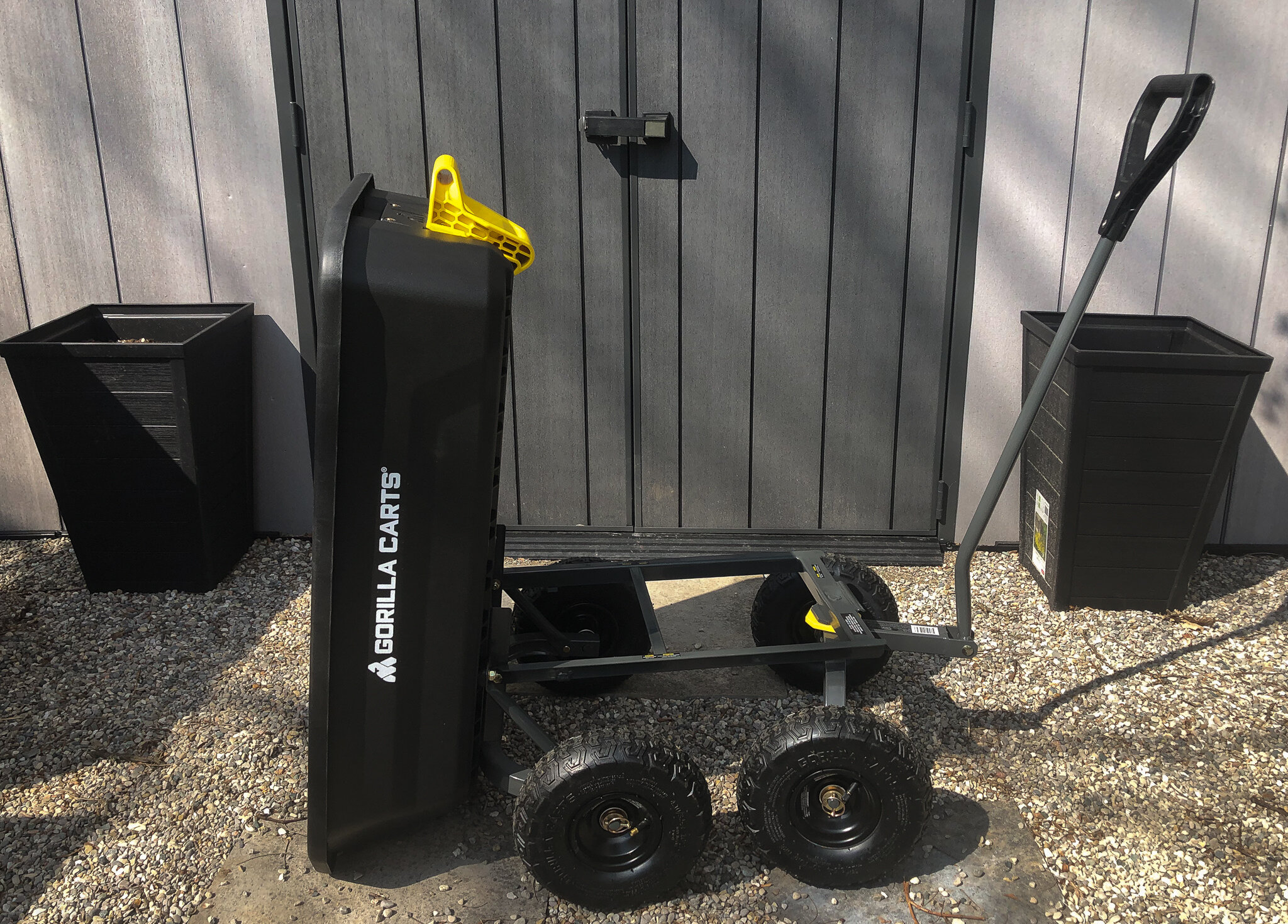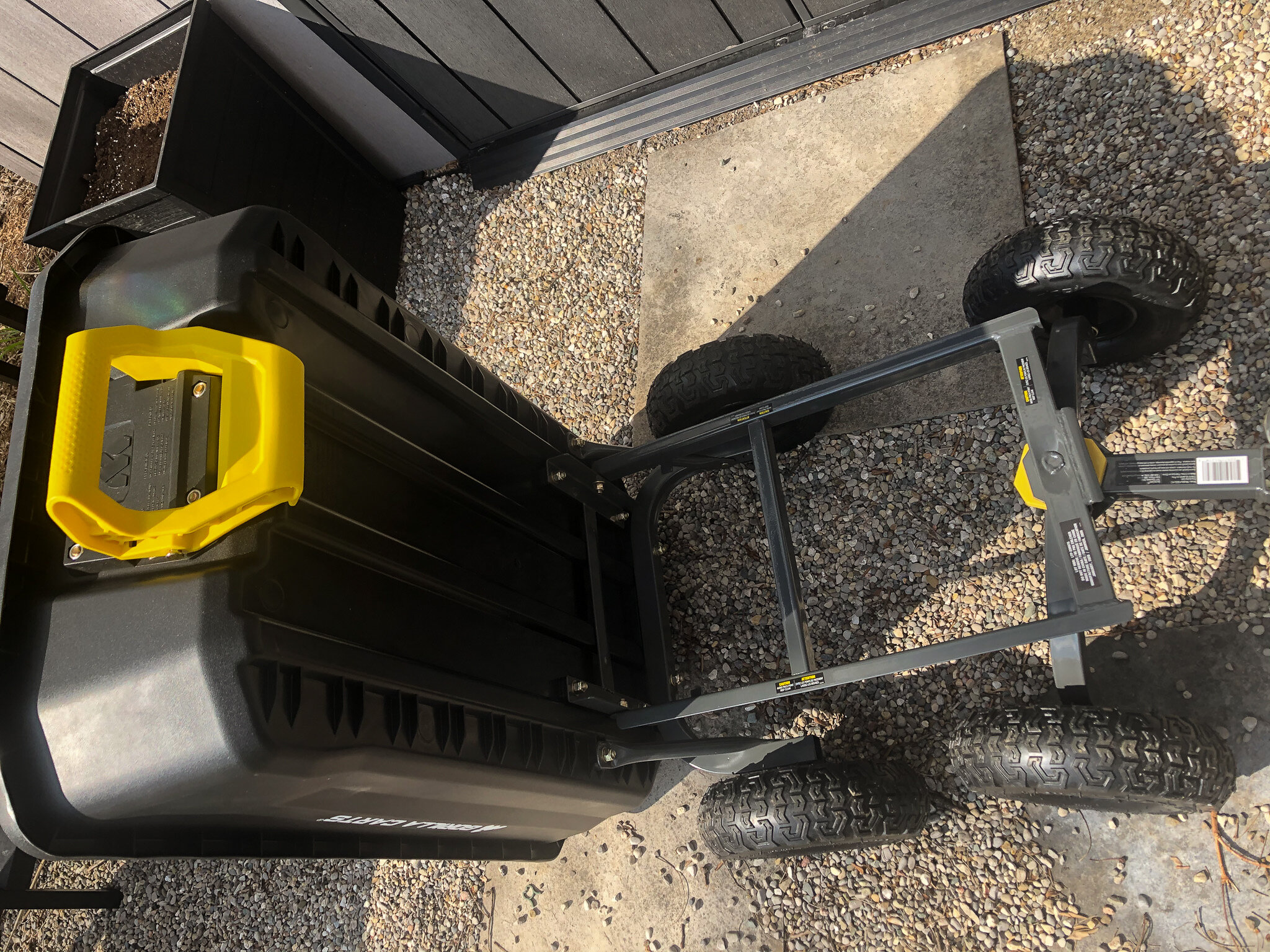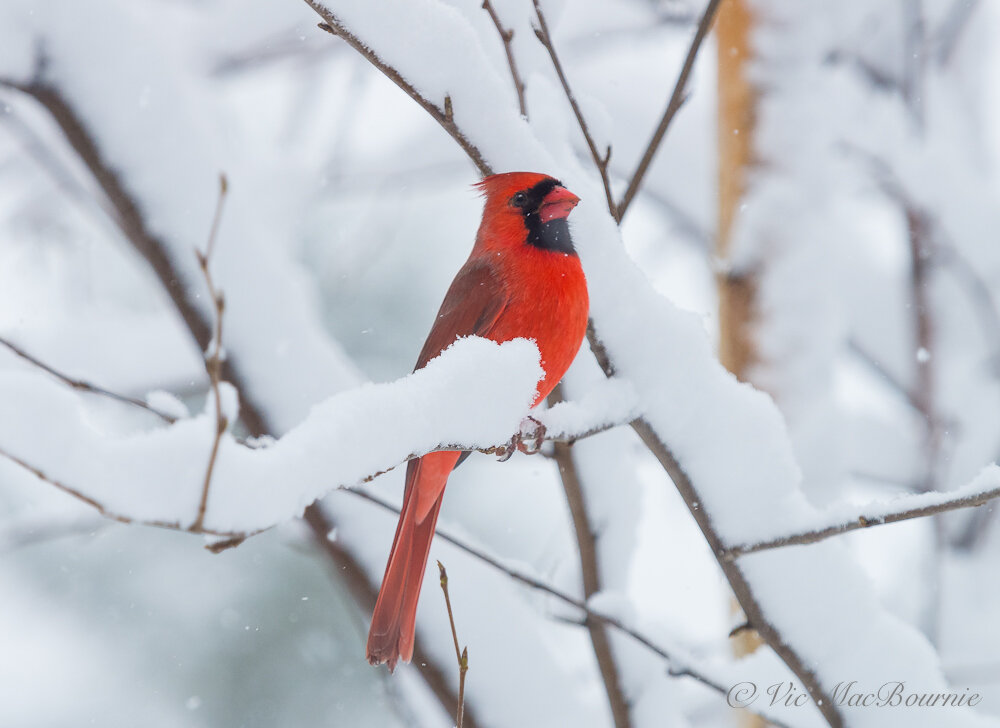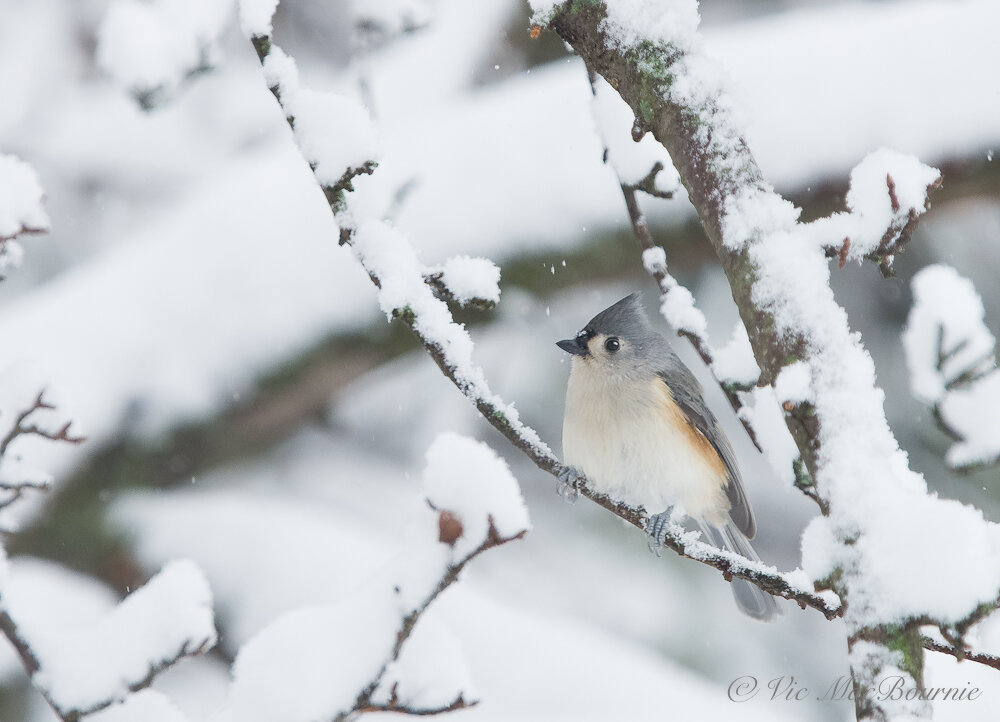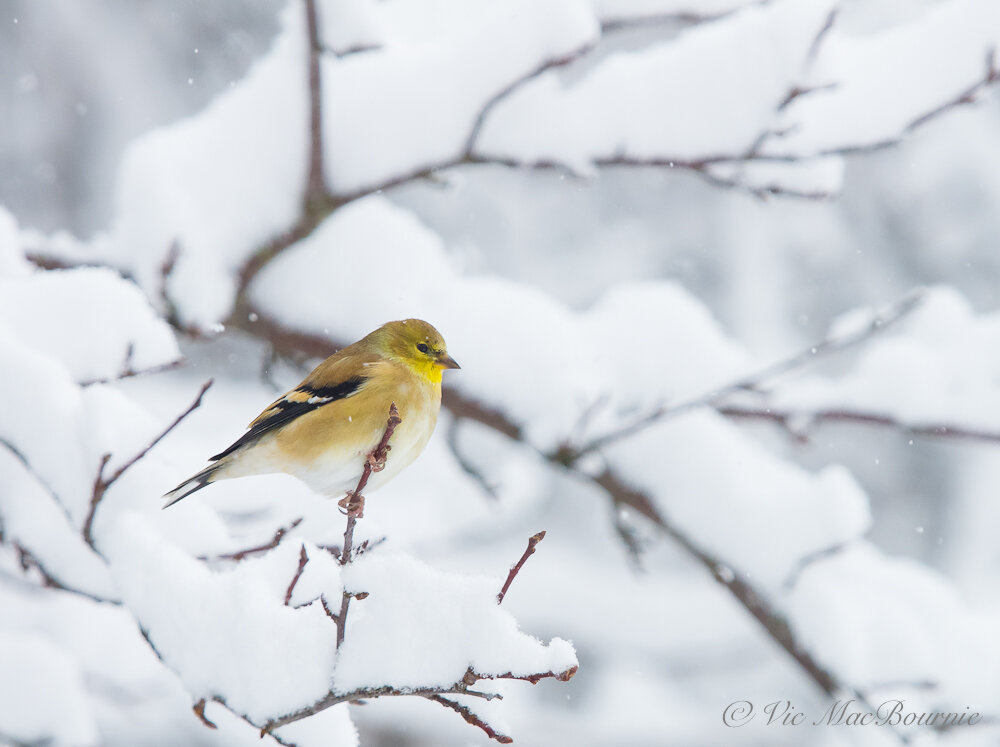Keter Artisan shed review: Contemporary flair and top quality build
The days of your dad’s old garden shed kits made of tin with flimsy doors that keep falling off, are long gone. Today, homeowners can choose garden shed kits constructed of wood, resin and steel that all have a place in our yards. Why did choose a contemporary resin design over a traditional wood shed? There are several key reasons that may surprise you.
Why I chose prefab resin garden shed kit over a wooden shed
The search for a stylish, well-priced garden shed kit for our Woodland garden sent me down many paths, but it all came to an abrupt end when I stumbled across Keter’s Artisan contemporary design.
So what makes the Keter Artisan shed a great product? The shed is available in different sizes, but we went with the largest 11X7-foot design with double door entry and a series of small windows across the front and down the sides to let in plenty of light during daylight hours. Its sophisticated and stylish look allows it to fit into any garden style. It’s easy to build yourself, offers double-door entry and is a quality, steel reinforced product that can stand up to tough Canadian winters.
We also added a Keter High-Store Shed on one side of the Artisan shed for additional storage (seen in the photo above on the right side). Together, the two stylish sheds blend together and have a sophisticated appearance with their beautifully weathered cedar-look finish in that highly sought after silvery grey colour. They combine to give the appearance of one large shed with a bump-out not unlike those you may see on a mobile home or trailer. The amount of storage these two sheds provide is astonishing.
You can also add the matching impressive Keter Denali box for extra storage. It has the same grey weathered cedar look to match the other products.
Keter’s Artisan shed together with the High Store shed on the side provide an elegant, sophisticated contemporary look together with the three water bowls.
So why did I choose a prefab contemporary vinyl shed over a more traditional wooden one?
The answer to that question is difficult. In short, however, the Keter shed provided extremely high quality at a reasonable price with a sophisticated look that really would have been difficult to match in a wood product. The silvery-grey finish would have taken years to occur naturally, if ever.
An unstained wood shed in the dampness of a woodland garden would most likely have taken on a dark grey mold rather than the silvery look of sun-bleached cedar. At the very best, a wooden shed would need regular maintenance including regular cleaning and staining to keep that natural silvery-grey look.
In addition, the texture and quality of the exterior hard-wearing durable resin makes it difficult to distinguish whether the siding is actually a wood product or vinyl/resin. In many ways, the vinyl siding looks and feels more like rough cut cedar than the real thing.
In fact, nothing really comes close to the look and feel of Keter’s innovative DUOTECH siding that offers a real wood texture with the durability and all-weather resistance of resin. It’s also easy to clean, requires zero maintenance and is fade free. But more on that later.
Five reasons I chose a resin shed
Contemporary design with a sophisticated look that works well in our Woodland garden.
Maintenance-free exterior and interior with easy-to-clean washable Duotech panels.
Steel reinforced framing for durability and a roof that can handle heavy snow loads.
Easy assembly with basic tools making it a DIY job if you are up to a little hard work.
Plenty of storage space, and because of the design, lots of headroom. The floor panels are an added bonus that keeps everything clean and dry.
To be fair, I must have looked at hundreds of wooden shed designs prior to purchasing the Keter shed. My plan was certainly to eventually buy a wooden shed and have the company construct it for me either on a deck or concrete slab. They were all well-built and quite nice. Most had a rustic look to them and all involved some kind of construction either by myself or by a crew who would come in and put up the shed in a day or two.
The real nice ones were a little expensive for my taste and the ones I felt I could afford were, quite frankly, kind of boring and predictable.
While a rustic shed in a woodland setting seems totally appropriate, I could not help but be drawn to the more contemporary sheds that I often came across while looking at pictures on Pinterest and other sources. Their simplicity was attractive to my aesthetic and I knew I could landscape around it to make it fit in to the woodland experience.
I was also interested in creating the feeling of a separate garden room where I could view the woodland from a different perspective than it is usually viewed from. Part of that involved incorporating three large, black water bowls into the landscape design in front of the shed and I knew the three water bowls would create a contemporary feel to the design not completely in keeping with the rustic aesthetic of the wooden sheds I had seen.
And then I came across the Keter Artisan shed. Instantly, I liked the look. The silvery-grey colour reminded me of the elegant and sophisticated wooden structures I had seen years earlier during vacations to Canada’s western provinces, especially Vancouver and the Victoria area. I knew it would work perfectly with the water bowls and other design features I had planned for the area.
I had already purchased other Keter products and was impressed with how easily they went together and how sturdy they were once completed. Think, the highest quality Ikea products, but for the garden.
We were so impressed with their products that we eventually added two black Keter raised planters on the left side and two Keter planters on each side of the double doors. (See photo at bottom of article.)
The Keter Artisan shed was large, much easier to construct than wood products, and the double doors made it easy enough to pack away many substantial garden products from lawn mowers to BBQs if necessary.
My plan was always to save money and build the shed on my own. We ordered both sheds, but because the Artisan model was on back order, we received the High Store shed weeks earlier. I was impressed with it from the beginning. It went together quickly and easily in an afternoon and the Duotech finish was exquisite.
Then came the big boy. It came in several large boxes on a couple of skids in a large truck. It even needed to be unloaded with a fork lift. It was around that time that I began to wonder what I had gotten myself into. I didn’t expect it to be so large and heavy.
The first task was to create a platform for the shed. My plan was to use a base of screening to level off the uneven ground in an area of the garden. It was more difficult than expected for an old guy lacking the skills necessary to get the job done in a timely manner without having a heart attack. In the end, I hired a local handyman to help with the construction of the both the base and the shed.
In just one full exhausting day we were able to build the platform, spread the screenings and have the shed 90 per cent built. All that was left for me to finish on day two was the construction and installation of the two front doors.
We are now preparing for the second full summer with the two sheds, and I could not be happier with the results.
They have performed admirably all year. There have been no problems and the sheds continue to look as good as new.
What makes the Keter Artisan so special?
Let’s take a quick look at why this shed has proven to be a winner.
The Keter web site lists only two sizes the 7X7-foot and the 9X7-foot, but the larger one still appears to be available. It is certainly still listed on Amazon.com.
The shed’s positives attributes begin with the contemporary architectural design that makes the sheds stand out from the crowd. The silver-grey Duotech walls were the selling point for me. But the steel-reinforced double-wall construction and an extra-strong roof that can withstand serious snow loads ranging from up to 200-150 Kg/sqm is an important selling factor – especially in Canada where snow is a guarantee.
The Keter XL Utility Entertainment Storage Unit and cart was one of the first things we put inside the shed. Although it’s advertised as a BBQ cart, it can work nicely as a potter’s table.
In case you were wondering, it also features heavy-duty floor panels that keep out critters and protects the interior from a muddy floor and rainwater seeping in from underneath. The easy access double doors, clear windows and a lock on the door for added security are just additional bonuses.
The Duotech walls are as elegant on the interior of the shed as they are on the exterior. But if the silver-grey colour does not appeal to you, the interior and exterior walls are paintable any funky colour your heart desires.
The paintability of the walls make the Artisan sheds perfect for the creation of a she/he shed complete with funky interior wall colours.
The walls are also drillable, (although I would recommend using the special wall hangars provided by Keter) making hanging anything from pictures on the wall to tool organizers a simple task.
I could go on singing the praises of Keter but one more key factor that is always important are warranties. Keter advertise that their sheds come with warranties from 5 years to lifetime guarantees.
In fear of sounding like a commercial, we have purchased several Keter garden products before and after buying the two sheds. All the products, from the raised planters (earlier post I wrote about them), the large container planters that now flank the doors of the Artisan shed, a large deck box and two small balcony boxes, have proven themselves time and time again.
Our Keter sheds, raised planters and containers flanking the doors all work together to create unified look in the garden.
A potter’s table to match
One final Keter product that I can recommend wholeheartedly is the Utility XL Entertainment Storage Unit. Keter describes the Unity XL Entertainment Storage Unit as an all-in-one solution. It’s made out of a strong, weather-resistant resin with an appealing wood-like texture and has a durable steel top for cooking, serving and other hosting duties.
That might all be true, but gardeners might want to know that this storage unit is actually an ideal little potter’s table with its stainless steel top and under-cabinet storage. Right now it lives inside the shed (see above photo) but because it’s on wheels, it can be easily wheeled out whenever there is a need.
WeeBeeHouse and tips to attract native solitary bees
Native, solitary bees have a friend in Joe Prytula. His Weebeehouses have been making their lives a whole lot better and beautifying backyard gardens at the same time. Joe decided to use his outstanding carpentry skills to create extremely well-built, high performing and safe homes for our native bees.
Solitary bees have a friend in Joe and his WeeBeeHouse designs
Don’t get Joe Prytula talking about bees, particularly those solitary ones. They’ve literally changed his life and there is nothing he wants to talk about more than his bees, unless of course, it’s his WeeBeeHouse designs.
What makes his bee houses so special?
WeeBeeHouse designs serve as breeding space and sanctuaries for solitary orchard mason bees and leafcutter bees. The high quality, well-made wooden homes are built specifically with the bees’ well being in mind. Unlike most commercial products, these homes can be easily taken apart to be cleaned out and prepared for more bees year after year. There are even cleaning tools and detailed instructions supplied with the house to ensure success.
In fact, it took only about a week before bees found my WeeBeeHouse in our garden and began using filling it with offspring.
Afterall, these artisan, solitary bee houses that have taken up so much of his time since he retired in 2014 after 34 years as a tool and die maker at a Hamilton Ontario area manufacturing facility.
He’s the first to admit “it’s been a labour of love” toiling away in his home workshop, where he’s built hundreds of the custom bee houses for gardeners and nature lovers interested in saving the native bees that prefer to live alone rather than the massive hives associated with honey bees.
Joe Prytula looks over one of his WeeBeeHouse designs in his workshop.
“Most native bees are cavity nesting, looking for existing holes in trees or deteriorating stems of ground plants,” Joe explains.
WeeBeeHouse with cleaning tools that are provided with the purchase of a bee house along with extensive instructions.
“Mason and Leaf cutter bees were original pollinators in North America before honeybees were brought over from Europe,” he explains. “These bees collect pollen only and are three times more efficient at pollinating than honeybees. Their method of pollination results in greater yield per acre. As well some plants can only be pollinated by native bees, tomatoes by bumblebees and apples by mason bees,” says Joe.
The mason bees focus their prolific pollinating skills primarily on fruit and nut trees as well as vegetables in the spring. Leafcutter bees pollinate many of our summer garden vegetables, says Joe.
An exploded view of the WeeBeeHouse showing the bee tunnels where the eggs are planted by the bees as well as the chamber where the beekeeper stores the bee pupae in winter before they fly off.
Woodland gardeners may have noticed perfect circles cut out of the leaves of, say, their native Redbud trees. The culprits would be our leafcutter bees who use the leaf pieces to seal off their nesting cavity.
Joe’s bee houses are designed to serve as breeding space and sanctuaries for solitary orchard mason bees and leafcutter bees. The good news is that these native bees are non-stinging, so they are perfect for gardens with children and pets.
These solitary bees do not make honey and you don’t need the protective gear used to handle traditional honey bees, because these bee species don’t sting. They are simply driven by their need for pollen and nectar to support reproduction through the laying of eggs.
Joe’s Mason and Leafcutter Bee Care Sheets
The public is not only aware but also incredibly concerned over the decimation of our bee populations. We have all heard about neonicotinoids and the damage they are causing to our environment. Whether nicotinoids such as; imidacloprid (the most widely used insecticide in the world) are the problem or not, the fewer insecticides being used, the better. These gentle bees are amazing pollinators for spring fruit, nut trees, berries and blooming plants. These bees do not produce honey
What are Orchard Mason Bees?
The Orchard Mason Bee is the common name of a native bee (Osmia lignaria ssp.) that pollinates our spring fruit and nut trees, flowers and vegetables. It’s estimated a single mason bee may visit approximately 2,000 blossoms a day. The mason bee’s name comes from using mud to seal the egg chambers within a nesting hole. A female mason bee will collect a pollen ball (as a food source for the larva), lay an egg and seal the chamber with mud, usually laying six eggs to a chamber. They are the first bee to hatch in the season usually in late March to early April.
These bees wake to the warmth of the early morning sun, and will pollinate until day’s end. This bee is non-social which means it does not live in a hive. In the wild, mason bees nest in hollow stems, woodpecker drillings and insect holes found in trees or wood. You will find mason bees active in your yard until early summer at which time they have laid a new bee for the following season.
Mason bees are known as gentle bees and can be observed at close range. They rarely sting (the males have no stinger) and when they do it is similar to a mosquito bite.
What do they pollinate?
These bees are perfect for spring fruit and nut trees, blueberries, and virtually all flowers in your yard needing pollination.
What are Leafcutter Bees?
Complete instructions and cleaning tools are included with all of Joe’s Weebeehouses.
The leafcutter bees are a useful friend to gardeners as they provide valuable and efficient pollination for plants such as your summer vegetable gardens.
The leafcutter bee is a smaller bee than the mason bee but just as gentle and as hard working.
They tend to hatch out of their cocoons in mid to late July, being cued to do so by heat and daylight hours.
The leafcutter bee is a cavity dwelling bee, so she lays her eggs in existing holes. She does not create holes or damage structures to make holes.
Leafcutter bees stay close to home, foraging for pollen and nectar within 100m of the nest. Like mason bees, these bees are cavity nesting and need ready-made nests such as soft rotting wood, pithy plants stems like roses or man-made tubes.
Once a suitable home is found, the leafcutter bee will build its nest using a piece of leaf for lining, which they will use to make a cylindrical cavity that looks like a cigar. Leafcutter bees will cause crescent or almost circular shaped hole in a leaf. This damage does not harm the plant. Like mason bees, these bees are gentle and observed without the fear of being stung.
Native bee life cycle
The life cycle of native bees begins with the male and female emerging from their nests and mating. Soon after, the male dies and the female is left to find a suitable nest. She gets busy collecting pollen and nectar to make a specialized “bee bread” that will be eventually used to feed her young. The female deposits one egg on the bee bread, seals the chamber and repeats the process until she runs out of eggs. After laying the eggs, she dies. Her offspring will remain in the nest for about eleven months, where they pass through the egg, larva and pupa stages before emerging as adults.
A Redbud leaf with parts of it cut out by a solitary leafcutter bee.
“These bees collect pollen only and are three times more efficient at pollinating than honeybees. Their method of pollination results in greater yield per acre.”
How to attract native bees
• Grow a variety of pollinator-friendly native wildflowers throughout spring, summer and fall to provide plenty of nectar and pollen the bees need to feed their young.
• Ensure access to nesting materials such as moist soil for mason bees and leafy plants such as Redbud trees, roses and lilacs for leafcutter bees.
• Do not remove dead flower or woody stems that the bees use for hibernation and egg laying.
• Install a WeeBeeHouse
It should come as no surprise that the honeybee population in North America is being decimated from chemicals, making the protection of native bees important to ensure pollination continues. The vast percentage of food we eat, explains Joe, depends on pollination directly or indirectly.
In fact, Joe explains, pollination is essential for humans to exist. “If we lose bees, we’ll die.”
Joe hasn’t always been the bee house guy.
He and his wife, Linda, own an 1875 Italianate style home in the historic section of Thorold (near St. Catharines and not far from Niagara Falls) surrounded by many Century Homes. He honed his outstanding woodworking skills through their loving restoration of the home.
It just so happens that the couple also share a love for gardening and the introduction to native bees has changed their way of thinking when it comes to planning their gardens.
However, the path from fine woodworking skills to WeeBeeHouses wasn’t a direct one. He actually started by trying to save our feathered friends, namely bluebirds and wrens.
The decision to use his woodworking skills to create products for gardeners and bird lovers came as a result of a failed business relationship with a local garden supply business in 2014 to build and supply Wren and Bluebird houses as well as Bluebird feeders.
The volume proved too low to make the project profitable, however, the building of nesting habitat for native bees showed promise.
“I was given parameters to design around and came up with two designs,” he explains. “To my surprise orders took off with about 225 units sold between January and April, 2015. The second season saw a similar amount sold,” he says.
But it was around this time that he began feeling too much pressure to supply under tight timelines, explains Joe. Afterall, he was officially retired and wasn’t looking for a full-time job. Asking for more lead time proved fruitless so he was left with the decision to end that relationship. Before long, he was on his own and working local craft shows.
And WeeBeeHouses was born.
He currently offers four different designs. He likes to make them in batches of 40. Many of the parts are interchangeable fixtures to make the various components of the houses, which helps him construct them more efficiently. He estimates 40 WeeBeeHouses requires him to work four to five hours a day for about two weeks.
Perfect for a retired guy to give he and his wife some alone time to pursue their other loves.
The pandemic has pretty well killed sales, says Joe, who relied heavily on selling at outdoor events and events aimed at eco-friendly consumers.
He ships the units through Canada Post pretty much anywhere in the world people want them. He has shipped several units more recently to the United States where the threat to native bees has become an important issue confronting agricultural activities.
So what makes his houses so special?
Commercially available units usually have reeds or cardboard tubes which should be replaced after each season, he explains. “This information is not shared with the buyer, nor are replacement tubes available to purchase,” says Joe. The result can mean death for the young bees in the chambers.
“The lack of maintenance information (from commercial units) is another concern” says Joe. These bees are being asked to live in an environment that is similar to living in an apartment building. In the wild they are scattered and rarely use the same nesting cavity,”
Although the solitary bees have predators, they are able to survive quite well on their own. However, in a bee house that uses tubes or reeds, pollen mites brought back to the nesting site will thrive in this type of environment, explains Joe.
“They will feed on the pollen left for the eggs. Eventually the nesting site will become a Death Chamber,” he says.
After much research, Joe began to use stackable nesting trays which can be easily cleaned each season to ensure an ongoing healthy environment for his bees.
He is also careful to provide detailed instruction procedure sheets for harvesting and cleaning his bee houses.
Joe is always tweaking his designs to perfect his houses both for the bees and to improve construction of the impressive houses.
In fact he is just completing a prototype that will be tested this season. So far, the new style is only on paper right now. The nesting cavity diameters will range in size from 1/8"-3/8" and the goal is to attract a more diverse population of other cavity nesting pollinators.
The four styles he currently offers are : Observation Style, Barn, Villa, Starter.
If you are interested in purchasing one of Joe’s WeebeeHouses, you can either contact him through his instagram account @weebeehouse or by email at [email protected] Be sure to use the code Fernsfeathers10 to receive a 10 per cent discount.
This page contains affiliate links. If you purchase a product through one of them, I will receive a commission (at no additional cost to you) I try to only endorse products I have either used, have complete confidence in, or have experience with the manufacturer. Thank you for your support.
The Humane Gardener: Nurturing a Backyard Habitat For Wildlife
Nancy Lawson’s love affair with the natural world and all its inhabitants big and small, is on display in The Humane Gardener: Nurturing a Backyard Habitat For Wildlife. It’s a book every gardener needs to have in their library and a message of respect and compassion the entire world needs to hear.
A simple plea for respect and compassion
Even Nancy Lawson’s note paper is testament to her love affair.
It was tucked into the book she sent me along with a lovely note. In the bottom right corner of the note is a green garden beetle. Not a cute little rabbit, chipmunk or even a fawn. It’s a beetle. Probably one of those many gardeners pick off their plants and drop into a bucket of soapy water.
Nancy’s proclaimed love has nothing to do with looks. Cute and cuddly is not in her vocabulary. Her relationship with the garden and the many critters that call it home is rooted in compassion.
Nancy Lawson’s book, The Humane Gardener, (Amazon link) is a plea for respect and compassion toward all species. It’s a message gardeners need to hear and describes why and how we should welcome all wildlife to our backyards. It’s as much a gift to gardeners as it is to the birds, beetles, bugs and creepy crawlies that are so vital to the success of our woodland gardens.
If you like The Humane Gardener, you might want to check out Nancy’s latest book Wildscape.
Her love and compassion for wildlife comes from a lifetime of helping animals. As a gardener and editor with the Humane Society for many years, her extensive knowledge of the relationship between fauna and plants in the garden comes honestly.
For more from Nancy Lawson, be sure to check out my post on her newest book Wildscape: Trilling Chipmunks, Beckoning Blooms, Salty Butterflies and other Sensory Wonders of Nature.
If you are looking to purchase the Humane Gardener or any other book for that matter, be sure to check out the outstanding selections and prices (used and new) at alibris books. (see ad below).
“Plants are the solution to everything,” she writes on her website humanegardener.com. “Whether you’re trying to resolve conflicts with wildlife or immersed in efforts to save local fauna, you’ll be more successful if you let plants lead the way.”
Plants and Animals: Making the connection
The intricate connection between animals and plants came to her about 20 years ago thanks to a poop problem. Specifically, mass groupings of Canada geese creating land mines all around lakeside communities.
Nancy Lawson’s, The Humane Gardener, is a plea for respect and compassion toward all species.
In an attempt to find an alternative to mass killings, harassment or oiling eggs to prevent hatching, she read about a solution while working on a Humane Society magazine about resolving conflicts with geese humanely. The solution: Plant native grasses and wildflowers around the banks of the ponds, proved to be the most humane and effective. Removing the delicious turf around the ponds, giving predators easier access to the goslings and making access more difficult for the geese, encouraged them to go elsewhere.
“It was something I read about, and then as the years went by, research continued to confirm what an effective strategy the plant buffers are. I’ve done a lot of my other planting strategies to resolve conflicts since then – such as with deer, rabbits and other mammals,” she explains.
“I often tell this story toward the beginning of my presentations – because at the time, it sort of coalesced so many things for me. I’d long thought lawns were wasteful, and as a relatively new gardener, I was just learning that some plants had much more value for wildlife than others. And so the geese coexistence solutions made me think about how plants can both draw wildlife and resolve conflicts with them,” she explains.
These native plants proved much more beneficial than simply providing a visual barrier to the geese. These same natural barriers also created habitat for butterflies, birds, turtles and frogs. They helped filter pollutants and “played multiple roles in healing the local environment, just as plants do everywhere,” Nancy explains.
“Creating vegetative buffers to mitigate conflicts was still a novel idea in 1999. But in the two decades since I first reported on the issue, some progressive waterside communities have embraced the practise.” (For more see my article on the work of Reyna Matties at Ontario Native Plants)
The Humane Gardener
“There were many rules to follow but not much heart behind them. I learned how to start seeds but not why I should leave their progeny – the seed heads – in place as a food source for birds.”
Nancy speaks out on her own garden transformation
Nancy’s extensive knowledge comes from more than 20 years of gardening on her own two-acre property that she transformed from barren turfgrass to a natural, wildlife garden. Much of her garden is started from seeds way back in the year 2000 when she began to welcome rabbits, deer and small mammals into her garden. As the native plants took off, so did the rare butterflies, native bees and birds.
“All were welcome,” she says on her website. “None were turned away.”
“Common or not, each one of these animals is precious here, with a role to play in our mini-ecosystem: As squirrels helped plant more hickory trees, rabbits created habitat for bumblebees who reuse their old nests. Deer pruned dogwoods and sumacs, inviting cavity-nesting bee moms to lay their eggs in the sawed-off tops. We’ve left as many plants as we can for the animals and in turn the animals contribute in ways we can’t always predict.”
So, she speaks with authority and The Humane Gardener spells it out in such an entertaining, informative and knowledgeable way that it’s hard to put down once you pick it up.
“Common or not, each one of these animals is precious here, with a role to play in our mini-ecosystem: As squirrels helped plant more hickory trees, rabbits created habitat for bumblebees who reuse their old nests. Deer pruned dogwoods and sumacs, inviting cavity-nesting bee moms to lay their eggs in the sawed-off tops. We’ve left as many plants as we can for the animals and in turn the animals contribute in ways we can’t always predict.”
Nancy’s easy writing style, no doubt the result of her journalism background, adds to the enjoyment, but also explains one of the most enjoyable aspects of the more than 200-page hardcover book: The human-interest vignettes throughout the book that profile the work of home gardeners across the United States and Canada.
She breaks up the regular chapters of the book with a 10-15 page profile on gardeners, illustrated with photos of their gardens and the insects, butterflies and birds that call their garden home.
There is the story of Dennis Mudd, who gardens on his two-acre suburban site adjacent to 5-acres of canyon property he purchased in California where he has transformed a typical turfed property into a plant lovers dream where he shares it with everything from raccoons, rabbits and moles to hawks, Great Horned Owls and dusky-footed woodrats. And, of course there are the rattlesnakes that he has to keep an eye out for in the garden.
And there is the story of Jennifer Howard, a wildlife rescuer and activist who gardens in a small backyard sanctuary in Innisfil, Ontario, Canada. In her garden near Lake Simcoe, Jennifer works to protect the wildlife being threatened by the suburban creep that is threatening important wetlands. Jennifer has added ponds in her backyard to create more habitat and lobbied local government for turtle crossing signs.
She’s just one of many examples of how gardeners are recognizing the importance of many of the fauna that has traditionally been ignored or, even worse, eliminated because they did not meet the gardeners vision on what their garden should become.
The Humane Gardener is not the first book to encourage a new, more thoughtful approach to gardening, but it is certainly a groundbreaking one that brings together ideas and practises with vignettes of gardeners who are putting these approaches into action everyday in their gardens.
Book offers a New Kind of Dream Home
The book opens with a chapter entitled: A New Kind of Dream Home where she urges gardeners to adopt a new planting style that eschews turfgrass and calls for a landscape of native plants. But she doesn’t pretend for a moment that she was not caught in the same trap most gardeners find themselves in at the beginning of their journey.
“Though my husband teased me about my addiction to ‘flower porn,’ I also read these publication for the articles, learning about everything from proper spacing… to the best time to trim back dead perennial stalks. But inspiration eventually turned into frustration, and it became clear that Will (her husband) had a point about the emptiness of the endeavor.”
“There were many rules to follow but not much heart behind them. I learned how to start seeds but not why I should leave their progeny – the seed heads – in place as a food source for birds,” she writes.
And so begans her quest for what real beauty meant to her.
“I developed an almost innate sense of how to keep voluptuous cottage garden flowers thriving but had little knowledge of trees, shrubs and other plants critical to wildlife. Most wasteful of all, I looked beyond my borders for beauty, rather than taking the time to understand the potential already there in my own backyard.”
In the remaining chapters, Nancy talks about “letting go” by letting nature guide your garden along its path. This approach leads to a chapter on creating a family-friendly backyard, not necessarily for the humans that use it, but for birds and mammals that depend on it to raise their own families.
There are chapters on how to share the fruits of the garden with birds and forest creatures like deer, ensuring our gardens are safe for wildlife and rejoicing in death and decay in the garden for the life that rises out of it. This chapter focuses on the importance of leaving dead and dying trees in the yard for woodpeckers, bluebirds and nuthatches to create homes. She talks about the importance of decaying logs left in the garden and the insect life they attract. The salamanders, snakes and birds that then move in to feast on the insects.
Nancy’s approach is not to preach, not to judge, but to simply point out how we as gardeners can change the way we approach our land, our challenges and our vision to include, and maybe even prioritize, the birds, bees, butterflies, rats, snakes and bugs in our gardens. To make nurturing a fledgling as important as raising a favourite flower.
Nancy informs me that she is working on a new book. “It’s kind of an extension of the ideas in the first book, but I’m looking in more detail at how the animals and plants perceive the environment around us through their senses – and how some of our practices in gardening/landscaping get in the way of their ability to sense their world and each other.”
If her new book is anything like The Humane Gardener and reflects the same dedication, knowledge and commitment to excellence, the new book will only add another chapter to the outstanding work she has already accomplished and the influence she has had on so many gardeners looking for more than just a beautiful lush garden to call paradise.
Native Plants find a home on Vancouver Island
Satinflower Nurseries Native Plants owners Kristen and James Miskelly are reshaping and rewilding the gardens and natural areas around Canada’s beautiful city of Victoria on Vancouver Island. The couple is bringing their expertise of native plants to gardeners, and large commericial clients and restoring the natural habitat of the Saanich area.
Satinflower Nurseries Native Plants working to rewild Canada’s gardening paradise
Kristen Miskelly has travelled a long way to find her new home near Victoria B.C.
In fact, it would be harder to find a location in Canada much farther from her Toronto-area roots than her current home on the Saanich Peninsula northeast of Victoria, British Columbia.
But there’s no doubt in her mind that Vancouver Island – undoubtedly one of the finest area in Canada to garden – is her new home.
It’s also the home of Satinflower Nurseries Native Plants, seeds & Consulting (formerly Saanich Native Plants), the business Kristen and her husband, James, have grown from a seed of an idea into a highly successful native plant nursery and consulting firm.
Satinflower Nurseries Native Plants, seeds & Consulting offers a robust retail side to their business, but much of the nursery’s work involves consulting and installation of much larger properties in and around the Victoria area ranging from private lands restoration to commercial and government. The native plant nursery is helping to rewild the land around Victoria B.C.
(For more information on West Coast native plants and garden design, be sure to check out my comprehensive post on Seattle landscape designer Alexa LeBouef Brooks. Also, Check out Alexa’s Pacific Northwest front garden design plan complete with plant list.)
Also, if you are interested in native plants, be sure to check out my post on Gardening with Native Plants of the Pacific Northwest.
Satinflower Nurseries Native Plants (formerly Saanich Native Plants) is an excellent source of native wildflowers, shrubs and trees for westerly residents especially in the Victoria-area.
For my article on the the importance of using native plants in our garden, go here.
“I absolutely love the Victoria area,” she says. “It’s an absolutely beautiful place.”
It’s not surprising that Kristen, who was born in Welland Ontario but from grade 4 to 12 lived in Aurora just north of Toronto, is in love with the stunningly beautiful landscapes and moderate weather that makes Vancouver Island such a special place. The Saanich Peninsula, once a farming region, is surrounded by water on all sides and continues to feature pastures and an abundance of rolling hills. It’s hard to imagine a more perfect place for a couple with a great love for gardening and native plants.
“We’ve built our business on the core principle of valuing nature. We try to continually work with integrity and excellence and value collaboration greatly.”
It’s the ideal canvas to begin the work of rewilding with native plants, with the goal of helping to bring back much of the rich variety of plants, trees, insects and animals to the area.
Their work has not gone unnoticed. In fact, Satinflower Nurseries Native Plants, seeds & Consulting (Saanich Native Plants) was the recipient of the area’s 2016 environmental award in business achievement.
“I love growing indigenous plants and there is no part of the year we can’t work on them here at our nursery,” she explains on a cold, snowy, mid-February day in Ontario. “We are just planting up some grasses here today.” she adds.
Kristen knew she was home when she left Ontario to begin her studies at the University of Victoria, where she completed both her undergraduate work and a Master of Science in Biology. Her undergraduate work focused on grass taxonomy and her Masters research used palynology – the study of pollen grains – to learn more about the ancient vegetation of southern Vancouver Island.
Her husband, James, has similar expertise. The co-founder of Satinflower Nurseries Native Plants is a biologist with expertise in Garry Oak ecosystems, plants, insects, and restoration. He has a Master of Science in Biology, also from the University of Victoria.
So, it’s no surprise that upon graduation the couple went to work establishing the roots of what soon would become their prosperous native plant business.
“James and I made a decision that when I finished my Masters degree we would begin working more intensively with native plants.” Afterall, she admits, they “were both obsessed with native plants.”
• If you are considering creating a meadow in your front or backyard, be sure to check out The Making of a Meadow post for a landscape designer’s take on making a meadow in her own front yard.
Meadow plants put on a show at one of the Nursery’s locations.
Their nursery took root in 2013 at Haliburton Community Organic Farm, where they had been working as volunteers to coordinate the restoration of a native meadow and wetland. They used a small front lawn of the farm house as their retail outlet for what would become the Saanich Native Plants Nursery & Consulting business (now known as Satinflower Nurseries Native Plants and seeds.) In 2015, they leased an additional half acre at Haliburton Farm for plant propagation and native seed production and in 2018 expanded their native seed fields further to Fairfield Farm just outside of the Victoria core. Kristen emphasizes how grateful both her and James are for the opportunities that the non-profit Society who runs the farm has provided to them and the broader community.
Growing popularity of native plants
From those simple roots rose a successful small business that now employs up to 10 employees over the course of the year and features more than 200 native plants, a large, ever-growing native seed catalogue, several planting fields and soon, a new home for the growing business.
The couple have recently purchased a property in Metchosin near Victoria and plan to use it as a base for their growing business. The new 2-acre property will be staged as growing fields for both plants and seed production. The nursery grows most of its own plants from seed and offers a large selection of seeds at both the commercial and retail level.
Although Satinflower Nurseries Native Plants offers a robust retail side to their business, much of the work involves consulting and installation of much larger properties in and around the Victoria area ranging from private lands restoration to commercial and government.
The new, larger location may be illustrative of the growing popularity of native plants not just on Vancouver Island but across Canada, the United States and Europe.
Kristen says it’s difficult to tell if the expansion of Satinflower Nurseries Native Plants and Seeds is a natural progression of the business or the result of a surge in the interest of using native plants in the gardens of both homeowners and in large scale commercial settings and government projects. But, she is quick to add that with the emergence of social media groups such as Facebook, native plant groups and on-line discussion groups represent “a change in education outreach in society.”
“There is a genuine interest in restoration and conserving nature,” Kristen explains. People are seeing “more habitat destruction every day and they are trying to find something proactive to do to counter that devastation.”
“Sometimes,” she adds, “just planting a few native wildflowers in your garden exposes you to the joys and benefits of using native plants and from there, the enthusiasm just grows.”
Satinflower Nurseries Native Plants and Seeds is certainly playing a role in conserving nature and helping to educate gardeners in their area about the importance of using native plants.
Besides teaching a range of courses and workshops related to plant identification, botany, restoration, and propagation, Kristen currently teaches Ecosystem Design through Propagation of Native Plants and Urban Restoration and Sustainable Agricultural Systems at the University of Victoria.
Their website states that the company’s aim is to inspire and empower people to restore and conserve nature by providing native plants, seeds, education, and expertise.
Education and outreach make up the foundation of the nursery. Here Beangka Elliot, Tsartlip First Nation, co-hosts one of the nursery’s regular educational workshops.
Expertise at the root of Nursery’s success
When it comes to expertise, it would be difficult to find a more knowledgeable staff than the folks at Saanich Native Plants. You already know about Kristen’s expertise, her husband, James, has his own expertise in Garry Oak ecosystems. His Master of Science focused on butterflies and their habitat needs. Besides his work in various capacities in rare plants and animals, he is a research associate at the Royal BC Museum in entomology with a focus on Canadian Orthoptera (crickets, grasshoppers and katydids.) For his day job, James works with Natural Resources Canada, where he helps to conserve and restore habitats and rare species of Federal Department of National Defence (DND) lands.
At the nursery, James plays a role in the consulting aspects of the nursery that often works on larger government projects. In addition, he manages the native seed fields and develops specialized seed mixes for nursery customers.
But that really is just the beginning of the expertise the nursery offers customers. Julia Daly, with a BSc in Geography from the University of Victoria and a diploma in Applied Coastal Ecology from Northwest Community College, puts her knowledge of plant identification, species-at-risk management, ecological restoration, and native plant gardening to work at the nursery.
Andrea Simmonds brings new perspectives to native plant garden installations with her artistic background and her patient and kind demeanor is always welcome when working with a range of clientele.
Josh Aitken brings extensive experience from working on farms growing up in rural Australia and Paige Erickson-McGee brings a passion for conservation and knowledge of native plants along with her BSc Geography from UVic and an Environmental Technologist diploma from a local College.
Sasha Kubicek brings an extensive knowledge of local orchids and protecting orchid habitats. He and his wife, Robin, oversee the seed saving part of Sea Bluff Farm – a 10 acre certified organic vegetable farm with a 600-foot section set aside as a native pollinator hedge row. They are also actively rehabilitating the farm’s Garry Oak grove.
Daniela Toriola-Lafuente moved to Victoria in 2012 from France after obtaining her BSc in natural sciences at the University of Lausanne and PhD in tropical forest ecology at the University of Paris. One of her passions is propagating native plants and taking great pleasure that her work is having a positive ecological impact.
Other consultants and partners bring a diversity of expertise and perspectives. Beangka Elliott from the Tsartlip First Nation of WSÁNEĆ (Saanich) Territory has a background in sharing traditional knowledges of Indigenous foods and medicines through workshop-based learning. Beangka started working at Saanich Native Plants in 2018 in propagation as well as providing workshops on a variety of topics. Beangka, no longer a regular employee, leads a suite of regular workshops at the nursery with a focus on consent-based practices and Indigenous foods and food systems.
Kristen points out that although many of the people who make up the nursery team have impressive credentials, nothing replaces a “passion for native plants. When we hire we are looking for that authentic passion – everything else can be learned.”
“Expertise is important when you are selling indigenous plants,” explains Kristen. Many of the plants are not well known to the general population so Kristen and her staff consider it vital to be able to pass on their knowledge on the care of the plants and educating clients to know what they are planting and how the plants will perform in various growing conditions.
She also emphasizes that land stewardship by Indigenous Peoples, past and present, continues to play a critical role in the awareness of the importance of native plants and natural areas in the Victoria area.
We’ve built our business on the core principle of valuing nature. We try to continually work with integrity and excellence and value collaboration greatly,” states the introduction on their website.
The nursery grows plants and produce seeds native to a variety of habitats in the Victoria area, including meadows, woodlands, forests, wetlands and beaches. The company also specializes in the restoration and ecology of Garry Oak ecosystems (Prairie-Oak ecosystems in Ontario and the southeast United States) and meadowscaping.
The native plant seed rows at Satinflower Nurseries Native Plants, seeds & Consulting provide a stunning visual display as well as habitat for wildlife.
Their commitment to the environment is evident in the fact that no herbicides or pesticides (including neonicotinoids) or chemical fertilizers are used in their business.
Although it would be easy to think that everything grows perfectly on Vancouver Island, that would be a false presumption. Kristen explains that annual precipitation across the Island varies greatly, ranging from rainforest on the westcoast to Mediterranean-like to the southeast
In Saanich, where the Nursery is located, it is in the “rainshadow of the Olympic Mountains resulting in extremely droughty summers,” explains Kristen. In fact, the location has the lowest average summer precipitation anywhere in Canada. “Even Vancouver gets two times the rainfall we do,” she explains. “Just a couple hours from where we are is rainforest.”
All this means that the native plants they grow are very focused to a specific geographical area. Kristen explains that their growing zone is part of a broader ecoregion that extends into Washington and Oregon.
Kristen and James love returning to Kristen’s roots in Ontario to experience the diverse range of flora and fauna of the Carolinian zone in Southern Ontario. She points out that her former home in Ontario is very biodiverse, having a wider variety of both flora and fauna than they enjoy on the Saanich Peninsula.
Bringing in the butterflies
Sometimes a single plant in a homeowners garden can inspire them to explore more native plants, explains Kristen. Every time we see wildlife using the native plants, it serves as endless inspiration to keep doing the work that we are doing.
The social activism and access to nature that many BC residents enjoy has resulted in an engagement with nature that she also hopes is being felt in Ontario as well. Kristen notes that “The gardeners, conservationists, and environmentalists in Ontario who have been working to educate others on the importance of native plants serve as inspiration for others”.
On an earlier visit to Ontario, the couple were particlarly impressed with the massive growing facilities at St. Williams Nursery & Ecology Centre in Norfolk County in the heart of southwestern Ontario’s Carolinian Life Zone. The largest native plant nursery in Ontario, stretches some 6 acres of greenhouses and more that 250 acres of production fields, is a wholesale conservation nursery and ecological restoration provider. Its team of restoration scientists and practitioners, nursery growers, and technical experts support and supply a variety of conservation initiatives across the province of Ontario.
Kristen and James have also spent time with Ontario Naturalists Mary Gartshore and Peter Carson who started Pterophylla in old South Walsingham. Peter and Mary worked to restore a 60-acre Tobacco farm back to black oak savanna and forest. Kristen notes that the “Pterophylla restoration project continues to be a tremendous example of what conservation impacts hands-on restoration by individuals can have”.
It’s always exciting to see how others operate their nurseries and get new ideas, she says. Places like St. Williams have greatly inspired us.
What’s the future hold for Satinflower Nurseries Native Plants, seeds & Consulting? The couple are busy preparing their new nursery location in Metchosin with everything from installing irrigation to re-planting their native seed fields. The Nursery is also re-doing their website in an effort to provide more online educational resources for the public. The new website will also feature a digital newsletter and online store to make native plants and seeds more easily available to everyone in their area. If you haven’t already, be sure to check out the impressive new Ontario Native Plants’ website.
Readers in Canada’s west who are looking for homegrown native plants need to check out Saanich Native Plants.
More links to my articles on native plants
Why picking native wildflowers is wrong
Serviceberry the perfect native tree for the garden
The Mayapple: Native plant worth exploring
Three spring native wildflowers for the garden
A western source for native plants
Native plants source in Ontario
The Eastern columbine native plant for spring
Three native understory trees for Carolinian zone gardeners
Ecological gardening and native plants
Eastern White Pine is for the birds
Native viburnums are ideal to attract birds
The Carolinian Zone in Canada and the United States
Dogwoods for the woodland wildlife garden
Bringing Nature Home by Douglas Tellamy
A little Love for the Black-Eyed Susan
Native moss in our gardens
As an affiliate marketer with Amazon or other marketing companies, I earn money from qualifying purchases.
Japanese inspired garden: Six elements to success
Japanese-inspired gardens are meant to look simple but are, in fact, highly designed, nature-inspired landscapes. Stone, water and plants form the structure of a Japanese garden with Japanese Maples, small evergreens and moss adding life to the design.
Finding serenity in a Japanese inspired woodland
I’ve always loved the peacefulness a Japanese garden evokes.
They seem so simple, yet, in reality, are highly thought-out designs that reflect the natural world. This appearance of simplicity hides what often is the meticulous placement of elements in the garden.
The main purpose of the Japanese Garden is to create a feeling of serenity and nature. A well designed Japanese garden strives to remind us of a natural landscape, but, in fact, is a carefully controlled landscape highly designed and maintained. They are nature-inspired, but it’s unlikely you will ever find them growing naturally. But that doesn’t mean they don’t evoke feelings of some of your greatest memories of wandering through the woodlands and coming across a beautiful moss-covered grove with large boulders protruding from the ground.
For more suggestions and some of my favourite garden things, be sure to check out my Favourite Things post.
Three elements make up the Japanese garden: Stone forms the structure of the landscape; water which gives it a life-giving force; and plants that provide what little color and changes the gardens provide throughout the seasons.
With all this in mind, I embarked on my Japanese-inspired garden.
If you love Japanese gardens and want more information, be sure to check out my post on Using Japanese Maples in the landscape. For more on the majesty of a mature Japanese Maple. Weeping Japanese Maples for landscapes big and small.
The Japanese-inspired garden in late spring with the blue Fish In The Garden moving through the plants.
The plan was to create a garden that would hide the fact that our home’s garage was long ago converted into a family room. Up until the garden was installed, the driveway’s blacktop came right up to our family room where the garage doors were once located. It never looked right to me and emphasized the garage conversion. So, by reducing the length of the driveway by adding large boulders, pea gravel and square cut gray flagstone, we were able to not only create the Japanese-inspired garden, but hide the fact that the family room was once a garage.
Three Japanese maples, the large boulders surrounded by pea gravel, a fern, moss and a bird bath combine to create an area that allows the primarily woodland garden to showcase a separate japanese-inspired garden area.
Key Components of a Japanese Garden
Adding Japanese garden art helps to create the mood of the garden.
1) A single large boulder or several large boulders (depending on the size of the garden) form the basic structure of a Japanese Zen Garden. Stone in a Japanese garden represents longevity and the forces of the nature. They anchor the garden to the ground and give it its specific personality. They should always be buried in the ground to look like they are emerging from the sand or stone they are on. Stones are laid out depending on their shapes and sizes. Their placement is key to creating a cohesive look. Look for boulders that are different in size and shape. A bonus is if you are able to grow moss on the boulders to give them a lovely aged look.
2) Pea gravel or sand surrounding the boulder(s) is another structural element. In zen gardens, it represents water, or, like the white space found in Japanese paintings, emptiness and distance. They are perfect places for meditation. In Zen gardens, the pea gravel is meticulously raked to create the illusion of waves surrounding an island of stone.
3) Incorporating evergreens (often pine trees) not only gives the garden year-round interest but they add a sense of permanence. Preferably, the evergreens should be smaller, slow-growing specimens that can be trimmed and either given a bonsai look or kept on the small side. The large boulders are the perfect place to display bonsai specimens either growing in pots or in pockets carved out of the boulders.
4) A water source is another important garden feature. It is said to represent renewal, calm, wonder and continuity in the garden. Everything from a small on-ground stone pool to an electric fountain or a bird bath can be used. There are many alternatives available which can either be created or bought commercially. Every effort should be made to keep and commercial products in keeping with the Japanese theme.
5) A beautiful Japanese Maple (or several) can either become a focal point or used as smaller trees in the landscape. Their natural form complements the garden style and they can be used as bonsai.
6) Statuary really helps to bring the Japanese theme into the landscape. Sculptured in stone, the Yukimi-gata lantern, sometimes called the snow lantern, was originally intended to guide visitors during evening events. Its light was also considered the light of knowledge clearing away the clouds of ignorance. Praying Jinzu statues positioned in strategic areas will delight garden visitors.
The Japanese-inspired Garden includes large boulders that provide a strong foundation and a mature Japanese Maple planted more than 20 years ago.
Keep garden proportions in check
Keep garden structures such as pathways and plantings in proper size relative to a human body.
Feel free to use a variety of plant sizes to keep the eye moving around the space.
Balance large trees with gradually smaller trees and shrubs to bring them into scale.
My Japanese-inspired garden plan was given a major boost when a neighbour over estimated the number of boulders needed for a large landscape project and I was able to nab 11 massive limestone boulders. Four of the boulders formed the structure of the Japanese-inspired garden. The rest were used as a retaining wall for the driveway. But they all worked together to provide the foundation of the Japanese garden.
Adding to the basic structure was a large Japanese Maple I planted the year we moved into the house twenty-plus years ago. Back then, Japanese Maples were just beginning to gain in popularity in this area of Southern Ontario. Time has turned the sapling into a beautiful, full-size multi-stem specimen.
With the basic structure in place, we placed square-cut, blue flagstone through the space and moved yards of river rock and pea gravel into place around them. The flagstones provide a path from the front of the home to the backyard.
A small cutleaf weeping form of Japanese maple backed by large grasses took it’s place on the opposite side of the larger mature specimen.
Under the mature Japanese Maple, I’ve planted variegated Japanese Forest grass, a clump of epimedium, a ghost fern and a couple of very small blue hosta. The connected garden that stretches across the front works as a transition from the Japanese-inspired garden to the Woodland garden that dominates the rest of the property. The front garden contains several small fountain grasses, a large clump of Japanese Forest grass to complement the clumps around the mature Japanese Maple and a large horizontal blue spruce ( picea pungens Dietz) all on a black mulch backdrop.
Where the stone meets the garden, just beside a square birdbath water feature, we’ve added three small Jinzu praying on a bed of moss. The three statues represent our small family – me, my wife and our daughter.
It’s also important to include evergreens into the design. We have two – the horizontal blue spruce and a serbian spruce growing in a container on the square-cut flagstone pathway.
Low-voltage lighting allows us to enjoy the garden both day and night.
This page contains affiliate links. If you purchase a product through one of them, I will receive a commission (at no additional cost to you) I try to only endorse products I have either used, have complete confidence in, or have experience with the manufacturer. Thank you for your support. This blog would not be possible without your continued support.
Ontario Native Plants: Taking back nature one garden at a time
Reyna Matties and Ontario Native Plants is saving our natural environment one garden at a time. The Hamilton-based native plant on-line store offers more than 100 plants, shrubs and trees native to Ontario and the Carolinian Canada forest zone to shoppers on their informative on-line catalogue.
McMaster grad brings native plants to Ontario
Reyna Matties knows her native plants, and she knows how important they are in urban revitalization, restoration and sustainability.
The 30-year-old manager of Ontario Native Plants (onplants.ca) is using that wealth of knowledge in her mission to bring back native plants to Ontario one garden at a time.
For my article on why native plants are important in the garden, go here.
What is Ontario Native Plants?
Ontario Native Plants (onplants.ca) is a Southern-Ontario mail order company, based out of Hamilton, that specializes in providing an impressive selection of native plants, shrubs and trees to Ontario residents. They offer more than 100 varieties of native plants. To ensure clients get only the hardiest plants native to their agricultural zone, Ontario Native Plants only delivers to Ontario residents.
It all started for Matties at McMaster University in Hamilton, Ontario where she earned a bachelors of Science (Environmental Science) and a Masters of Science (Biology). But it wasn’t until she embarked on her Masters thesis project that her love of native plants took root.
Her thesis focused on analyzing the success of a new parking lot restoration project on the McMaster campus. Part of the restoration involved the extension of a riparian buffer to protect a creek habitat from water runoff of a large campus parking lot.
“Being able to provide habitat and a food source for the local wildlife that visit your yard is such a beautiful and important motivation.”
The creation of the buffer called for the extensive seeding with a mixture of hardy prairie native plants (rye, bergamot, rudbeckia, etc.). Plant and soil studies were done to assess the success of the restoration (i.e. proportion of native to non-native plants).
Reyna Matties with a selection of native wildflowers from the ONP greenhouses.
The research created an impressive native-plant knowledge base and she landed the manager’s position for the small upstart company in 2019. Ontario Native Plants actually started in 2017, the same year Reyna graduated from McMaster. The job seemed too perfect to be true, combining her education with a desire to make a significant environmental impact.
The McMaster project, Reyna explains, “grew an interest of mine in urban planting and green infrastructure in cities. More specifically, I became interested in how people perceive restoration work and planting native in general.”
“I wanted to work at a plant nursery or business that helped with ecological restoration, or connecting home owners to native plants. The ONP manager job ticked all my boxes of what type of work I wanted to be involved in, and also provided a diversity of roles to learn from in a new small business.”
A bouquet of wildflowers from ONP.
Needless to say, the business literally took off after Reyna came on board in the spring of 2019. Today, the on-line mail order business is enjoying great success with a strong on-line social media presence and word-of-mouth advertising.
In 2019, ONP had a crew of about four people during the busy period between May and June. For 2020 that number almost doubled to about seven people and Reyna says that number is expected to grow again in 2021.
“The last two years (2019 and 2020) have been very important for our growth as a business,” Reyna explains.
She has great praise for the staff that have played a key role in ensuring the success of the business.
“The crews have all been such amazing individuals that enjoy working with plants, and bring so much energy to each day,” she explains.
Part of that success is the result of a growing awareness of the environment and the loss of habitat being experienced worldwide. “The interest for planting native is growing,” she explains. “Being able to provide habitat and a food source for the local wildlife that visit your yard is such a beautiful and important motivation.”
The Covid pandemic is also creating more awareness of gardening and the environmental affects of planting native flowers, trees and shrubs.
Reyna looks over some of the many wildflowers in one of the ONP greenhouses.
“With people staying home more in 2020, there was another natural surge in gardening with homeowners having more time and interest in gardening,” Reyna explains. “The physical and mental benefits are mentioned frequently by our customers.”
“With our store being completely online and contactless, we have been able to provide a very efficient way for people to purchase plants for their gardens. We are excited for 2021 and are busy updating our website and getting organized for our opening on March 1, 2021.”
But taking an upstart, online native plants nursery to new heights takes more than good timing and a growing interest in using native plants in the typical backyard garden. It takes both a knowledge of plants and first-rate service.
Ontario Native Plants seems to have found the perfect combination.
I can attest to this after a work colleague and I placed an order with the company last year. Not only were the plants shipped in a timely and obviously caring manner, the product was vigorous and extremely healthy. It transplanted well and produced in its first year. The cardinal flowers I planted proved to be a simply outstanding addition to our garden and helped to draw in a number of hummingbirds and hummingbird moths that worked the flowers from early to late summer providing me with endless chances to capture excellent photographic images in a natural setting.
“Since we are only an online store, we have been able to focus on creating a very streamlined ordering process. Customers can simply create an account, and then add different plants to their cart. The check-out is also very simple, and payment is processed by credit card or Paypal. (Website: onplants.ca)
By delivering only to Ontario, clients can by assured they will receive only the hardiest plants native to their agricultural zone.
“We only ship within Ontario as our business model is to keep the plants in their native range. We also only grow our plants from Ontario sourced seed, so you can be assured that the plants will be well adapted, and also genetically unique. We provide information on each plant’s hardiness zone for you to determine whether it can grow succesfully in the zone you live.”
Success certainly breeds more success, much to the benefit of their clients.
“We have also been able to add a handful of new species each year and, in 2021, we are offering more than 100 species of flowers, grasses, trees, shrubs, and ferns. Pretty exciting stuff!”
An important part of the ongoing success of the business is a growing awareness of the importance of using native plants in typical urban and suburban gardens rather than more showy hybridized versions of the same plants.
“We work to provide as much information in the plant descriptions about the benefits of each plant to the local wildlife, often an important nectar or food source for a variety of butterflies, caterpillars, moths, etc. We also share articles or information on Facebook and Instagram that highlights the importance of native plants,” Reyna explains.
Three reasons to use native plants
What does Reyna consider the three main reasons for using native plants in our gardens?
1. Food source/habitat for local wildlife. From the nectar from a Blue Lobelia flower, to the acorn of an Oak tree, native plants provide a diverse buffet for local wildlife in your garden. Especially in urban areas where green space is limited, bringing native plants into your yard provides “food along the road” for migrating insects, birds, and other small mammals.
2. Ecological connectivity – pockets of native plants in homeowner gardens help weave back together ecosystems that have been removed. This once again could benefit wildlife with corridors for movement or food, habitat, etc. Native plants also contributes to climate resiliency by cooling urban areas with connected patches of trees, shrubs, flowers, etc.
3. Mental and Physical benefits for the gardener – Digging in the soil and taking time to observe the beauty around you. Noticing the small insects that feed on your plants. Moving compost all day and the satisfaction of the physical labour. There are so many ways to enjoy your garden, and then, in turn, benefit from that enjoyment.
This season ONP is adding 19 new plants to its on-line catalogue of more than 100 plants, shrubs and trees. The on-line catalogue lists 59 perennial species, 48 tree and shrub species (For this year’s new plants, look for the ones listed in bold).
A quick look at the website shows perennial flowers ranging from Wild Columbine (see my earlier article here), Wild Ginger, three types of Milkweed, two types of Joe Pye, Asters, Wild Strawberry, Bottle Gentian, Woodland Sunflower, Rose Mallow, False Solomon’s seal, two types of Beebalm, Yellow Coneflower and Black-eyed Susan.
Grasses listed include Big and Little Bluestem, Switchgrass, Bottlebrush Grass and Indian Grass. Carexes include Bebb’s sedge and Fox sedge. Four ferns are listed including Lady Fern, Marginal Wood Fern and Sensitive Fern.
ONP has an impressive list of 23 trees listed for sale, including Alternative Leaved dogwood, Tulip tree, Eastern Red Cedar, Paper Birch, Paw Paw (see my article here), Eastern redbud (see my article here), Eastern Hemlock, Tamarack, White Cedar and Bur Oak.
There are 25 Shrubs listed including Serviceberry, Black Chokeberry, Flowering Dogwood, two types of Sumac, Elderberry, Lowbush Blueberry and Nannyberry.
Besides individual plants, shrubs, trees and grasses, the catalogue also offers gardeners “plants packs,” perfect for gardeners planning to plant a larger area with more specialized needs. For fern lovers, there are a number of packs offering assorted ferns, or packs of four specific fern types such as lady fern, sensitive fern or wood fern.
In addition, there is a plant pack focused on rain gardens.
The catalogue is organized to provide plenty of assistance to seasoned gardeners as well as novice native gardeners. Not only are the plants broken down according to light requirements (partial shade to shade, full sun, sun to partial shade…) it is also broken down according to moisture requirements and soil type.
Reyna works in one of the greenhouses at ONP headquarters in Southern Ontario.
New gardeners or gardeners new to ordering through ONP should be aware that many of the plants sell out over the course of the spring and summer, so they may want to get their orders in early.
Last season Lowbush blueberry, Elderberry, Pawpaw Tree, Butterfly milkweed and Wild lupine sold out.
In addition to native plants ONP also sells trees and shrubs. In Spring they offer 1-year-old plants, and then by late summer start selling a 4-month-old crop from that year. So trees and shrubs don't sell out as quickly throughout the year.
“With perennials (Flowers, grasses, ferns) there is only one crop seeded either in the prior fall or Spring, so we are able to order more as quantities permit, but those are more in demand. This is why we emphasize ordering as soon as you can to ensure you get the variety you were hoping for in Spring.”
How to place an order
ONP start taking orders on March 1st. Then, begin to ship orders with ONLY trees and shrubs in mid April. All other orders begin to ship in early May. It is essentially a queue so the earlier you order, the earlier your plants will likely be shipped in May.
Ontario Native Plants offers an updates page (https://onplants.ca/updates/) where they post information on what order numbers are shipping and good tips on making up your order.
Western Canada readers should check out Saanich Native Plants
Ferns & Feathers readers in Western Canada, specifically British Columbia, should check out Saanich Native Plants. They grow plants and produce seeds native to a variety of habitats in the Victoria area, including meadows, woodlands, forests, wetlands, beaches and more.
Their impressive website states they aim to inspire and empower people to restore and conserve nature by providing native plants, seeds, education and expertise.
“We’ve built our business on the core principle of valuing nature. We try to continually work with integrity and excellence and value collaboration greatly.”
More links to my articles on native plants
Why picking native wildflowers is wrong
Serviceberry the perfect native tree for the garden
The Mayapple: Native plant worth exploring
Three spring native wildflowers for the garden
A western source for native plants
The Eastern columbine native plant for spring
Three native understory trees for Carolinian zone gardeners
Ecological gardening and native plants
Eastern White Pine is for the birds
Native viburnums are ideal to attract birds
The Carolinian Zone in Canada and the United States
Dogwoods for the woodland wildlife garden
Bringing Nature Home by Douglas Tellamy
A little Love for the Black-Eyed Susan
Native moss in our gardens
As an affiliate marketer with Amazon or other marketing companies, I earn money from qualifying purchases.
Native Eastern columbine: Growing tips for a woodland, wildlife garden
The Native Eastern Columbine is an early blooming red and yellow wildflower that is an important food source for returning hummingbirds and other pollinators. Grow them in your woodland wildlife gardens in average to poor soils in rock gardens, woodland edges or garden borders.
First columbine encounter on Niagara Escarpment
I’ll never forget my first sighting of wild native columbine.
I was hiking along the Niagara Escarpment with my camera and stumbled upon two beautiful clumps of the native plant, columbine, in their prime and growing on the edge of an overhanging, steep cliff.
I had to get a shot of them. So, being young and not too bright, I moved way too close to the cliff’s edge to get the images.
Needless to say I got the shots and survived to tell you about it.
Not the best shots maybe, but ones I’ll never forget.
These wildflowers made such an impression on me that day that native columbines were the first wildflowers I planted in our front woodland wildlife garden more than ten years later.
(For my article on why native plants are vital in our gardens, go here.)
Although the Eastern Columbine may look delicate, the plants are actually quite hardy, living for many years, often in quite harsh environments. When I say my first sight of them was growing on a cliff, I wasn’t kidding. These delicate-looking flowers appeared to be growing right out of a crack in the granite cliffs.
Not only did I plant them in my front garden, I also recreated in my garden – at least as best I could – that same image of the columbines growing on the limestone edge of the escarpment.
Our native columbines grow out of, and next to, a large limestone boulder surrounded by clumps of maidenhair ferns. I originally tucked the plant right up beside the edge of the boulder so that it could draw heat from the rock in early spring. It wasn’t long, however, before a plant emerged from a thin pocket of soil along a crack in the rock. These little guys will find a spot to grow anywhere they can. This plant stays more compact than the one growing in the soil beside the rock, but together they create much the same feeling I experienced so many years ago overhanging the cliff.
Don’t mistake the native Eastern columbine for a delicate wildflower. These early spring bloomers can be found growing in some harsh areas, even out of granite boulders in my front yard or on cliff edges.
Native wildflowers that combine well with columbines
The Eastern columbines looks right at home growing alongside other native woodland plants. Besides the maindenhair ferns, mine also share space with Solomon’s seals, foamflowers and bloodroot where they make an attractive early-spring combination with other woodland natives.
Our native Columbines can also look stunning growing in large swaths all on their own or in large garden borders as a middle-height plant where the flowers growing atop the plants provide an almost ethereal feeling.
The columbines and maidenhair ferns both like moist, well-drained sandy, limestone-based soil. If the columbines are planted in too rich garden soil, don’t be surprised if they put on excessive vegetative growth with weak stems. Instead, plants in sandy-type soils will prosper and grow in a more tight, compact form, surviving for many years. They prefer partly-shaded woodland habitat with calcareous soils that are not too rich. A single plant, while in bloom, can put out a large number of flowers. Columbines will naturalize under the right growing conditions and in a woodland or native plant garden.
Native Eastern Columbine in the garden mixed with ferns, epimediums and sedum.
The Eastern red Columbines, also knows as the wild red columbine, or Canadian columbine, is a relatively low maintenance plant that is actually in the buttercup family (Ranunculaceae). Spent flower stalks can be clipped off to tidy up the plant, but don’t cut the plant back to the ground in case it is being used by host larvae.
Columbines can be attacked by leaf miners that leave serpentine trails in the leaves. They are generally harmless to the native plants.
In the wild, native columbines can be found in open woodlands and rocky areas throughout North America. In Canada they stretch from Nova Scotia to Saskatchewan in zones 2-9. It can also be found through much of the eastern United States.
Because these perennial plants, which grow 20 to 30 inches high, are self propagating, my original planting years ago continues to self seed in the same general vicinity where they were originally planted. More native columbines, were planted last year in a shaded area of our back wildflower garden.
Backlit columbine in spring.
Native columbines, know as the Eastern Red Columbine (Aquilega canadensis L.), bloom from April to July in rocky open woods and slopes, and provide an early nectar source for hummingbirds. The flowers are actually a critical food source for returning ruby-throated hummingbirds in spring where they tend to bloom for about a month beginning in May or June depending on weather conditions.
The Eastern Columbine can grow up to 4 ft. tall but don’t be surprised if yours stay much more compact. You can expect the plants to be more in the 6-12 inch zone if grown in shady woodland consditions in average soil.
The showy, nodding red and yellow flowers have five hollow spurs that point upward and contain nectar that is particularly attractive to hummingbirds and other long-tongued insects. Because the flowers point downward, hummingbirds and insects including bees, butterflies and hawk moths have to come up from below the flowers to obtain the nectar.
Finches and buntings are known to consume the small, shiny black seeds that are contained in five pod-shaped follicles after the bloom period.
The columbine is larval host to the Columbine Duskywing skipper found in Southern Ontario and throughout the Eastern United States. The female skipper deposits eggs under the leaves of the native columbine where tiny caterpillars feed on them until they emerge as the small dark brown, nondescript skippers.
I have found that both the deer and rabbits leave these native plants alone in our zone 6-7 garden. In warmer areas, where the plants are considered evergreen, this may not hold true.
The light green to blue-green leaves of the Columbine are divided and subdivided into threes. The foliage is attractive even when not in bloom and turns yellow in fall.
Our native wildflower can be described as an attractive, old-fashioned plant, but it’s not without its accolades. This erect, open herbaceous perennnial plant has received the Royal Horticultural Society’s Award of Garden Merit.
That makes it a worthy consideration for a spot in your garden. I grow mine both in the front and backyard.
Don’t mistake the very showy European Columbine (A. vulgaris), with their blue, pink, violet and white short-spurred flowers, with our native variety.
The Canadian Wildlife Federation website also lists the following native columbines for consideration depending on the growing zones where you live.
Sitka columbine (A. formosa)
Native to: southern Yukon, B.C. and swAlta.
Habitat: moist to dry open areas such as streamsides, rocky slopes, woods and meadows at subalpine elevations (moist alpine meadows and mountain meadows)
Appearance: up to about one metre (three feet) tall, nodding red flowers and short spurs
Yellow columbine(A. flavescens)
Native to: B.C. and swAlta.
Habitat: moist meadows, screes/slopes and acid rocky ledges at moderate to high elevations (up to just above timberline and higher than A. formosa)
Appearance: a pale yellow flowering columbine with long spurs, sometimes with a pinkish tinge, blooming from late June to early August. Nodding flowers.
Jones’ columbine(A. jonesii)
Native to: swAlta.
Habitat: subalpine limestone screes and crevices
Appearance: a low-growing plant that reaches five to 12 centimetres tall, with leathery, hairy leaves that bunch together to resemble coral. It has only one or two short-stalked flowers that are a blue and typically face upwards.
Blue columbine (A. brevistyla)
Native to: the Yukon, B.C., Alta., Sask., Man. and central Ont.
Habitat: This boreal forest species of columbine grows in rock crevices, meadows and open woods.
Appearance: blue and white flowers, nodding/upright with short spurs
More links to my articles on native plants
Why picking native wildflowers is wrong
Serviceberry the perfect native tree for the garden
The Mayapple: Native plant worth exploring
Three spring native wildflowers for the garden
A western source for native plants
Native plants source in Ontario
The Eastern columbine native plant for spring
Three native understory trees for Carolinian zone gardeners
Ecological gardening and native plants
Eastern White Pine is for the birds
Native viburnums are ideal to attract birds
The Carolinian Zone in Canada and the United States
Dogwoods for the woodland wildlife garden
The Garden Bench as art, tips to placing them in the landscape
Garden art takes many forms, but nothing can have a bigger impact than a well-placed, beautifully aged garden bench. Whether it’s a traditional wooden bench or a small concrete one in the corner of the yard, they almost always form a focal point enticing visitors to explore the distant areas in the garden.
Help Mother Nature bring her patina of moss and lichen
I can probably count the number of times I’ve sat on our garden benches.
They’ve grown old along with our garden and have taken on a lovely patina that has transformed them into the perfect wildlife garden accessory art form, rather than the utilitarian pieces their creators originally had in mind for them.
I can think of no better piece of garden art than a beautifully moss- and lichen-covered ancient garden bench tucked beneath the branches of a spring flowering dogwood or serviceberry.
Imagine the vignette. At the foot, a lovely aged piece of natural flagstone with bits of lichen and moss echoing the patina of the bench that now offers birds and woodland wildlife a resting place. Beside the bench, an aging copper or concrete birdbath.
On one side of the bench, annual flowers spill out of a small group of terracotta pots where chipmunks chase one another in what seems like an endless game of tag.
The summer rains bring both nourishment for the annual flowers as well as another opportunity for the grey, weathered bench to transform into a patchwork of blue-green mosses and lichens.
This is not the time to clean these works of art, or worse, paint them some gaudy colour looking for a focal point in the garden. This is a time to let Mother Nature work her magic and create garden art that only time can buy.
If you do want to add colour to your benches or garden sitting area, let me suggest taking a look at designers like Annie Selke who has a great selection of colourful outdoor accessories like rugs, cushions and drapes.
There was a time, shortly after we purchased our two wooden benches, that they offered up a comfortable place to rest and relax in the garden.
They provided a place to sit quietly, explore the many senses of the garden; the sounds of birds, the sweet smell of honeysuckle or the earthiness after a summer rain.
After the mosses and lichens started to take over, however, the thought of sitting on them and crushing these delicate, miniature works of art was replaced with how I could best capture Mother Nature’s creations through the lens of the camera. Several attempts, in different weather and under a variety of lighting conditions have given me a deeper appreciation for the incredible beauty that time creates.
Situate a garden bench near an arbour covered in roses or native vines and enjoy not only the view but the privacy and shade the arbour throws. More on the garden arbour here.
This old garden bench covered in mosses and lichen provides the perfect landing spot for this male cardinal. Even if the bench is old and no longer useful as a place to sit, it can be used as art in the garden. I often place a container full of colourful flowers on the seat or on the ground below to draw attention to the bench.
How to create a mossy, aged patina
A quick search on the internet provides several alternatives to creating an aged look for new garden objects. Although most focus on aging concrete, the same process will also work on wood product. Mother nature and time does most of the work naturally, but some simple steps help to hurry it along. What might take mother nature years to create, can be done in a few weeks or months by following these steps.
• Start by mixing a weak solution of water and black acrylic or water-based paint and apply it to the cement statuary. Let dry and apply a second or third coat. The effect is simply to give the statuary a ‘dirty’ look rather than the stark white one it often has when it is new.
• Mix yogurt or buttermilk in a bucket with equal amounts of water, compost or soil and even some manure. You can add in some crushed moss at this stage as well. The result should be a thick spreadable paste.
• Paint on the mixture to the cement statuary or container ensuring you cover all areas especially creases where moss would naturally take hold.
• Take a handful of moss and rub the surface of the concrete to spread the moss spores into the concrete.
This small garden bench is located just outside our patio doors and is part of a vignette that includes a birdbath, flowers and groundcovers beneath a Cornus Kousa dogwood. We often place a container filled with annuals on it to add a pop of colour to the vignette.
“I often lay on that bench looking up into the tree, past the trunk and up into the branches. It was particularly fine at night with the stars above the tree.”
A close up of the Lichen and moss that combine to create a beautiful patina on the garden bench.
A history of the Garden Bench
The garden bench has a long history that can be traced back to the Roman age when very uncomfortable stone benches and seats were popular in hedged gardens and orchards where they fit in quite nicely with the abundance of long rows of Roman and Greek columns. In fact, the oldest surviving examples of garden furniture can be traced back to the ancient gardens of Pompeii.
Turf benches became popular in the Middle Ages.
By the 19th century, parks and gardens became more commonplace and along with it came the need for more seating. Cast iron methods of construction ramped up production and cemented the park and garden bench into the hearts and minds of gardeners.
It wasn’t until the early 18th century that wooden chairs and benches became more commonplace in gardens. In fact, the Windsor chair, so common in many of today’s homes, actually got its start in English gardens where it was known as the Forest Chair.
In North America, it is said that the oldest known surviving piece of garden furniture is a wooden bench from the late 18th century. The Almodington bench was created for the Plantation house in Somerset County, Maryland. Replicas of the large, highly detailed bench circa 1750 continue to be available. For those interested in the history of the bench or even to purchase one click here to take you to this informative Aileen Minor Garden Antiques website.
Over the years poets have praised the simple garden bench and all that it encompasses. Thomas Hardy had this to say about the garden bench.
A garden bench in a public garden situated perfectly for selfies with the colourful Iris in the background.
The Garden Seat
Its former green is blue and thin,
And its once firm legs sink in and in;
Soon it will break down unaware,
Soon it will break down unaware.
At night when reddest flowers are black
Those who once sat thereon come back;
Quite a row of them sitting there,
Quite a row of them sitting there.
With them the seat does not break down,
Nor winter freeze them, nor floods drown,
For they are as light as upper air,
They are as light as upper air!
Thomas Hardy
An old garden bench tucked away in some ferns beneath a dogwood tree makes for a perfect composition in the woodland garden.
Placing your garden bench in your backyard
Of course, garden benches don’t have to be covered in moss and lichen to be works of art. Almost any garden bench becomes a work of art if it is carefully placed in a garden. Finding the perfect spot isn’t always easy and it might take moving the bench to several spots before you find the perfect placement. Even then, most garden benches are light enough to move around the garden and experiment with placement. The ideal place in the spring, might not be the best place in the summer, fall or winter.
We have a number of garden benches, but I consider only two of them to be real “artsy” garden benches. The others include a small decorative concrete bench that is just beginning to take on the aged look with a little moss and lichen. It is placed just outside our single French/patio door where we can see it from our family room couch. Beside the bench is a copper bird bath. At its feet is a carpet of snow-in-summer ground cover and a combination of pea gravel and grey square-cut flagstone. It sits under a Cornus Kousa dogwood that is just maturing enough to put on a show involving hundreds of late spring, early summer creamy-coloured flowers.
The other is a homemade cedar bench that originally came from a hot tub enclosure. It sits beneath our large pine and is hidden for most of the year. It sits in an extremely shady location providing me an opportunity to grow shade-loving plants in a large container, or just leave it as a natural bench garden visitors may stumble upon. The squirrels regularly take advantage of its raised perspective to survey that part of the garden and work on a nut they’ve gathered or a prize they’ve discovered in the nearby compost/brush pile.
“No king has a throne more beautiful than a bench covered with the autumn leaves!”
Here are just a few more ideas for placing your garden benches.
An example of an elegant park bench in a commercial garden setting hilighted by the colourful tulips.
• Consider building or purchasing a small garden arbour as a focal point to draw visitors to your bench. Surround it with a sweet-smelling vine like honeysuckle that is particularly attractive to hummingbirds. A favourite clematis can provide a delicate and very easy-to-control vine with exquisite flowers. Or, consider a berry producing vine like Virginia Creeper for the birds and great fall colour. Better yet, combine a selection of vines to provide interest, food and nectar for the entire growing season.
•If you have a relatively small yard, placing a bench at the end of a pathway that leads you through the garden is a great way to create a destination in the garden. It can also provide you with a new seating area – one that allows you to look back at your home and garden rather than always looking out to the same view. In this instance, a colourful bench might be just the thing to add a hit of colour. If the bench leads to a wooden fence, consider using a backdrop of three to five cedars to provide a natural background and a place for birds to nest. Add planters with colourful annuals spilling onto the pathway. A small birdbath allows you to sit quietly while birds enjoy a drink or quick bath. This is a great way to, over time, get the birds used to your presence and provide you with some great photographic opportunities.
• If you have a larger garden consider placing your garden bench in an area that affords the best view in the garden. It may be overlooking a body of water, sweeping fields or an open area where deer, rabbits and other garden wildlife often wander. Walk around the garden and find areas that you don’t often visit and then imagine quietly sitting there in the morning or evening, a cup of coffee in hand or maybe even a glass of fine wine. It may not have the perfect backdrop at the moment, but some strategically placed cedars, Eastern White Pine or even well-placed large shrubs can provide privacy for you and the wildlife that will also enjoy the open view that this area of the garden provides. Don’t forget the birdbath and maybe a birdhouse to welcome your garden friends to what will become your favourite spot in the garden.
A spot you might not yet realize even exists in your garden.
There is nothing like a garden bench to bring beauty and, at the same time, experience it, in your woodland wildlife refuge.
Bark butter and DIY bird feeders
The combination of a DIY feeder and WBU’s Bark Butter is an irresistible draw for more than 150 species of birds. If attracting woodpeckers, nuthatches and chickadees along with warblers sounds good, check out this simple and easy to make feeder and food combination.
Natural feeder is irresistible to 152 species of birds
Combining Bark Butter with a DIY bird feeder has become my favourite combination for attracting woodpeckers, nuthatches and chickadees to my wildlife, woodland garden.
It has also quickly become my favourite feeder combo to photograph birds in a natural setting.
So if you are like me and love either photographing backyard birds, or simply watching woodpeckers, nuthatches and other suet-loving garden visitors as they peck away gathering food for the winter, then you will love the simplicity of creating this DIY branch feeder. The feeders are so easy to make and appreciated by out feathered friends that I’ve already made two and plan on making many more in the near future.
But before digging in on how to make the DIY feeder let’s talk a little about Wild Birds Unlimited Bark Butter.
There are other spreadable-suet products available that might suit your needs. I just can’t speak to them. I do plan to order some of these products from Amazon and will report back.
A woodpecker removes a piece of Bark Butter from the DIY branch feeder.
What’s Bark Butter?
Bark Butter is a spreadable suet-peanut butter and corn blend that can be easily spread on a rough surface like tree bark or stuffed into holes or small crevices that are easily accessible to many birds. It is especially accessible to those birds with long beaks that can reach into cracks and areas where squirrels may have difficulty reaching. It is sold, in many different forms, through Wild Birds Unlimited stores and on line throughout Canada and the United States. The formula for Jim’s Birdacious Bark Butter is said to be created by Jim Carpenter, founder of Wild Birds Unlimited. It is advertised as a food source that attracts a greater variety of birds than any other food source including regular suet.
This Flicker is working one of the many Bark Butter pockets in the DIY branch feeder.
I can’t verify the claims that it attracts more than 152 species of birds, but I can verify that this stuff is a joy to use. Its peanut butter base makes handling it enjoyable. In fact, I mostly just scoop it out of its plastic container using my hands and stuff it into the holes I’ve drilled into the DIY feeder tree branch. Any access bark butter that gets on my hand is simply rubbed into the crevices of the branch’s bark.
Getting back to those 152 different species that Bark Butter is said to attract. I have no doubts that the claims are true that Bark Butter attracts everything from woodpeckers like Flickers, Downies, Hairy and red-breasted woodpeckers, to Brown Creepers, Chickadees, Jays and even warblers. As many know, attracting warblers to our gardens is not always easy. Anything that brings warblers into the yard is a good thing and, since Warblers are big insect eaters, the bark bits with insects would be a good choice to attract them.
Bark Butter is not inexpensive so care should be taken to use it wisely and do everything possible to keep squirrels and other mammals from feasting on it.
Although it is recommended to be spread on tree bark, if squirrels discover it before the birds, there’s a good chance they’ll devour most of it before the birds get to it.
The DIY feeder helps solve this problem. Because it can be hung from a feeding station complete with squirrel baffles and placed is an area of your garden that makes access difficult for raccoons, squirrels and other garden critters, it’s easy to maximize the benefits of the butter.
As an experiment, I have created two of these feeders. One is hanging off the feeding station and therefore protected from squirrels. The other feeder is part of a large tree branch that has been dug into the ground and allows easy access to red and grey squirrels among other backyard wildlife critters who discover it.
A Nuthatch feasts on Bark Butter at the lichen-covered DIY branch feeder.
As a result of the experiment, I can attest to squirrels’ love of Bark Butter and the importance of making access difficult for them. Once loaded up, the Bark Butter feeder on the feeding station remains available to the birds for several days, while the branch feeder is more or less devoured in a day or two. I suppose using the hot pepper mix is appropriate in this circumstance to keep squirrels away, but after my fair share of hot wings, I’m not a fan of teaching the squirrels a hard-earned lesson.
In the end, I like both feeders. If saving money is important to you, however, it’s probably wise to make it difficult for squirrels to get access to your DIY feeders.
The bark butter is available in plastic tubs in both regular and a hot pepper blend that helps detract squirrels from feasting on the rather expensive feed. It’s also available in a Bugs and Bits blend, which incorporates small pellets of bark butter together with insect parts including meal worms. The same pellet-shaped Bark Butter Bits are available without the insects and with hot pepper. There is also Bark Butter quickbites and a large no-melt suet cyclinder. Both are available in regular and hot pepper.
Be aware that some Wild Birds Unlimited locations choose not to sell the hot pepper Bark Butter.
For more on Building your Garden on a Budget go here.
While I get great enjoyment from my bird feeding stations, providing natural food sources to our feathered friends is always the goal we should aspire to in our gardens. I have written a comprehensive post on feeding birds naturally. You can read about it here.
Simple, easy-to-create DIY feeders
There are many different ways to use Bark Butter. One of the simplest ways is to gather pine cones from the garden and smother them with the bark butter. These can be hung from tree branches throughout the garden especially during or just before a snowfall.
But my favourite method is to use a one- or two-foot branch cut from or left over from a tree pruning, either from your own tree or a neighbours’. My feeders are a little thicker than a man’s wrist, but larger, heavier branches can be used for larger woodpeckers like the Pileated woodpecker.
These feeders are so simple to make that the process is almost not worth describing. But here is a simple description of the process.
• Drill a hole through the branch maybe an inch or two down from an end to insert string or preferably wire, which will be used to hang the feeder.
• Then, using a larger drill bit, start drilling several pockets or holes in the branch at regular intervals.
• If there is a side branch, leave some of it to act as a small perch for the birds. Then drill a hole above the perch to act as a convenient location for birds to get easy access to the Bark Butter.
• I use a combination of drilled pockets that go half way into the branch, full holes drilled right through the branch to provide birds with different length beaks access to the butter.
• Once the wire is attached and the Bark Butter applied, you can hang the feeder. Leave room around the feeder to give visitors access from all sides.
• Refilling the tree branch with suet is just a matter of taking a clump of the Bark Butter and stuffing it into the holes. I do it with my hands but you could use an old spoon. Wild Birds Unlimited says to use a fork for the final application because the rungs leave a criss-cross pattern in the butter that birds can easily pick off and eat.
Create a free-standing feeder for all garden visitors
• Our other Bark Butter feeder is nothing but a larger 8- to 9-foot branch partially buried into the ground a couple of feet.
• Once stabilized in the ground, drill several holes and pockets in the branch at various heights to provide birds with several feeding areas up and down the branch.
• Smaller holes can be drilled into the branch to insert perches for birds or long screws to hang smaller feeders from. This is an ideal spot to add Bark Butter-infused pine cones.
• I like to fill this bird feeder an hour or two before going out to photograph the birds to give me another potential photo location.
Branch feeders are ideal photographic stages
This larger branch has become a favourite location for birds and squirrels who enjoy taking up a position on top to scan the garden. It has only been up for about eight months and I’m sill waiting for a large hawk or owl to discover it and use it as a hunting perch.
But I’m confident that time will come and I hope to be there in my Tragopan V6 photo blind ready to capture the image.
In the meantime, I’ll enjoy the large variety of backyard birds providing me with endless photographic opportunities on my two natural feeders.
The lure of the DIY branch feeder and Bark Butter is irresistible to so many birds. This makes it ideal for photographers to capture natural images (much like the ones featured in this article) of the many varieties that visit. The DIY feeder combined with a photographic blind like the Tragopan V6 one-person blind, makes it easy to get up close to some of your favourite species. The feeders and the blind are also portable enough to move them around the garden to obtain the background of your choosing.
If photographing birds is one of your primary goals behind creating the branch feeders, be careful to drill your holes strategically to hide as many as possible from the camera lens. By keeping the suet pockets on one side and shooting from an angle that keeps the suet more or less hidden, the resulting photos can look very natural.
I like to look for branches from older trees that already have lichen and moss growing on them. A chainsaw makes creating several lengths of feeders easy and quick work.
Gardening on a budget links
Ten money-saving tips for the weekend gardener
DIY Bark Butter feeder for Woodpeckers
DIY reflection pond for photography
Click & Grow is ideal for Native Plants from seed
Garden photography: Build a portable DIY reflection pond in three simple steps
How to create a reflection pond in three simple steps. It begins with purchasing a rubberized boot tray. Then add some natural materials such as moss, river rock, pea gravel, pine needles and, in the fall, colourful leaves. The last step, add a little water and you are ready to start capturing professional looking reflection images of birds and mammals.
Create professional looking wildlife photographs
Ever wonder how photographers get those beautiful reflection shots of birds or animals?
It should come as no secret that many of those images are made with a well thought out reflection pond and a photographic blind.
In this post I am going to show you how to create a reflection pond in three simple steps and about ten minutes of your time.
I've always admired the incredible image of a lion drinking by the water hole in the evening – Its pink tongue and focused stare perfectly reflected in the water.
Without the mirror-like reflection, the image is just another impressive safari shot.
Our woodland and wildlife gardens can’t compete with an African watering hole, but that doesn’t mean we can’t create exciting reflection images in our own backyards. I know the red squirrel in the picture above isn’t quite a lion, but with a little work we can all imagine the possibilities.
Many of us have seen elaborate reflection ponds created to photograph birds and mammals. Some reflection ponds in Europe are so popular that photographers are willing to pay to use them to obtain outstanding photographic images of birds and mammals.
But here’s an epic hack of a readily available commercial product that makes creating a reflection pond as simple as possible and for under $50 Canadian. It’s so simple that, provided you have a few materials at hand, building it should take less than ten minutes.
(If saving money is your thing, check out my in-depth article on Building Your Garden on a Budget.)
This reflection of a red squirrel at the pond is made to look natural with the addition of moss, pine needles, river rock and submerged pea gravel. This DIY reflection pond is extremely simple and inexpensive to create.
A step by step visual illustration of the creation of the reflection pond made from a rubberized boot tray.
Three simple steps to creating a reflection pond
1) Purchase a black rubberized boot tray. Mine was purchased from Lee Valley Tools outlet here in Canada and place it on a small table.
2) Add a few large river rocks, a couple of handfulls of pea gravel, maybe a birch log and moss, pine needles etc to your taste.
3) Add a couple pitchers of water to fill the tray and voila.
The reflected image of the red squirrel is just one example of what can be done with this simple, backyard reflection pond.
A little planning goes a long way in the creation of memorable backyard bird and mammal images. With that in mind, I went to work creating an outdoor studio to provide the inspiration to create my own “lion image.”
It's not uncommon for photographers to set up a few branches near a feeder as perches to guide birds to the best photographic locations.
My plan was to take that a step farther with the creation of a small reflecting pond to entice birds during the winter, when a reliable water source is a priority.
It all started with with the purchase of a 32-inch by 16-inch by 1.25-inch deep black rubber boot tray. It’s the perfect ready-made base to use as a reflection pond.
A robin stops by the reflection pond to steal a drink.
This boot tray, in case you are not familiar with it, is no cheap plastic flimsy tray that will crack in the cold. It’s made from a virtually indestructible rubber compound that is also non-skid and heavy enough to stay put even in high winds.
Placed on a similarly rectangular patio table that sits about two feet high, it's at the perfect height to capture reflections of the birds and mammals from my Tragopan V6 photographic blind or, if I put it close to a window in my home, from the comfort of my home.
Once I had the boot tray, the next step was to simply add some pea gravel, a couple of medium-sized and larger river rocks, maybe some pine needles, moss and a birch branch to give the outdoor photo studio a more natural look from behind the camera lens.
These natural materials will form the backdrop for the images and can be changed or manipulated to create different looks from one season to another. In summer, for example, moss and small wildflowers could be added. In fall, fallen leaves, pinecones, even an acorn or two.
Once the natural materials are in place, add a few pitchers of water to fill the tray to the top. Once the water is added, ensure that the tray is level by placing small stones or pieces of wood under the table’s legs.
Now, you are ready to begin photographing. It's really as simple as that. The birds will need time to get comfortable with the reflection pond.
During warmer months, you could slip a small mirror into the water to get a perfect reflection, but I don’t find that necessary. The fact the boot tray is black, will result in good to excellent reflection qualities provided your camera is set at the right angle to the water. A little experimentation here will help you get the results you want.
For the winter, set it up outside a back door on your deck or near a full-length window, so you can capture images in the comfort of your home.
With the Tragopan photography blind placed 7-10 feet from the reflection pond, I am able to use a very basic, inexpensive lens to capture the images.
By creating these types of lures to bring birds and mammals in close to either a photographic blind or a window in your home, you are much more likely to get outstanding images without having to purchase expensive photographic lenses.
It's important to note that to get a proper reflection, the camera should be at the same level or just above the height of the reflection pond. Some trial and error is necessary to get the best results.
I'll admit that the rubber boot tray falls a little short. It’s not perfect. If it were a little larger it would capture more of the reflection of larger birds or mammals, but it works beautifully for smaller- and mid-sized birds and mammals.
The fact it is black not only helps to create the perfect reflection, it also absorbs the light and works as a natural solar heater during the colder months. It will not keep it ice free in the coldest months, but it will help warm the water on sunny days.
My cost for the entire setup was about $40 Cdn, which was the cost of the boot tray.
In addition to the rectangular reflection pond, I also created a similar, smaller round version using a plastic planter tray purchased from a local nursery for about $11. That smaller pond is deeper so it allows me to use an electric birdbath heater to keep the small “pond” from freezing over.
For the winter, I have put both reflection ponds side by side in an area of the garden near a full-length glass door which allows me to photograph the birds and animals all winter from inside my home.
(I have taken the reflection pond to new heights by combining it with a natural backyard food table. Click on the link for the complete story about building a DIY feeding table/reflection pond photo studio.)
Another image of the red squirrel getting a sip of water from the reflection pond.
Tragopan Photographic blind is ideal companion to reflection pond
A note on using the one-man Tragopan V6 blind with this project. Besides working so well to hide my movements inside the blind, the viewing holes are set at the perfect height to photograph the best reflections.
The reflection pond from inside the Tragopan V6 photographic blind.
In addition, both the blind and the reflection pond are extremely easy to move around the garden. By moving the blind around the garden, it’s possible to change backgrounds and even the reflections. For example, in the fall, move the reflection pond around the garden to capture the most intense fall colours. In the spring, do the same to capture spring flowering trees and shrubs.
I have used the blind extensively over the past several months and have grown to really appreciate the convenience of using it to capture images I would never have been able to get without it.
An added bonus to the blind is that as the weather turns cooler, the photo blind, that comes with a thermal lining built into it, will not only help cut the chilling winds and hold what little heat my body generates inside the blind.
The blind makes photographing during the cooler temperatures of late fall and early winter very comfortable for long periods of time.
Gardening on a budget links
Ten money-saving tips for the weekend gardener
DIY Bark Butter feeder for Woodpeckers
DIY reflection pond for photography
Click & Grow is ideal for Native Plants from seed
Three of the best Carolinian under story trees (perfect for small yards)
If you are lucky enough to live in the Carolinian forest zone in Ontario or the United States you are able to grow some of the finest understory trees. Here are three of the best understory trees, Redbud, dogwood and Pawpaw. They are small trees perfect for today’s smaller backyards.
Native trees need to be in our gardens
If you are lucky enough to live in the Carolinian zone your garden can be home to a host of exceptional native trees unavailable to many gardeners in colder regions of Canada and the United States.
The Carolinian Canada zone in southern Ontario is characterized by the predominance of deciduous trees and actually stretches well into the United States from the Carolinas, through the Virginias, Kentucky, Tennessee, Maryland, Delaware, Pennsylvania, parts of Ohio and New York state to name just a few.
Dogwood among the ferns in the back woodland garden.
In Canada it includes gardening zones 6-7 and shares many of the same animals, trees, flowers and shrubs.
Trees in the Carolinian zone include upper story trees such as oak, hickory, tulip tree and walnut.
But what are the best native understory trees in the Carolinian zone? Carolinian forest understory trees are among the finest and most showy of the available smaller trees, and most would consider the dogwood and redbud to be the showiest. I’m suggesting the Paw Paw to round out the top three for its outstanding fruit production.
(For more on the importance of native plants, trees and shrubs in our gardens, go here.)
These understory trees are ideal for smaller backyards that are common in many of today’s urban and suburban yards.
Let’s take a look at three of the best.
This image illustrates the work of our native carpenter bees who use the Redbud leaves of the Forest Pansy cultivar for their nests. The leaves are just beginning to turn colour for their autumn show.
Redbud (Cercis Canadensis)
The Eastern Redbud, is a hardy understory tree that grows in zones 4-9. It is native to Southern Ontario and is found throughout most of the United States from Florida through to California.
It grows to about 30 feet high with a spread of 35 feet and is available both as a single-stem tree or a multi-stem tree. It has a rounded canopy and tolerates clay soil and the presence of Black Walnut.
My experience is that deer primarily leave the tree alone and outside information seems to back up my findings. So if you are in deer country, put this tree on your list. It’s always a good idea, however, to buy them large enough that deer cannot reach the upper part of the tree.
Redbuds are easily grown in average, medium moisture, in well-drained soils in full sun to part shade.
It is prized for its spectacular early spring bloom of a profusion of tiny pink flowers that lasts for weeks covering the branches prior to the heart-shaped leaves emerge. The result is a stunning early spring display that is really unmatched by any other tree accept maybe the native Florida dogwood which pairs perfectly with the native Redbuds.
One of our Redbuds in full bloom. This is the Forest Pansy that grows beside our shed and provides beautiful magenta/pink blooms against the grey walls of the shed in early spring.
Once the flowers fade the heart-shaped, dark green leaves emerge and remain throughout the summer. The leaves, a favourite for carpenter bees, will eventually put on an impressive fall show of bright, harvest-yellow leaves before falling to the ground. Small, purplish seed pods remain on the tree for a while providing winter interest.
The tree blooms on the previous year’s growth, so it’s best to prune the tree in early spring, after the blooms fade and before it sets bud for next year.
In the wild, the tree is found in woodlands and along creek beds and rivers where it grows as an understory tree in the shade of taller hardwoods and conifers.
In your garden, it can be grown as a specimen or in small groups and woodland margins in a naturalized setting. It is the perfect small tree to grow near a patio or deck.
There are a number of cultivars available including “Appalachian Red” a smaller red flowered variety (zones 4-9), “Ace of Hearts” a more compact form with a dense, domed shaped canopy growing to 12 feet with a 15-foot wide canopy, “Silver cloud” a variegated form of soft green leaves blotched with white that are slightly smaller than the species plants, “Covey” is a small weeping cultivar with a dense umbrella-shaped crown with contorted stems and arching to pendulous branches. Covey is particularly good for small yards or beside patios and decks.
“Forest Pansy” is a purple leaved cultivar. It is one of the most popular cultivars both for its spring show of flowers and its fall show where leaves turn shades of reddish-purple and orange. In cooler climates, the trees foliage retains its rusty/burgundy colour throughout the summer. You can read one of my earlier posts on the Forest Pansy cultivar here.
Dogwood (Cornus Florida)
Often considered the queen of flowering native deciduous trees, there is no arguing that the flowering dogwood (Cornus Florida) deserves a royal welcome in any garden big or small, urban or suburban.
Growing 20-40 feet in height with a delicate horizontal habit of its spreading crown and long-lasting, showy white and pink spring blooms. The 3-inch flower, which are actually primarily large showy bracts, bloom prior to the leaves unfurling giving the tree its spectacular show. Once the spring flowering is complete, the tree’s graceful, horizontal tiered branching habit give way to red fruits that last only as long as birds will allow.
This Carolinian Zone poster was created by Justin Lewis. It is best viewed on a tablet or desktop.
The show does not end after the spring bloom and showy fruit of summer. The scarlet autumn foliage provides the perfect backdrop to the vibrant reds and oranges that often dominate the fall landscape.
In the wild you will find the tree growing near streams, on river banks, in thickets, shaded woods and woodland edges. in shade or part shade. It prefers Rich, well-drained, acidic soil. It can grow in sandy, sandy loam and medium loam that is acid based.
In your garden use it as a specimen but give it room to spread its horizontal, tiered branches as it matures. Its fruit will attract a variety of birds as well as mammals throughout the summer. It will attract a host of butterflies, moths and insects, but is known as the host plant for the Spring Azure caterpillar. The spring azure butterfly is an attractive butterfly with blue undersides marked with black and gray spots.
It is also considered to be especially attractive to native bee species.
It is best pruned in early spring after blooming and efforts should be made to prevent complete drying of soil by mulching the area around the tree. They prefer not to grow in a lawn or surrounded by grass.
Anthracnose disease is an invasive disease, first confirmed in Ontario in 1998 (earlier in the United States) that is threatening the native dogwoods. It is a foliar disease caused by a fungus that can lead to damage and eventual mortality of the tree. It attacks both the Cornus Florida and Pacific dogwood (Cornus nuttalli). At present, there is no cure for the disease.
The emergence of Anthracnose has resulted in many gardeners planting Cornus Kousa varieties which are also beautiful and have many of the same benefits but are not native to the Carolinian zone and flower after the leaves have emerged rather than before.
Don’t let Anthracnose stop you from planting the native tree. They are too beautiful not to have in your garden.
Pawpaw (Asimina triloba)
Imagine going out in your backyard and picking a large piece of fruit (larger than a pear) that tastes as sweet as any mango you’ve tasted.
You might think you’re in some exotic spot, not in southern Ontario or parts of Eastern United States. But you would be wrong.
The Pawpaw tree is not common any longer but it’s making a real resurgence as ecological and food forest gardeners discover the incredible benefits of growing this native tree with its massive, exotic-tasting fruit.
The understory tree reaches about 20 metres tall, with large 30-centimetre long leaves that hang down adding to the tree’s tropical look. Showy red flowers appear before the leaves emerge followed by the yellow-green fruit that matures in the fall where, if left unpicked, will fall to the ground and provide local wildlife with a feast of delicate-flavoured fruit often described to taste very much like a mango.
Pawpaws prefer moist to wet soils in part to full shade in rich, loam soils.
One of the reasons the Pawpaw may have fell out of favour is it’s unusual flower that has been described as having the smell of rotting meat. In fact, the flowers are actually pollinated by beetles and flies rather than bees.
For this reason, it might be better to plants these trees in a back corner of your yard where you can still enjoy the fruit but not the stench of the spring flowers.
Important links for Carolinian zone information
Carolinian Canada operates an impressive educational website that is a must for anyone looking to gather more information on Carolinian Canada. Click here to visit their site.
In The Zone is an organization aimed at protecting and promoting the Carolinian Forest to gardeners. Click here to visit their site.
Carolinian Forest Wikipedia offers a host of links and information on the Carolinian forest. Click here to check out the site.
Redbud tree many images and a host of information can be found here.
Pawpaw tree images and information can be found here.
More links to my articles on native plants
Why picking native wildflowers is wrong
Serviceberry the perfect native tree for the garden
The Mayapple: Native plant worth exploring
Three spring native wildflowers for the garden
A western source for native plants
Native plants source in Ontario
The Eastern columbine native plant for spring
Three native understory trees for Carolinian zone gardeners
Ecological gardening and native plants
Eastern White Pine is for the birds
Native viburnums are ideal to attract birds
The Carolinian Zone in Canada and the United States
Dogwoods for the woodland wildlife garden
Bringing Nature Home by Douglas Tellamy
A little Love for the Black-Eyed Susan
Native moss in our gardens
This page contains affiliate links. I try to only endorse products I have either used, have complete confidence in, or have experience with the manufacturer. Thank you for your support.
Garden photography: Tips to photographing hummingbirds in flight
Backyard bird photography involves planning, patience and the right equipment. Months of planning, hours of waiting and about five seconds of shooting resulted in this photograph of the hummingbird at a native cardinal flower.
Planning, patience: Key to capturing garden bird photographs
Garden photography isn’t always easy. In fact, I figure the photo took about six hours of patience and five seconds of shooting.
The result, pretty close to what I hoped for photographing with natural light in the shade of a magnolia tree. An electronic flash would certainly have punched it up both in colour and sharpness, but I decided to go with natural light.
The flash photo can wait for now.
Was luck involved? There is always a certain amount of luck in any good image, but to me luck would have meant getting the photograph in the first half hour, not the sixth.
Photographers looking to do more backyard bird photography might find it helpful to delve a little deeper into the creation of this image.
If I could have only one lens for wildlife and birds in the garden, it would be my F* 300mm F4.5. Check out my full story on the lens by clicking the link.
Much like most bird photography, good planning, lots of patience, and the right equipment went a long way in capturing the image.
Hummingbird feeds from a cardinal flower in the garden.
Planning: The planning started when I ordered the native plant from Onplants.ca back in the spring. I knew hummingbirds loved Cardinal flowers so I ordered three and planted them in an area where they would prosper. Then, I planted it where I would have easy access to them for photography. Beside the patio and a couple of feet from where I normally sit is the ideal location. And, so, that’s where the plants found a home. Nearby, there are three hummingbird feeders that encourage the birds to the general vicinity to where the plant is located.
Patience: Six hours speaks to the patience it took to get the shot. That length of time can be extremely long if you are out in the field, but sitting in a comfortable chair in the backyard makes the wait much easier. It’s one of the big benefits of practising backyard bird photography. Have a coffee, a beer or maybe a glass of wine and take your best shots. Couldn’t be easier.
In most cases a photography blind is not needed when shooting hummingbirds providing you take the time to acclimatize the birds to your presence.
(If you are interested in exploring garden photography at a higher level, be sure to check out my comprehensive post on the Best camera and lens for Garden Photography.)
Looking to upgrade your camera or lenses? Check out the excellent used cameras and lenses at KEH Camera Exchange.
Even if you’re not taking pictures, sitting out in the same chair and moving slowly will eventually cause the birds to recognize you as nonthreatening and allow them to go about their day as if you are not really even there.
This will not work with all birds, but many, especially Hummingbirds will eventually simply ignore you if you are always around their feeders.
Equipment: Bird photography has always been a specialty field involving high-powered cameras, motordrives and long, fast, expensive lenses. A visit to Point Pelee during spring migration, or any other of the birding hot spots around the globe, will certainly convince you that admission into serious bird photography requires more than an iphone or a point-and-shoot camera.
That’s not to say that with very careful planning you can’t get some good shots with these cameras. It’s just that it would be hard to do it consistently and the effort put forward might not be worth the results.
The small size of the hummingbird makes it even more difficult to get good results with these cameras.
So, with that in mind, I took the hummingbird challenge armed with a 35mm SLR camera with built-in motordrive and a 300mm F4.5 close-focusing telephoto lens (with a focal lens of around 450mm on the cropped sensor).
If I could have only one lens for wildlife and birds in the garden, it would be my F* 300mm F4.5. Check out my full story on the lens by clicking the link.
But this was not really the secret behind getting the photograph. They are merely the tools that helped make it possible.
The secret was a tripod, an electronic shutter release, and a camera set on backfocus.
With the camera locked into place on the tripod, and the electronic release ready to trip the shutter without moving the camera, the plan was almost complete.
If you are considering a new camera or lens to capture your best garden photography, travel photography or maybe just your kids and grandchildren, consider checking out the exceptional used camera equipment at KEH Camera Exchange. It’s a U.S. based camera and lens reseller. click on this link to check out their daily offerings.
However, one big problem remained. Normally, when you press the shutter halfway down, the camera refocuses, often going into search mode to find something to focus on. Trying to focus blindly with the hummingbird moving about makes it close to impossible.
That’s where back focus came into play.
What’s back focus you may ask?
On the back of most higher-quality 35mm SLRs is a button that enables the photographer to focus separately from the shutter control button. By using the back focus button, I was able to prefocus on the flowers and then release the shutter without it refocusing when the hummingbird reached the area where I expected it would be in-focus.
Focusing on the flower and then putting the camera into manual focus mode would also have worked.
In the end, the combination of planning, patience and equipment came together to create a pleasing shot. Months in the planning, hours of waiting for the plan to come together and a few seconds of actual shooting made it all happen.
A lucky shot if I ever saw one.
A female ruby-throated hummingbird feeds from a cardinal flower on a sunny afternoon.
Later in the season, I set up a similar situation where the Cardinal flower was primarily in the sun.
The higher shutter speed that the additional light provided helped to get the frenetic little bird in focus and brightened the colours in its feathers. I’m not sure I like the photos any more than the earlier images taken in a shadier part of the garden, but taking it was certainly a simpler process.
Again, patience was the key. The process was similar. Camera on a tripod focused on the flower (again using the back focus button) and a remote release attached to the camera. Every time the hummingbird came to feed, I took several photographs hoping that enough of them would be in focus and sharp.
As I said earlier, photographing the bird in a sunny location brought out the colours, provided a highlight in the bird’s eye and allowed me to shoot at a higher f-stop which helped to capture more of the bird in focus.
This page contains affiliate links. If you purchase a product through one of them, I will receive a commission (at no additional cost to you) I try to only endorse products I have either used, have complete confidence in, or have experience with the manufacturer. Thank you for your support. This blog would not be possible without your continued support.
Garden Revolution: Ecological gardening made easy
Garden Revolution joins a growing list of informative books calling for a new ecological approach to gardening. It is a book that will change the way future gardeners approach their land not only because it encourages a more ecological approach but because it shows them an easier and simpler way to manage their gardens big or small.
Garden design book is guide to low-maintenance landscape
It’s not everyday you come across a book that changes the way you think and the way you do things.
Garden Revolution just may be that book.
The full title of the book, published by the highly respected garden book publishers Timber Press, helps provide a better idea of where the authors were going when they wrote the book: Garden Revolution: How our landscapes can be a source of environmental change.
I like to think that the authors and I have been on the same wavelength for the past decade or two, with the only difference being that they took it to a level far beyond anything I could imagine.
The book is just another illustration of why using native plants, trees and shrubs in our landscapes is not only good for the environment, but for our own gardening success.
For my article on why using native plants in the garden is important, go here.)
The basic premise of their philosophy being: Let nature do most of the work.
One of the last chapters in the book focuses on the steps needed to create and maintain an ecologically-based woodland garden.
The result: A low-maintenance ecological garden design that takes most of the work out of the installation and management of even large landscapes.
It’s an approach I have been interested in for years and have certainly been practising in my own woodland/wildlife garden, much to my neighbours’ chagrin. In my case, laziness plays a major role. The authors, on the other hand, use Mother Nature on a grander scale to control huge expanses of meadow, shrubs and woodland gardens using mostly native plants that would be impossible to maintain with traditional garden approaches and methods.
And the results are often stunning.
Don’t take my word for it. Doug Tallamy, native plant guru and author of Bringing Nature Home and The Living Landscape, puts it simply: “This beautiful book shows us that guiding natural processes rather than fighting them is the key to creating healthier landscapes and happier gardeners.”
“This beautiful book shows us that guiding natural processes rather than fighting them is the key to creating healthier landscapes and happier gardeners.”
Tallamy goes on to describe the book as “an essential addition to our knowledge of sustainable landscapes.”
The authors, Larry Weaner and Thomas Christopher surely know of what they write about in this beautifully illustrated coffee-table book boasting more than 320-pages of garden knowledge, shortcuts and solutions to so many of our garden issues.
Weaner, a leader in North American landscape design and founder of the educational program series New Directions in the American Landscape, is owner of a highly successful landscaping firm well known for combining ecological restoration with traditions of fine garden design. It’s so successful, in fact, that it has received the top three design awards from the Association of Professional Landscape Designers.
His co-author, Thomas Christopher, is the author of several gardening books and a graduate of the New York Botanical Garden School of Professional Horticulture. He has been creating gardens for clients for forty years.
Together they present a convincing case for adopting ecological principles to create living landscapes that are both alive with colour, while at the same time being extremely friendly to local wildlife.
As the authors point out in the book’s introduction: “For all of those (gardeners) galvanized by the message of such environmental gardening manifestos as Sara Stein’s Noah’s Garden and Doug Tallamy’s Bringing Nature Home, this book is the next step, the way to turn philosophy into practice.
In their “alternative approach” to garden design and maintenance, the authors set out to prove that: “less is truly more. Minimizing intervention and letting the indigenous vegetation dictate plant selection and, as much as possible, do the planting, producing a garden landscape that flourishes without the traditional injections of irrigation and fertilizers and is better able to cope on its own with weeds and pests.”
They tackle the task by first guiding us through the learning process. They introduce readers to the importance of ecological gardening, and work to convince them to play a part in reversing the harmful habits into which much of gardening has fallen.
“There are powerful environmental reasons for bringing our gardens into a sounder relationship with nature,” writes Weaner, who goes on to explain that he realizes that doing the right thing is not necessarily going to convert the majority of gardeners. Instead, he focuses on a more selfish motif – getting out of doing work.
“I honestly believe that having once sampled an ecologically driven approach, gardeners won’t want to do anything else. For me the most persuasive reasons are that it’s easier and far more rewarding to transform the human landscape in this fashion.”
If you are looking for a gardening book, be sure to check out Alibris for a great selection of ne and used books.
• If you are considering creating a meadow in your front or backyard, be sure to check out The Making of a Meadow post for a landscape designer’s take on making a meadow in her own front yard.
Five lessons to learn from this book
• It’s important to work with nature rather than against it. As the authors points out, gardeners who follow the advice of the book will learn to “form a partnership with nature.”
• Refrain from tilling the soil or doing any other action that will disturb the top layer of soil and free weed seeds lying in wait to sprout. This includes pulling out weeds. Better to cut weeds off at soil level to starve them of sunlight than to pull them out and expose previously buried seeds and open the soil up for future weed growth.
• Whenever possible, encourage existing native plants to reseed themselves around the garden especially in large swaths of open meadows.
• Most land in North America wants to return to forest if left alone. In other words, if we do nothing to manage our property, it will, over time, return to a woodland.
• In typical woodland garden, there are three distinct zones – the interior, the edge, and the canopy gaps. Within these zones, there are 4 vertical layers to consider: The upper canopy layer, understory tree layer, shrub layer, and ground layer. If any of these layers are missing, they must be returned to the woodland.
Their ecological approach does away with most tilling, weeding, watering and fertilizing plants. Tilling, for example, only opens up the soil for existing weed seeds to germinate. Spending hours weeding is again a counter-productive endeavour because it once again exposes the soil to ever more weed seeds. Instead, their approach is to leave the soil undisturbed as much as possible and encourage plants to reseed naturally without much if any intervention on the gardener’s part.
Rather than digging out weeds, it’s better to simply cut them off at soil level to restrict photosynthesis. Eventually, more dominant plants can be used to crowd the weeds out.
This ecological approach, while feasible on a small scale, really comes into its own on large-scale gardens that cover acres of open fields, scrub lands and forests.
In the chapters on design, the authors tackle site analysis, creating a master plan for the garden, and developing a synergistic plant list.
Then the fun really begins. In the Field chapters, readers begin to understand how the ecological process plays out. It’s fascinating to read the real-life experiments and results the author has watched unfold in his many projects and how the traditional landscaping industry began to recognize the value in this revolutionary approach.
Three garden types to explore
Three key chapters explore the most dominant naturalistic-styles: The creation of meadows and prairies, the creation of shrublands, and finally the secrets to creating successful woodlands.
The process behind the creation of a woodland is of particular interest here, so we’ll explore that in a little more detail.
Not unlike Mary Reynold’s book The Garden Awakening, (see earlier post) The authors of Garden revolution start with the premise that if left to its own devices, most open land, whether it’s a meadow, scrub land or perfectly manicured lawn, will return to a woodland.
In other words, the authors write: “If I do nothing, what will happen?” your answer will be “A forest will develop.”
The problem is, a considerable amount of management is needed to ensure that a proper woodland emerges. The first problem is establishing the ground layer in the woodland. Unlike a meadow, which can be managed primarily by mowing at different heights and at different times of the year, Woodlands are too congested with trees and rocks to use mowers.
The herbaceous species on a woodland floor often have very specific needs in terms of proper soil and seed germination. Add to that the fact that even after they germinate, many woodland plants take several years to grow to a size that will make a visual impact in the woodland.
Complicating the process further is that most woodlands have three distinct zones – the interior, the edge, and the canopy gaps. The type of trees in the woodland will play a major role in the levels of shade in the interior of the woodlands. That, in turn, will play a role in the types of plants (both invasives and non-invasive) that will take up residence there. The decision to increase tree density or thin-out the woodland will depend on whether the existing vegetation is largely native or primarily an invasive, exotic species.
These are just a few of the difficulties faced in the creation of the woodland garden.
Layers in the woodland garden
Important too are the vertical zones of the woodland.
“You should also examine the vertical layers within the woodland to determine which, if any, are missing or sparse and, if so, why.” Deer, invasive species, and human activities may all be responsible for the destruction of any one or more of the layers.
The authors provide detailed explanations of the four layers of the woodland garden and explain that any that are missing need to be replaced by the gardener.
The four layers are described as:
• canopy tree layer, which is the topmost layer, the interlacing of branches and foliage that shades all below them.
• understory tree layer, which consists of both permanent understory trees like serviceberry, pawpaw, and dogwoods, as well as saplings of future canopy tree that occupy the space only temporarily.
• shrub layer, which consists fo the shrubs that flourish under and among woodland trees; and
• ground layer, the lowermost layer consisting of herbaceous or prostrate woody plants on the woodland floor.
The chapter goes on to explore in detail everything from managing the woodland, to woodland soil, planting for natural succession, the use of pioneer trees to foster mature forest species, and natural recruitment.
In the end, the authors, in describing the “Big Picture” explain that: “when working with estblished woodland, your initial goal should be to transfer the vegetation from exotic, invasive species to a flora dominated by native ones. Once this has been accomplished, you may take as your subsequent goal to translate the vegetation from generalist native species to more specialist natives.”
Okay, this all sounds like a lot of work to me. What happened to letting Mother Nature do all the work?
I guess it all depends on how far you want to take your woodland, meadow or shrub garden.
As the authors explain: The phrase “a partnership with nature” has been around for a long time, and I never paid it much attention. From a practical standpoint, I really didn’t know what it meant. Now I think I do.”
This partnership with nature is something every gardener needs to embrace. Working with nature rather than against it, is not only good for the environment but it will make our lives much simpler, our gardens easier to manage and the wildlife we share with it much happier.
Do yourself a favour and get this book. Read it. Study it, and read it again.
Adopt the philosophy. Have a glass of wine or another cup of coffee and relax.
More links to my articles on native plants
Why picking native wildflowers is wrong
Serviceberry the perfect native tree for the garden
The Mayapple: Native plant worth exploring
Three spring native wildflowers for the garden
A western source for native plants
Native plants source in Ontario
The Eastern columbine native plant for spring
Three native understory trees for Carolinian zone gardeners
Ecological gardening and native plants
Eastern White Pine is for the birds
Native viburnums are ideal to attract birds
The Carolinian Zone in Canada and the United States
Dogwoods for the woodland wildlife garden
Bringing Nature Home by Douglas Tellamy
A little Love for the Black-Eyed Susan
Native moss in our gardens
This page contains affiliate links. I try to only endorse products I have either used, have complete confidence in, or have experience with the manufacturer. Thank you for your support.
White pine: Native evergreen that helps birds and wildlife
Our native Eastern White Pine is an elegant, open evergreen that deserves a place in more gardens. The tree’s beauty is evident in its early stages. The fast-growing tree eventually becomes a stately, flat-topped tree that has captured artists for years. It is also an important tree to attract wildlife to our backyards.
White pine is showstopper in Carolinian forest
The eastern white pine just might be the single greatest tree for the woodland and wildlife garden.
There, I said it. And I’ll stand by it too.
In fact, our native pine tree (Pinus Strobus) is not only beautiful in every stage of life, it also provides nesting habitat, food and shelter for numerous backyard birds. This alone would make it a standout on most lists, but add the fact it looks as good in spring, summer and fall as it does in the coldest of winters, when neighbouring trees are stripped of their leaves, and you’ve got yourself a real winner.
The Eastern White Pine is the only pine species that is native to the Carolinian Zone of Southern Ontario.
(For more on the importance of growing native trees, plants and shrubs in our gardens, go to my article here.)
It grows in zones 2 to 7 making it the perfect addition to many Canadian and American woodland and wildlife gardens looking for a tree with four-season interest. In the forests of Eastern Canada, the white pine stands above the rest growing taller than any other tree.
It’s too bad not enough gardeners celebrate our native pine and Ontario’s Provincial tree enough to plant it every chance they get.
How close should White Pine be spaced apart?
I’m a firm believer that too many plant nurseries and even experts recommend planting trees and shrubs too far apart in order to give them room to grow. That’s fine if you want to treat the tree or plant as a specimen, but if you are looking for a more full or dense planting closer to a more natural look, ignore these recommendations and plant a little closer.
White Pine are recommended to be planted about 6-feet apart in all directions. That’s perfectly fine, but if you are looking to use them more as a hedge or screen, consider planting them maybe 4 feet apart knowing that they will be growing together in a few years.
The elegance of the Eastern White Pine is evident here with its feathery, blue-green needle clusters and pine cones.
Quick Fact: The University of Guelph Arboretum’s Century Pine Collection is made up of pines that were planted in 1907 and is likely the oldest pine plantation in Canada.
A trip to the local tree nursery often highlights a host of ornamental varieties of our native pine, but few, if any, species examples. (See a partial list of ornamental varieties at end of article)
I’m not sure why so many gardeners often choose a more dense-looking tree like the blue spruce rather than the open, airy feel of a young eastern white pine.
Gardeners may also hesitate to plant the fast-growing tree that typically grows 50 to 80 feet in cultivation, but will grow to between 100-150 feet tall in the wild, with the record holder coming in at 200 ft tall.
So it goes without saying that the white pine is best suited for landscapes with ample space. Don’t let that stop you from squeezing one into your backyard landscape. The size of the trees can be managed somewhat with regular pruning.
I remember my first real introduction to the white pine. I was aware of its elegant branches from my many hikes in local woods and travels to Northern Ontario where the tree often dominates the landscape. In those days, however, I was more concerned with getting photos of the wildlife than admiring the trees. If there was not a bear sitting in the branches, I was not really interested in it.
However, they certainly left an impression on me. To this day, the trees are a vivid reminder of many memorable moments spent wandering Algonquin Park in search of moose, deer, beaver and anything else that would present itself to my camera.
It’s not hard to understand why the Eastern White Pine is a favourite spot for large birds like owls, hawks and eagles to roost in during the day.
It wasn’t until I began to acquire an appreciation for plants, trees and natural landscaping that I really noticed the beauty of the eastern white pine.
A landscaper shared his love for the tree with me during a tour of some of his projects. I remember how he used several of the trees packed close to one another to form a feathery background for a small waterfalls and pond. The trees were pruned to thicken them up and perfectly screened a nearby wooden privacy fence.
The scene, in the middle of a typical, small suburban backyard, took me right back to my days of hiking in northern Ontario.
It also taught me that using large trees on small lots and pruning them to create the shape and size you are after can turn a basic backyard into a woodland retreat one would expect in the heart of northern Ontario or New York’s Adirondacks.
His pruning techniques showed me that there is also a simple solution to the rather open white pines that many gardeners shy away from purchasing. By simply nipping off a third of the candle growth in spring, before they open, the tree will thicken up over time and provide an elegant, blue-green coniferous tree that is equally at home as a specimen in your garden as it is being used in numbers to form a screen or hedge.
Get garden ready over winter
Three years with a bad hip made my ability to work in the garden extremely difficult. Following a hip replacement, I knew I had a lot of work to do to prepare myself for another garden season, and the best way to achieve that was to begin walking.
If you need to either get in shape for gardening or lose a few pounds, I highly recommend walking your way to health. Today, I walk 12,000 steps a day and I owe my new found health and ability to work in the garden to two devices – a Fitbit and Nordic Walking Poles.
The Fitbit allows you to track your increasing fitness levels, while the Nordic Walking Poles not only provide a full-body workout, but they also help you exercise longer while reducing stress on both your knees and hips.
A close-up of the tree’s pine cone.
Five White Pine facts
• The Eastern White Pine is a long-lived species that can live up to 200 years or more.
• The tallest tree has been recorded at 200 feet high, but most mature trees growing in the wild can reach 150 ft high and more than three feet in diameter.
• The trees have long been sough out as a traditional Christmas tree, prized for their conical shape and soft, feathery needles.
• Pine needle tea has a pleasant taste and smell and is rich in vitamin C (5 times the concentration of vitamin C found in lemons. Vitamin C is an immune system booster which means the tea can help battle illness and infections.
• Take a handful of pine needles and let them soak in boiling water on the stove. The aroma will add a nice pine smell in the house. Perfect for any time but especially around the Christmas season.
How important are the trees to wildlife?
Just how important is the white pine to our gardens and its wildlife? Doug Tallamy, chairman of the department of entomology and wildlife ecology at the University of Delaware, and author of Bringing Nature Home and The Living Landscape, considers the white pine one of the best native trees for providing food, nuts and insects for a host of wildlife.
His hypothesis for the gardener’s lack of enthusiasm toward the white pine is the tendency for the tree to lose its main leader to ice storms when grown in the open as a specimen. The result is a spreading flat-topped tree.
Anyone familiar with the Canadian Group of Seven artists, however, know full-well that it is this flat-topped look that inspired many of their greatest landscape paintings including A.J. Casson’s 1957 painting entitled “White Pine.” A perfect illustration of how the pines take on their elegant flat-topped look as they age. This link shows the painting.
Quick Fact: This tall and stately conifer was once a favourite for ship masts as well as furniture building.
“Every creature is better alive than dead, men and moose and pine trees, and he who understands it aright will rather preserve its life than destroy it.”
If grown in a sheltered forest setting with rich soils, the eastern white pine can become huge with large straight trunks. Although it often goes unnoticed in the woodland setting, a recent drive through the forest around our home revealed a stunning number of natural white pine in various stages on life.
It is the host plant for the Eastern Pine Elfin and used extensively by the imperial moth. The Pine Elfin is a rather drab brownish butterfly, which is found in most of the eastern U.S. and in Canada from the Atlantic provinces through Ontario, southern Manitoba, central Saskatchewan, and into Northern Alberta.
The imperial moth is one of the largest and most impressive in its range. Although more common in the southern United States it can be found as far north and the southern Great Lakes.
Pine needles in general are favourites of 203 species of moth and butterfly larvae.
The Audubon Society reports that seeds found within the pine cones are food for up to forty species of birds (including blue jays, brown thrashers, cardinals, chickadees, nuthatches, grosbeaks, juncos and woodpeckers) as well as red fox and gray squirrels, chipmunks, mice and voles. Expect to wait between 5-10 years for the brown cones (4-8 inches long) to be produced on the tree.
In fact, the seeds are an important food source for crossbills which will even migrate from Canada to the United States during some winters in search of white pine seeds.
Pines, including the white pine, are also home to sawfly caterpillars, a staple of many birds in early spring looking to feed their young.
Is there any doubt that you need a couple of these white pines for your backyard?
If so, consider that the soft, feathery foliage of the White Pine is an excellent source of nesting material. In fact, when setting up a bluebird box it is often recommended to use a handful of white pine needles in the boxes to attract a nesting pair.
The white pine offers refuge for birds during cold winds and snowstorms, as well as relief from extreme sun and heat during summer months.
Owls, hawks and eagles often perch in the trees to take advantage of the views the open branches of mature specimens provide. Eagles are known to prefer a mature, flat-topped pine for nesting.
Botanical Name: Pinus strobus
Common Names: Eastern white pine
Plant Type: Needled evergreen tree
Mature Size: 50 to 80 feet tall, 20- to 40-foot spread
Sun Exposure: Full sun to part shade
Soil Type: Medium-moisture, well-drained soil
Soil pH: 5.5 to 6.5 (acidic)
Hardiness Zones :2 to 7 (USDA)
Native To: Southeastern Canada, eastern U.S.
Mourning doves, purple finches and robins also use the open branches as favourite nesting sites.
Although the white pine is an excellent ornamental tree, it requires favourable growing conditions to thrive. Grow it in fertile, moist, slightly acidic, well-drained soil in full sun. They will tolerate some shade, but will not do well in hot, dry, infertile, compacted, alkaline or heavy clay soils.
What native plants grow beneath a white pine?
If you have ever looked under a white pine, you would be hard pressed not to notice the abundance of dried needles that form a thick mulch. The needles not only form a mulch, they also help to create a somewhat more acid environment under the tree. This together with a lack of water adds to the difficulty of growing plants under the pine.
Consider using these plants under your tree: Bearberry, Wild Ginger, Columbine, White Woodland Aster, Heart Leaved Aster, Wild Geranium, Woodland Sunflower, Mayapple, Jacob’s Ladder, Solomon’s Plume, Starry Solomon’s, Goldenrod and Bellwort.
Native ferns that can be used include: Maidenhair Fern, Lady Fern, Oak Fern and Royal Fern
Road salt and other elements that can harm white pines
Don’t plant your pine close to busy streets. They are susceptible to damage by road salt as well as air pollution and drying winds. The branches can suffer severe damage in ice storms and heavy snow.
If planted in less than ideal conditions, young and recently planted trees can suffer from white pine decline, characterized by a decline in needles until they have only small clusters of stunted needles at their branch ends. This is a signal to move the tree to more ideal locations in the garden.
Other problems include white pine root decline, blister rust disease (caused by gooseberry or wild currant bushes growing nearby), white pine weevil, European pine shoot beetle and European pine shoot moth.
Don’t let any of these potential problems stop you from planting this native.
Nothing, not even the white pine, is perfect.
The pine trees seen here are being used as a screen on this larger rural property to block the view of the house.
White Pine cultivars
Blue Shag – is a dwarf, dense, eastern white pine ideal for use in rock gardens, as a foundation planting or in a shrub border.
Fastigiata – is a small to medium-sized cultivar with a narrow, upright, columnar habit. Grows 30 to 40 feet tall, but only 10 feet wide. The tree’s shape broadens with age.
Hillside Winter Gold – is a fast growing upright, full-sized cultivar with an open, pyramidal habit. Typically grows 12 to 15 feet over the first ten years, eventually reaching 30 to 70 feet tall.
Horsford – a dwarf cultivar that has a dense, rounded growth pattern and grows slowly (3 inches per year) to form a miniature mound of foliage to 1 foot tall. Works well as an accent in the rock garden.
Macopin – is a broad upright, irregular, compact, shrubby form which grows at an intermediate rate (6 to 12 inches per year) to 3 feet tall by 3 feet wide (sometimes larger).
Pendula – is a semi-dwarf cultivar with weeping, trailing branches that may touch the ground. It typically grows to 6 to 15 feet tall with a larger spread.
Pinus strobus (Nana Group) – is used by many nurseries as a catchall term for describing a group of compact, shrubby, mounded, irregularly branched, spreading, dwarf forms of eastern white pine. These plants are very slow growing, often reaching only 2 feet tall after 10 years. They eventually mature to 3 feet tall by 4 feet wide, but less frequently may reach 4 to 7 feet in height and 6 to 10 feet in width. Silvery, blue/green needles are soft to the touch.
Loui – Boasts a golden-green colour years round and comes highly recommended from a reader.
More links to my articles on native plants
Why picking native wildflowers is wrong
Serviceberry the perfect native tree for the garden
The Mayapple: Native plant worth exploring
Three spring native wildflowers for the garden
A western source for native plants
Native plants source in Ontario
The Eastern columbine native plant for spring
Three native understory trees for Carolinian zone gardeners
Ecological gardening and native plants
Eastern White Pine is for the birds
Native viburnums are ideal to attract birds
The Carolinian Zone in Canada and the United States
Dogwoods for the woodland wildlife garden
As an affiliate marketer with Amazon or other marketing companies, I earn money from qualifying purchases.
A Winter Woodland wish for the holidays
The beauty of the woodlands and our backyard birds is illustrated through photographic images, poetry and quotes. Together, they remind us of why we love our backyard woodland gardens that bring birds to our yards and joy to our family's hearts.
“Our gardens took us through some very difficult times this past few years, but let’s hope the end is in sight. Let’s take the opportunity to celebrate our gardens. I have put together a few favourite poems, quotes, thoughts and images to help us get through these final months before summer returns and our gardens and the world we live in spring back to life.”
A winter rebirth is rolling in
For many of us, our gardens represent an important part of who we are.
They give us the freedom to be ourselves; to indulge our creative minds; to touch the earth; to quietly experience the natural world as it comes to life around us.
In spring, our expectations soar and we visualize, always hopeful, how magnificent our gardens will become when the sun finally warms the frozen ground.
We wait, in great anticipation, for those first signs of spring. The first Trillium, the first Monarch… our first hummingbird. Each year the first sighting is as special as past years.
Our garden, our pride
This is our garden. It doesn’t matter if it’s a sprawling landscape stretching far off into the hills, or a small city lot that awakens each morning to the hustle and bustle of street sounds. This is where we call home. This is where we have chosen to set roots, to create our retreat, our safe place.
It’s where we enjoy our first coffee. Smell the fresh scent of the morning air and take in the sound of birds filling our trees with their sweet songs.
“Why do you try to understand art? Do you try to understand the song of the bird?”
In winter we wait.
From our windows, we look out at our feathered friends and welcome them into our gardens. We feed them, provide them with water and create protected areas where they can escape the cold winds that chill us to the bone.
Winter is their time in the garden, while we plan for the future … for a better day.
And that better day is coming.
The day we can open our gardens to our friends and family.
These past few years have been difficult.
Our gardens have given us much to be thankful for. A place to escape, a refuge to explore our creative desires and dreams.
As this year draws to a close, it’s important to remember how lucky we are to be able to share this space with Mother Nature.
“Birds sing after a storm; why shouldn’t people feel as free to delight in whatever remains to them?”
While we recovered from a dangerous virus that took the life of so many friends, our gardens rested too from the normal hustle and bustle. Animals around the world celebrated the quiet solitude that spread over the land. They began to take back much of what was once only theirs. In cities around the world, animals mostly confined to woodlands roamed more freely through the streets and into our gardens.
As the world slowed down, so did the sounds that disturbed the peace in our gardens.
Maybe, this was the time many of us learned to love our gardens.
Now we need to once again learn to love the crunch of leaves under foot. Find the pleasure in the spider spinning its web.
Let nature take root. Put away the chemicals. Let the grass grow between our toes to become a meadow. Listen to the crickets. Dance with the fireflies.
Listen to nature. Listen to what our gardens are telling us. It has something important to say.
“As long as I live, I’ll hear waterfalls and birds and winds sing. I’ll interpret the rocks, learn the language of flood, storm, and the avalanche. I’ll acquaint myself with the glaciers and wild gardens, and get as near the heart of the world as I can.”
Stopping by Woods on
a Snowy Evening
Whose woods these are I think I know.
His house is in the village though;
He will not see me stopping here
To watch his woods fill up with snow.
My little horse must think it queer
To stop without a farmhouse near
Between the woods and frozen lake
The darkest evening of the year.
He gives his harness bells a shake
To ask if there is some mistake
The only other sound’s the sweep
Of easy wind and downy flake.
The woods are lovely, dark and deep,
But I have promises to keep,
And miles to go before I sleep,
And miles to go before I sleep.
-Robert Frost
The Song of
the Chickadee
Be as a bird perched on a frail branch that she feels bending beneath her,
still, she sings away all the same, knowing she has wings.
Victor Hugo
“Can you imagine a world without trees
How long do you think you’d survive
Put yourself to the test, try it with ease
Hold your breath for the rest of your life”
“That little bird has chosen his shelter. Above it are the stars and the deep heaven of worlds.
Yet he is rocking himself to sleep without caring for tomorrow’s lodging, calmly clinging to his little twig, and leaving God to think for him.”
-Martin Luther
“I love the sound of the wind in the trees and the song of the birds and the shuffle in the leaves of my many woodland friends.”
“I wonder if the snow loves the trees and fields that it kisses them so gently?
And then it covers them up snug, you know, with a white quilt; and perhaps it says, ‘Go to sleep, darlings, till the summer comes again.’”
-Lewis Carroll
“What good is the warmth of summer, without the cold of winter to give it sweetness.”
Feed the birds in winter;
in return, they will feed your soul with the look of gratitude!
- Mehmet Murat ildan
I soared above the song birds
And never heard them sing
I lived my life in winter
And then you brought the spring
- Randall Wallace
“On harsh, frigid January days, when the winds are relentless and the snow piles up around us, I often think of our small feathered friends back on the Third Line. I wonder if the old feeder is still standing in the orchard and if anyone thinks to put out a few crumbs and some bacon drippings for our beautiful, hungry, winter birds. In the stark, white landscape they provided a welcome splash of colour and their songs gave us hope through the long, silent winter.”
“I prefer winter and fall, when you feel the bone structure of the landscape – the loneliness of it, the dead feeling of winter. Something waits beneath it, the whole story doesn’t show.”
- Andrew Wyeth
“Let me bring you songs from the wood
To make you feel much better than you could know
Dust you down from tip to toe
Show you how the garden grows”
When winter winds are piercing chill, And through the hawthorn blows the gale,
With solemn feet I tread the hill,
That over brows the lonely vale.
O’er the bare upland, and away
Through the long reach of desert woods,
The embracing sunbeams chastely play,
And gladden these deep solitudes.
Where, twisted round the barren oak,
The summer vine in beauty clung,
And summer winds the stillness broke,
The crystal icicle is hung.
Where, from their frozen urns, mute springs
Pour out the river’s gradual tide,
Shrilly the skater’s iron rings,
And voices fill the woodland side.
Alas! how changed from the fair scene,
When birds sang out their mellow lay,
And winders were soft, and woods were green,
And the song ceased not with the day!
But sill wild music is abroad,
Pale, desert woods! within your crowd;
and gathering winds, in hoarse accord,
Amid the vocal reeds pipe loud.
Chill airs and wintry winds! my ear
Has grown familiar with your song;
I hear it in the opening year,
I listen, and it cheers me long.
-Henry Wadsworth Longfellow
“Have you seen Jack-in-the-Green?
With his long tail hanging down.
He sits quietly under every tree
In the folds of his velvet gown.
He drinks from the empty acorn cup.
The dew that dawn sweetly bestows.
And taps his cane upon the ground -
Signals the snow drops, it’s time to grow”
There is nothing in the world more beautiful than the forest clothed to its very hollows in snow. It is the still ecstasy of nature, wherein every spray, every blade of grass, every spire of reed, every intricacy of twig, is clad with radiance.
-William Sharp
Building your Woodland: One Tree at a time
Dream of what your woodland garden can be and we will work together to make it real. By using native and non-native trees, plants and flowers, you can transform your garden into a wildlife haven. Then spend the day photographing the nature around you.
Woodland wildlife garden needs time to mature
A woodland garden can be as big or as small as you want. Start with a single tree in your yard and try to imagine what that tree can become.
Remember a woodland garden can take time to mature into perfection. Like a freshly-built home that lacks the layers living brings to it, a woodland needs that same time to develop the multiple living layers that make it the inviting place we want to experience. It too needs its spirit; one that starts deep in the soil and stretches high into the upper layers of the forest canopy. If you are just starting out developing your woodland garden design, the first rule to understand is that a woodland garden is all about layers. Three layers really, but you could argue four even six and still be correct.
It all starts with the upper canopy
The top layer, the upper-level canopy, is what builds the strength of the woodland over time. If you do it right, the middle layer is where much of the beauty resides. Then there is the shrub layer and finally the ground layer, also not without its share of beautiful things. The ground layer, appropriately made up of ground covers, forms a protective layer that encourages all that is above it to prosper.
Early morning offers a different experience in the Woodland for both photographers and dreamers. Get up early, catch the light, and sneak in an afternoon nap.
Maybe, if you are like me and bought into an older neighbourhood, you are already blessed with a mature tree or several that helps to create the critical upper canopy. If you are not blessed with any large trees on your site, that large maple growing in your neighbour’s yard casting its lovely shadow over your yard will do the trick too. Remember though, your neighbour could cut that tree down and your upper canopy can disappear in an afternoon. Better to plant your own as soon as possible as a backup to your grumpy neighbour’s tree.
This photo illustrates the layering of our mature woodland garden. A large locust and tulip tree form the upper canopy, while a mautre Cornus Kousa in full flower forms part of the mid-canopy. The kousa is joined by serviceberry, redbuds and Cornus Florida in the lower canopy of this area of the garden. Ostrich ferns fill in as the primary ground cover.
Large trees form the upper canopy
When we talk upper-level canopy, we’re talking the big boys of the tree world.
Think maples, locusts, lindens, oaks and a host of other native trees that will grow large enough to eventually tower over the garden.
If you live in the Carolinian zone (link to my post) or a similarly appropriate area and need a quick canopy, consider planting a couple of Tulip trees. They are fast-growing native trees, growing up to 35 metres tall. In fact, they are among the tallest and straightest trees in the forest. In fact, they were often the tree used as telephone poles because of their straight growth habits. Their canopy can be trimmed up high as they shoot to the sky, and the shade they throw is open enough to allow understorey plants to grow happily.
Tulip trees have a spectacular yellow-green 5 centimetre long spring blooming, tulip-shaped flowers. Although the fast-growing tree is not the best host of insects and caterpillars that provide food for birds, the seeds of the tulip tree grow every year and are a source of food for birds and small mammals.
Oaks are kings of biodiversity
If you are looking for the perfect tree to form your upper canopy, you would be hard pressed to do better than one of the mighty oaks. Consider planting an oak near your tulip trees where it will grow up to provide a future canopy after the tulip trees have served their immediate goal of providing a fast and effective canopy in the short-term.
What makes Oak trees so important?
As Douglas W. Tallamy explains in his book Bringing Nature Home: How you can sustain wildlife with Native Plants, (link to my review of the book) a single white oak tree can provide food and shelter for as many as “22 species of tiny leaf-tying and leaf-folding caterpillars.” These combined with all of the other “lepidopterans (moths and butterflies), heteropterans (true bugs), homopterans (aphids, plant hoppers,and scales), thysanopterans (thrips), orthopterans (katydids, grasshoppers, and crickets), … that develop on white oaks are considered s well, you can appreciate how important this one plant species is to the mintenance of biodiversity.
In fact, a single oak can support up to 534 different species and leads the list of important native trees providing biodiversity in our forests and woodlands.
In Tallamy’s list, The willow is second supporting 456 species followed by cherrry and plum (also 456); birch trees (413); poplar, cottonwood (368); crabapple (311), Maple, box elder (285), Elm (213); pine (203); Hickory (200); Hawthorn (159); spruce (156) …”
If attracting birds and creating a biodiversity of insects, caterpillars, moths and butterflies in your garden is important to you, I urge you to get Tallamy’s book and use it as a bible for creating your backyard landscape design.
Blessed with mature trees in our yard
When we bought our home here in southern Ontario some 25 years ago, my wife and I were blessed with several large trees on the property, including two lovely locust trees, a large linden and Austrian pine in the backyard and two large maples in the front yard of the property. Since then, more trees big and small (at last count 28) have joined the originals to help form the foundation of our woodland.
The understorey: Where the (real) fun starts
The middle layer is the one that can really shine in the woodland.
This is where you can introduce a myriad of flowering trees. Think flowering dogwoods, both the native variety (Cornus Florida) with a multiple of hybrids or the prolific Kousa Dogwoods that flower later in the season after the leaves appear on the branches. A combination of the two gives you a magnificent show from early spring into summer. Then, if you have room, intermingle a couple of Redbuds (link to my post on Redbuds) or Serviceberries between the dogwoods. Their ethereal flowers are absolute showstoppers in any garden big or small.
And, if that’s not enough, how about a couple of azaleas growing beneath the Dogwoods, Serviceberries and Redbuds. That’s a showstopper.
These are just a few ideas to think about while you contemplate your Woodland. Future posts will delve a little deeper into the different layers, so stay tuned. For example here is a post on three of my favourite groundcovers. Here is another post on a favourite groundcover for a hot dry location. This post looks into moss as a ground cover and plants that create a similar experience as moss in the garden.
I would love to hear some of your planting ideas for your top two layers your Woodlands. Share them with us below in the comment section.
This page contains affiliate links. I try to only endorse products I have either used, have complete confidence in, or have experience with the manufacturer. Thank you for your support.
Seven Viburnums: Top shrubs to attract birds to your garden
Building up the number of viburnums in your garden design is a great way to not only beautify your backyard but create a garden that is attractive to a wide variety of birds. Viburnums provide an abundance of flowers in spring, attract pollinators, insects and caterpillars throughout the summer, outstanding leaf colour in fall and an abundance of berries in fall lasting well into the winter.
High bush Cranberry is both beautiful and attracts birds
There is no question that shrubs in the Viburnum family are ideal choices for bird and wildlife lovers. But it’s important to note that they’re not just for the birds.
Gardeners will appreciate our native Viburnums as much in the spring garden with their impressive display of white flowers that attract an array of pollinators, as they will in the fall when their berries are in full bloom.
The one thing you should remember, however, is that you can’t have a bird garden without Nannyberry, Witherod, Hobblebush or High bush Cranberry.
In fact, woodland gardeners looking to attract an array of colourful birds to their backyards should consider the Viburnums as the stalwarts of their shrub borders.
While I get great enjoyment from my bird feeding stations, providing natural food sources to our feathered friends is always the goal we should aspire to in our gardens. I have written a comprehensive post on feeding birds naturally. You can read about it here.
The large family of shrubs provides birds with most of what they need, from nesting and shelter areas, to insects and a plethora of berries.
A Hermit Thrush eyes the fruits of the High bush Cranberry in the wooodland garden.
In zone 5, gardeners can expect fruit to be on display from as early as June through to January and beyond.
Your local high-end garden centre should carry a good selection of viburnums (see link at bottom of post) to choose from, just make sure that they are not hybrids that no longer provide resources for our backyard wildlife.
During the spring and summer, Viburnums are host to a selection of leopidoptera (butterflies and moths) at the caterpillar phases including species such as the Holly Blue Butterfly (Celastrina argiolus), the Hummingbird Clearwing moth (often mistaken for a hummingbird) and the silk and sphinx moths.
The caterpillars are an extra bonus providing important early food sources for birds feeding their young at the nest.
The flowers of the viburnum eventually give way to abundant array of colourful fruits that our backyard birds depend on to get them through the fall and winter.
For woodland gardeners, the range of colours the leaves of our native Viburnums turn as winter approaches is a pure visual treat.
A woodland of deciduous trees will provide the best shelter for them and early spring is the best time to plant them, just when the ground is thawing and the large buds have not yet opened. Plant them in time to enjoy the large flowers before they emerge in spring.
Although there are more than one hundred kinds of Viburnum throughout the world, in North America the major plants are the Hobblebush (one of the first fruit-bearing shrubs to bloom, with berries available all summer long in the woodland understorey.) The somewhat similar Nannyberry and Witherod, are often found in the wild growing in open ground, both with blue-back fruit that is eaten during the October migrations; and the High bush Cranberry, which keeps its fruit until the following spring.
Viburnum with berries in it’s vivid fall colours.
What birds do Viburnums attract?
Viburnums are known to attract Bluebirds, Cardinals, Robins, Cedar Waxwings, Purple finches, Waxwings, Thrushes and Evening grosbeaks and Grouse. The shrubs are found through the northeast United States as far south as subtropical soils, and westward until the mountains block further progress.
The inland North American continent favours a variety of Viburnum shrubs, the best known being the American High bush Cranberry (Viburnum trilobum ) The high bush cranberry is native to every province in Canada in wet areas such as in thickets along shorelines, swamps and forest edges. In the United States, it is found from Pennsylvania to Wyoming.
The plant resists disease and severe pruning, and transplants well. Caring for it is relatively easy. They are susceptible to the larvae of the viburnum leaf beetle, which feed on its leaves. These European beetles can slow the growth of the bushes and even kill them if left unchecked. Clipping off affected branches and disposing of them usually solves the problem.
The plant’s soft green foliage changes to a warm brick red with the first fall frosts. Because the fruit stays on the branch much later than that of other shrubs it adds a bright red highlight to what is otherwise often a rather stark view of our woodland gardens.
The berries soon become a very important source of food for either our winter birds and late migrants, or the early spring migrants looking for critical sustenance at a key time. Don’t be surprised to see Pine Grosbeaks feasting among its branches.
In spring, when not a berry is left on the other fruit-bearing shrubs and vines, the translucent fruit of the high bush Cranberry continues to hang on in clusters, much to the satisfaction of the cedar waxwings and the local bluebirds.
The previous year’s berries can still be on the shrub when the new leaves emerge in spring. That’s when the cedar waxwings will move in and devour the remaining berries.
I’d like to thank Justin Lewis for this outstanding poster on Viburnums. Best viewed on tablet or desktop.
Viburnum lantanoides (Hobblebush)
This is one of the first shrubs to bloom in the spring, along with serviceberry, the Canada Plum and the Scarlet Elder. It’s been described as a scraggly, sprawling bush that favours moist deciduous forests up to about 3,000 feet in elevation.
Its fruits mature in the fall and fall of the branch if the birds have not already eaten them.
It sports large, round, slightly pointed heart-shaped leaves and shines in early spring when its spectacular blossom clusters cover the plant in mid-to-late May just when trilliums, trout lillies and mayflower cover the woodland floor.
Hobblebush does not grow abundantly, and reproduces to form small thickets by sending out runners.
Did you know: Folklore says Hobblebush earned its name from the fact it has long been a curse to anyone trying to bushwack through the woods. The shrubs tough, sprawling branches “hobble” the hiker. The shrub also goes by the popular name of Triptoe for much the same reasons. Hunters refer to the plant as “moosebush” because in winter the leathery brown buds apparently look like moose ears.)
Spring is when this shrub puts on its best show. It is truly a beautiful sight, with its dazzling white clusters lighting up the woodland shade. As the berries ripen they change to all colours of the rainbow, from green which gradually ripen over the summer and fall from yellow, then orange, scarlet, crimson, violet and finally to black.
The birds are frequent visitors, attracted to the darkest fruit. Sooner or later the Wood Thrush picks the branches clean.
Nannyberry (Sweet Viburnum) and Witherod (Wild Raisin)
These two shrubs are very similar. They bloom in midsummer, and their fruit is eaten in late fall often by migrating birds, particularly Thrushes and Bluebirds.
Their leaves can be difficult to tell apart, although those of the Witherod (sometimes called Appalachian Tea) are thicker and less sharp-toothed. Their white flowers are clustered. Witherod prefers moist ground while Nannyberry prefers dry ground.
Although it likes a drier soil, the Nannyberry is adaptable and can be grown in a wide range of conditions, but prefers to grow as an understorey plant in full to partial sun.
When they bloom, a fine diurnal butterly, Papilio turnus, are attracted to the Nannyberry flowers, which have the same creamy colours as its wings.
In the fall, these shrubs have colourful foliage.
Squashberry (Viburnum edule)
This is a very small shrub that rarely grows much over 5-6 feet. It’s fruit, unlike those of the High bush Cranberry, are at the end of stalks and far fewer in number.
Maple- Leaved Viburnum
Similar to the Squashberry, except for its distinctive leaves. It grows in dry, mountainous places beneath the shade of large trees and sports purplish-black fruit. In autumn, the leaves take on vivid yellow, rose and purple hues.
Arrowwoods (Viburnum refinesquianum)
The Shrotstalk Arrowwood is common in Canada and can be found in a similar form in the northern and central United States and Northern Arrowwood (Viburnum recognitum). In the southern United States there is Southern Arrowwood (Viburnum dentatum).
For a list of Viburnums available through most high-end nurseries go here.
More links to my articles on native plants
Why picking native wildflowers is wrong
Serviceberry the perfect native tree for the garden
The Mayapple: Native plant worth exploring
Three spring native wildflowers for the garden
A western source for native plants
Native plants source in Ontario
The Eastern columbine native plant for spring
Three native understory trees for Carolinian zone gardeners
Ecological gardening and native plants
Eastern White Pine is for the birds
Native viburnums are ideal to attract birds
The Carolinian Zone in Canada and the United States
Dogwoods for the woodland wildlife garden
Bringing Nature Home by Douglas Tellamy
A little Love for the Black-Eyed Susan
Native moss in our gardens
Review: Click and Grow shines light on native plants
If you are like me, winter can be a long cruel time when all we have is our dreams about what can be come spring time. Growing next year’s woodland plants from seed over the winter is an excellent way to get ready for spring. The Click and Grow system makes growing plants, including native wildflowers simple.
My Click and Grow makes growing from seed simple
If you are like me, gardening doesn’t end with the coming of winter.
In many ways, it’s just the beginning of a new season – the season of anticipation. It’s a long, drawn out time of flipping through gardening books, reading blogs and dreaming of what backyard landscaping ideas are in store for the coming season.
But what do we do in the meantime?
Click and Grow is offering a special “Harvest Season” promotion until October 4 on several of their best Gardens including the Smart Garden 3 and Smart Garden 9. Click on the above link for the special offer.
One solution many of us try is harvesting whatever light we can from windows in our homes and grow what we can. Often we are left with spindly little plants that end up falling over, being ignored and ending up in the composter.
There is a better solution – a simplified grow light system designed especially for people who either don’t have sufficient light to be successful, or have a green thumb that falls off once they move inside. Click and Grow takes all of the guess work out of growing from seed through the use of their innovative system that uses AI to ensure success. What makes Click and Grow perfect for woodland and native plant gardeners is that Click and Grow now provide an easy way to grow native wildflower seeds in their specialized units and pods through their “experimental pods.”
This image shows our Click and Grow with three different plants including a polka dot plant on the left, a black violet, and pink petunia. The violet and petunia are now growing in our window box and the polka dot plant was gifted to my daughter.
In fact, I am currently growing a favourite morning glory in one of our pods.
Introducing Click and Grow – The “smart garden” that turns even the worst winter gardener into a “master” gardener.
I have had a Smart Garden 3 for about two years
I have had one of these for about two years and can report incredible success without much guidance at my end. Click and Grow has become very popular since they introduced their first fully automated indoor gardens that make growing herbs, fruits, vegetables and flowers all year, as simple as adding water a couple times a month and pinching off the growth to keep your new plants from completely taking over your room. They are that good.
This image shows the black viola and pink petunia grown from our Click and Grow and later planted in one of our window boxes.
What makes these grow lights special?
They are very smart looking, clean and sophisticated. Because they look so good, they don’t have to be hidden away in the basement or a spare bedroom and are at home almost anywhere. They grow as your plants grow. Starting off small and compact, additional pieces are added to meet the size of your ever-growing plants.
But most important. They work and they work well. With little to no fuss.
How easy is it?
You order the pods filled with seeds of your choice and drop them into pockets in the main unit. Add water to the recommended depth, plug the unit in and the timer automatically provides the right amount of light to create the perfect growing condition. No need to turn the lights on and off, the unit takes care of that for you.
All that is required is to keep the water at acceptable levels and add small light extensions as your plants grow.
‘Okay that’s great,’ you may say, ‘but what can you grow.’
Growing native wildflowers could not be easier
Polka Dot plant grown from seed in our Click and Grow.
Well, what would you say if I said “native wildflowers and just about anything else you can think of.”
The native wildflowers would be grown in what Click and Grow call their Experimental pod. You supply the seed and they provide everything else. A word of warning, many wildflowers need stratification and/or a series of freeze and thaws before they will germinate. This too, would be your responsibility. A little research on the germination requirements of your favourite wildflowers and you are good to go.
Click and Grow takes the guess work out. If you go to their website, you can order whatever combination of herbs, plants and fruits you desire.
You can also order pods that are just waiting for you to insert the seeds you collected this fall including, of course, native wildflowers. Imagine, having a number of native plants ready to go into the ground at the first signs of spring.
What are you waiting for, you can start your planning now.
Why some plants need cold stratification for spring planting
Many native wildflowers require a cold stratification which protects them from germinating too early in spring or too late in the summer. It’s a natural protection process that keeps them dormant until the proper time for them to start sprouting. Most of the native wildflowers that need stratification are perennials with a hard coating that helps protect the outer shell from breaking and sprouting too early for the plants to survive.
Go to the link at the bottom of this post to learn how to cold stratify your wildflower seeds.
List of seeds requiring stratification
Milkweed
Lupine
Prairie Coneflower
Pincushion Flower
Wild Geranium
Rubeckia
Coneflower
Primrose
Before you start with the stratification and planting you will have to decide just how big a Smart Garden you want to go. There is the Smart Garden 3 (that’s the one I have), Smart Garden 9, and finally the impressive Smart Garden 27 made to grow enough fresh food to feed the entire family.
Some of the popular plant pods include Mini Tomato, Wild Strawberry, Lavender, Rosemary, Peppermint and Cilantro/ Coriander. But there are more. A Fruit and Veggie mix, Italian Herb mix, Calming Tea mix, Black Pansy mix, Blue Petunia, Catnip, Cornflower and Painted Nettle to name just a few.
I could go on and on about the soil in the pods. I could talk about having the perfect pH-level, how the soil was inspired by NASA technology and creates the perfect environment for your plants to thrive. I could say the soil and pod it sits in keeps water distributed so the plant roots have access to it at all times.
I could say the soil is made of natural, renewable materials, and contains no pesticides, fungicides, hormones or other harmful substances.
But all that really matters is that it works. Trust me. Mine will be up and running again very soon. I need more Cardinal flowers in my garden next year.
For more on growing your garden on a budget, go here.
If you are on the lookout for high quality, non-GMO seed for the Pacific North West consider West Coast Seeds. The company, based in Vancouver BC says that “part of our mission to help repair the world, we place a high priority on education and community outreach. Our intent is to encourage sustainable, organic growing practices through knowledge and support. We believe in the principles of eating locally produced food whenever possible, sharing gardening wisdom, and teaching people how to grow from seed.”
Key links for this blog post
This is a link that takes you to a website with an excellent article on how to cold stratify your wildflower seeds. How to Cold stratify your seeds.
The picture below is a link to the Click and Grow website.
Gardening on a budget links
Ten money-saving tips for the weekend gardener
DIY Bark Butter feeder for Woodpeckers
DIY reflection pond for photography
Click & Grow is ideal for Native Plants from seed
Remove your turf and save money
Hiring students to get your garden in shape
This page contains affiliate links. If you purchase a product through one of them, I will receive a commission (at no additional cost to you) I only endorse products I have either used, have complete confidence in, or have experience with the manufacturer. Thank you for your support.
Is a Gorilla cart better than a wheelbarrow?
It’s time to talk about the Gorilla in the garden. Gorilla Carts have earned a reputation for being extremely useful and rugged garden helpers. Just a few weeks ago we purchased a small Gorilla Cart, and I’m not sure how we gardened this many years without one. Although the carts are available in different sizes, from heavy-duty all metal versions, to smaller polycarbonate carts, we chose a small polycarbonate cart with a dumping mechanism. It’s already earned its keep.
Gorilla cart pulls its weight in backyard landscaping projects
It’s time to talk about the 600 lb. Gorilla in the garden.
Actually, I put it together and it’s wandering around my garden being extremely helpful.
And I have to admit, I love her enough to actually tuck her away every night in our shed. (And folks, take it from my wife, putting things back where they belong is not normal for me.)
Our new Gorilla cart is actually not anywhere near 600 lbs. She weighs in at a nimble 32.7 pounds, but apparently can carry a load of 600 lbs on her back. I have not loaded her up yet by I’m thinking lugging that much weight on her back would take my wife three maybe four trips from the car to the backyard.
I have to say that in just a few short weeks this Gorilla Cart has already earned her keep. Tackling backyard landscaping projects and cleanups has never been this easy.
For more suggestions and some of my favourite garden things, be sure to check out my Favourite Things post.
Is a Gorilla Cart better than a wheelbarrow? I would recommend a Gorilla cart over a traditional wheelbarrow for most jobs in the garden, from moving trees to taking on backyard landscaping plans. If you are getting on in age and gardening work is getting harder every year, a Gorilla Cart is definitely the way to go. In fact, it has played a leading role in a major two-week landscaping project in the backyard.
Our new Gorilla Cart holds 4 Cubic Ft. in its heavy-duty polycarbonate container that lifts up 180 degrees to dump its load. Notice the 10-inch pneumatic tires that can roll over anything that gets in the way and makes the device a joy to use in tight or difficult areas in the yard.
One year review: Five stars
Editor’s note: After a full season of putting our Gorilla Cart through its paces, I have to conclude that it performed better than I had hoped and was more useful than I ever expected.
Not only did it perform flawlessly, it made difficult jobs much easier. Its biggest challenge involved helping me move a large multi-stem Redbud tree from the back of the car in the front of our home to the backyard.
And not just the backyard, it needed to be moved to a far corner of the yard in the middle of our fern glen. That involved wheeling it across the backyard and about 20 feet into the fern garden over seriously uneven ground. The Gorilla cart handled the task with ease and even allowed me to dump the root ball right into the hole I had dug earlier.
I don’t know what I would have done without my garden helper. Without it, I may have had to ask a neighbour for help.
Later in the fall, the Gorilla cart came in handy putting all our cement garden statuary into the shed for the winter. It not only reduced reduce most of the heavy lifting, it allowed me to pick up all the heavy cement objects in a couple of rounds rather than moving them individually to the shed. It even made moving a very heavy bird bath a much simpler task.
There is little doubt that as we get a little older, we need more help doing simple garden chores. The line-up of Gorilla Carts available, from the smaller one we purchased to more heavy duty steel-cage models, are lifesavers for many of us who need a little help with all the backyard garden chores and landscape projects.
The quick-release dumping mechanism is easy to use and will come in handy for dumping loose material exactly where you want it.
Five uses for a Gorilla cart over a wheelbarrow
1) Moving large plants around the garden is much easier given the better stability of the Gorilla Cart with its four wheels. Many times I’ve lost a heavy load on the wheelbarrow when the weight shifted and the whole load spilled out.
2) Several bags of river rock and pea gravel had to be moved. The stability of the cart handled the weight of the heavy landscaping material and the dumping mechanism made removing the bags much easier. A wheelbarrow’s instability with very heavy landscaping material make them difficult to use safely.
3) The cart really performed well when it came to the removal of heavy concrete statuary. It was easy to walk around the garden pulling the cart and collecting the various garden objects.
4) The large pneumatic wheels make it easy to move heavy objects over extremely uneven ground.
5) The fact you are pulling the cart rather than pushing the wheelbarrow makes going up a steep hill much easier for most of us. If necessary, a helper could push the cart from the rear while you pull from the front to move the heavy object uphill with ease. This is much more difficult with a wheelbarrow that is pretty much a one-person tool.
Better than a wheelbarrow for most tasks
Heck, the hips are going, the knees have long gone, the back isn’t what it used to be … so 40 years of lugging, soil, mulch, pea gravel, river rock, trees, shrubs and who knows what else into the back garden thankfully came to an end when we became the proud owners of the 4 Cu. ft. Poly Dump Cart from Gorilla Carts. (Click on the link for Gorilla Carts complete line of Carts etc.)
The sleek black affair that actually tilts up 180 degrees to make dumping whatever you are carrying simple and easy was purchased just a few weeks ago from a local big-box store for a total of $89.73 Cdn.
The sturdy metal frame is seen here with the cart in its dumping position.
A good solid wheelbarrow has its place, but trust me, I will take this Gorilla Cart over a wheelbarrow any day of the week. Why struggle with a balancing act on three wheels, when you can get it done a heck of a lot easier on four wheels.
It took about 30-45 minutes to assemble it in the family room. Assembly was simple. So simple that not a single swear word was spoken. (And once again folks, take it from my wife, that’s not normal for me.)
The only problem we encountered was that one of the four 10-inch pneumatic tires was flat and needed air. But no problem, the cart is so lightweight that I popped in the back of our 16-year-old Outback, zipped to the car garage and filled it with air. It’s been perfect ever since.
So far she has carried 10 bags of mulch, 10 bags of soil, a large multi-stem Redbud tree from the front to the back with flying colours. I have also used it to move a number of large, soil-filled containers around the yard. It has performed flawlessly.
I was first impressed with Gorilla Carts watching Laura from Garden Answer (if you don’t know who I am talking about, look her up on YouTube, Facebook she’s all over the web, or click on the link provided to go to her Facebook page). She uses a variety of the carts for her enormous garden and they all seemed tough enough to really take a beating.
Gorilla Carts are available in a number of styles and sizes including super heavy duty all-metal models with removable sides. Thinking back, I should have bought one of the heavy duty ones years ago considering all the heavy material we have moved around our property over the years. At this stage, however, with most of the heavy lifting done, we decided that the smaller polycarbonate bed was perfect.
The 24-inch width of the unit makes it easy for us to navigate the narrow walkway from the front to the back, and the impressive turning radius makes manoeuvring around tight corners simple. I managed to get 7 bags of soil from the front to the back in one go. Four bags at a time is ideal, but it’s nice to know you can carry more if need be.
The cart’s ease of use is largely dependent on its oversized pneumatic wheels. Don’t be fooled by other makes that cheap out on the wheels. Without these, the cart would be rendered useless in difficult terrain, even long or bumpy grass could pose problems for carts without proper wheels. These wheels seem to be able to go over the toughest terrain without bogging down.
So, would I recommend this Gorilla Cart? Absolutely. I know that Gorilla Carts are not the cheapest, but they are among the best, well-though out and toughest. So far, I don’t know how I lived without it all these years.
Why we feed birds in our woodland gardens
Why do we don boots and coats on frosty mornings and tramp out to our bird feeders and, with freezing fingers, fill them lovingly for our feathered friends? Good question. Let’s take a close look at why we feed the birds.
Do we do it for them, or for our own enjoyment?
So, why do we attract backyard birds to our gardens?
What makes us spend far too much time and money creating the perfect environment for them? They are not our pets. They don’t snuggle up in bed with us every night, lick our hand or rub our faces in the morning to nudge us for their breakfast. And, they don’t come to our sides when we are hurt and feeling down.
But there is something that makes us pull on our boots most mornings, tramp through the snow and, with frozen fingers, fill our many backyard feeders with food we know very well will help the birds, but rarely will they count on to survive.
Our backyard gardens are often even designed around our feeders and native trees and flowers are planted in our gardens just to help our feathered friends.
At least part of the answer is unveiled in a study first published in May 2013 by David J. Horn and Stacey M. Johansen of Milliken University.
A comparison of bird-feeding practices in the United States and Canada concluded at the time that millions of Americans and Canadians participate in the feeding of wild birds. Researchers surveyed 1,291 individuals from 48 states and 7 Canadian provinces between the fall of 2005 and winter of 2008-2009.
Much has changed since then, but their findings were revealing even then.
A male cardinal waits for a turn at the bird feeder during an early-winter snowstorm.
Respondents were primarily female (67 per cent) and nearly 60 per cent were between the ages of 45 and 64. Researchers found that the majority had been feeding birds for close to 20 years.
Most who responded to the survey also offered alternative foods in addition to traditional bird seed and provided other resources besides food (such as birdbaths) to attract birds.
This is all very interesting, but did these researchers ever actually find out why we feed the birds. The survey found that 84 per cent of the respondents fed birds “because it brought nature and accompanying sounds of nature to their yards. Almost 80 per cent considered it a hobby, and did it to “help the birds.” Almost 70 per cent felt “attracting more bird species, and a greater number of birds (41 per cent), and no pests (35 per cent) would make their bird-feeding experience more satisfying.”
A Tufted Titmouse waits out a snowstorm.
Those numbers certainly haven’t changed much over the years – more species, more birds and fewer pests. It’s what we all, who feed birds, work toward.
“I don’t feed the birds because they need me; I feed the birds because I need them.”
Other reasons for feeding included providing therapy or relaxation, studying bird behaviour and identification, and educational experiences for their children.
I don’t think much has changed in the years since the study accept that maybe, as we age, the importance of the therapy and relaxation part has increased in importance. And, for many of us, the educational experiences are more for our grandchildren than our own children.
Also of interest in the study was the conclusion that women are more likely to provide special plantings for birds than their male counterparts.
And, it’s no surprise, the researchers concluded that people who feed birds aren’t necessarily traditional “birders” who take great pains to list the species they identify.
I have always thought feeding birds was a very different hobby to bird watching. Both are passionate about bird but they are very much two different types of bird lovers – one more analytical, the other just enjoying being in the presence of birds.
Both groups, however, provide researchers invaluable information about the health and state of our backyard birds.
Since the survey, the number of people in the United States and Canada who feed birds has continued to climb. Specific numbers are not available but it is estimated that more than 57 million households in the United States alone feed backyard birds and spend more than $4 billion annually on bird food alone.
Project FeederWatch is source of information
Proof of this passion is made more evident by the fact that more than 25,000 people who feed birds collaborate with Project FeederWatch, a program connected with the CornellLab in the school of Ornithology, that assists researchers in the collection of data on backyard birds.
Project FeederWatch is a joint research and education project of Birds of Canada and the Cornell Lab of Ornithology. It plays an important role in learning about bird numbers any given year and their distribution across Canada and the United States. We, in a sense, become the researchers providing much of the data used to keep track of the health and state of the nations’ birds, while, at the same time, maintaining our interest and adding knowledge about our hobby.
How feeding the birds helps us
Researchers know that bird feeding influences nature, what they did not know is how feeding influences the people who feed those birds.
Ashley Dayer, an assistant professor at Virginia Tech, explains “we wanted to know how they (people who feed birds) respond to their observations. For example, how do they feel if they see sick birds at their feeders, and what actions do they take to address these observations?”
In a study conducted in collaboration with researchers from the Cornell Lab of Ornithology and the Odum School of Ecology at the University of Georgia, researchers found that most people noticed natural changes in their backyards that could be due to feeding, including increased numbers of birds at their feeders, predators frequenting their gardens, or sick birds at their feeders.
Goldfinch in a snowstorm waiting its turn at the feeder.
The Science Daily journal quotes Dana Hawley, an associate professor at Virginia Tech: “More and more, we see that humans are interacting less with nature and that more of our wildlife are being restricted to areas where there are humans around. Looking at how humans react to and manage wildlife in their own backyards is very important for the future of wildlife conservation and for understanding human well-being as the opportunities for people to interact with wildlife become more restricted to backyard settings,” Hawley's research program focuses on wildlife disease ecology and evolution.
Darryl Jones, a professor at Griffith University in Australia, notes that: “Feeding wild birds is a deceptively commonplace activity. Yet, it is one of the most intimate, private, and potentially profound forms of human interaction with nature.”
He goes on to explain that: … “people who feed birds are alert to a wide range of additional natural phenomena.”
Photography: Another reason we attract birds
For many of us, photographing birds in our garden is reason enough to attract backyard birds. Woodland gardeners, especially, have good reason to pursue this hobby with great vigour. With good ecological planning, using an abundance of native trees, shrubs and flowers, our gardens are able to attract a wide variety of backyard birds, many of whom may not be enticed to a more traditional garden.
Being able to photograph more rare birds like warblers, vireos, thrushes and other insect-eating birds is without a doubt an added bonus we bird lovers/bird feeder and photographers accept with open arms.
By becoming more intimate with our gardens and its visitors, we recognize subtle changes in the environment that may influence the type of birds, flowers and shrubs that make up our environment. As photographers, our visual senses are heightened by the first flash of orange in the spring garden announcing the arrival of the Baltimore orioles.
We eagerly await the first signs of hepatica emerging in early spring. An opportunity to photograph blood root, the profusion of pink flowers of the redbud and the lovely bracts of the dogwoods.
Photography gets us out into the garden. Feeding and attracting the widest variety of birds gives us an endless stream of colourful subjects that bring life to our gardens even in the coldest of winters.
If you ask me why I attract birds to our garden, having the joy of capturing a split second of their life and sharing that moment with others on this blog and in other social media sites is reason enough.
But, I am well aware that these birds and other woodland creatures offer much more than photographic subjects.
These birds play a vital part in our everyday life. Their antics, whether they are photographed, counted as part of project FeederWatch or just enjoyed, bring movement, life and a great sense of joy to our lives.
That is why we feed the birds.
While I get great enjoyment from my bird feeding stations, providing natural food sources to our feathered friends is always the goal we should aspire to in our gardens. I have written a comprehensive post on feeding birds naturally. You can read about it here.
This page contains affiliate links. If you purchase a product through one of them, I will receive a commission (at no additional cost to you) I only endorse products I have either used, have complete confidence in, or have experience with the manufacturer. Thank you for your support.
